[SOLVED] Green Building Concept and Rating Systems
VerifiedAdded on 2020/10/22
|68
|19547
|495
AI Summary
This assignment consists of 12 questions that assess knowledge on green building concepts and rating systems. Questions cover topics such as the percentage of waste recycled or reused, water saved through rainwater harvesting systems, different approaches for maintaining green buildings, and rating systems like GRIHA and LEEDS. The questions are designed to evaluate understanding and opinions on these aspects.
Contribute Materials
Your contribution can guide someone’s learning journey. Share your
documents today.
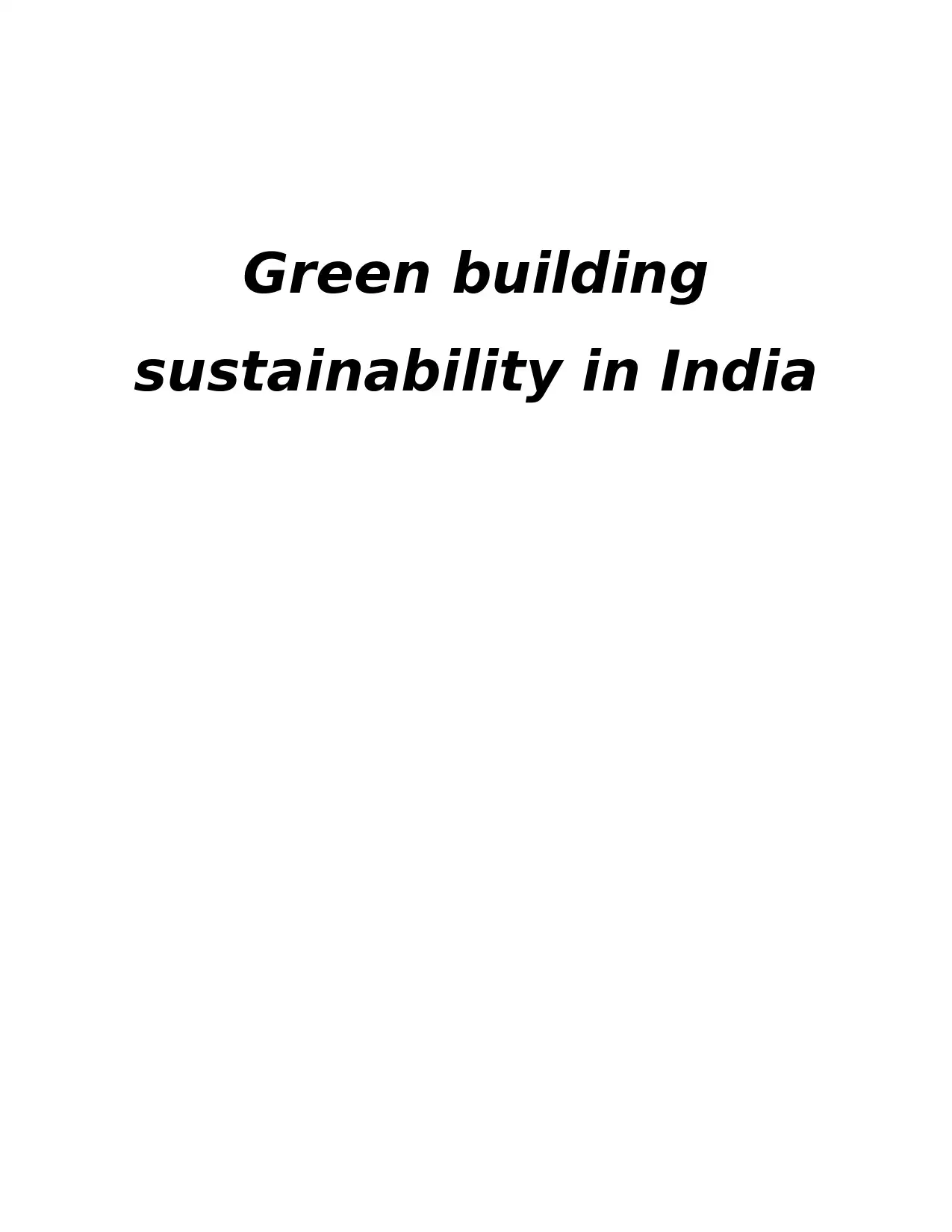
Green building
sustainability in India
sustainability in India
Secure Best Marks with AI Grader
Need help grading? Try our AI Grader for instant feedback on your assignments.

Acknowledgement
First of all I would like to thanks my professors who gave me opportunity to conduct this
research. They guided me on how to develop aims and objectives. I would also like to thank my
parents who supported and helped me in this project. I also thank my friends and relative who
was there for me whenever I needed their support.
First of all I would like to thanks my professors who gave me opportunity to conduct this
research. They guided me on how to develop aims and objectives. I would also like to thank my
parents who supported and helped me in this project. I also thank my friends and relative who
was there for me whenever I needed their support.
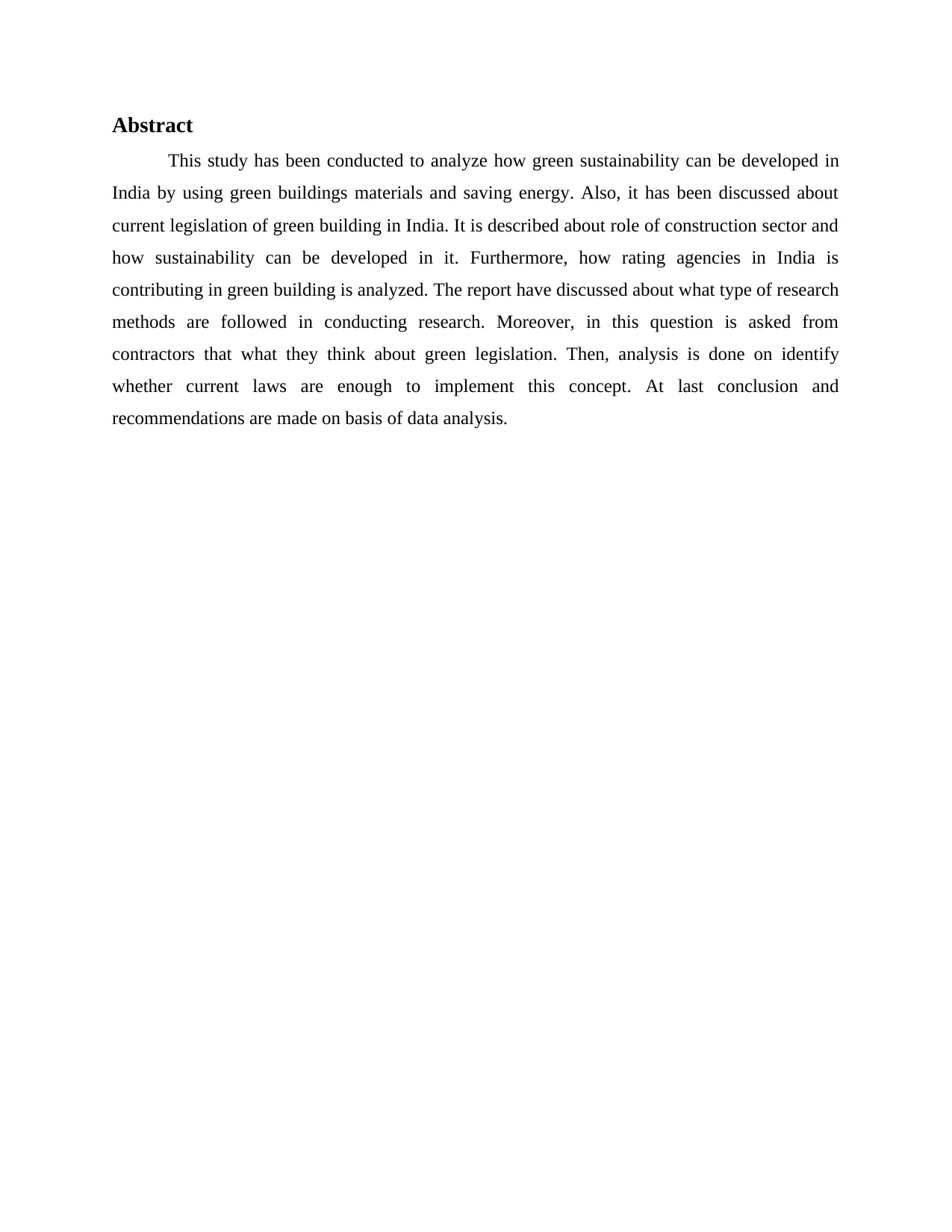
Abstract
This study has been conducted to analyze how green sustainability can be developed in
India by using green buildings materials and saving energy. Also, it has been discussed about
current legislation of green building in India. It is described about role of construction sector and
how sustainability can be developed in it. Furthermore, how rating agencies in India is
contributing in green building is analyzed. The report have discussed about what type of research
methods are followed in conducting research. Moreover, in this question is asked from
contractors that what they think about green legislation. Then, analysis is done on identify
whether current laws are enough to implement this concept. At last conclusion and
recommendations are made on basis of data analysis.
This study has been conducted to analyze how green sustainability can be developed in
India by using green buildings materials and saving energy. Also, it has been discussed about
current legislation of green building in India. It is described about role of construction sector and
how sustainability can be developed in it. Furthermore, how rating agencies in India is
contributing in green building is analyzed. The report have discussed about what type of research
methods are followed in conducting research. Moreover, in this question is asked from
contractors that what they think about green legislation. Then, analysis is done on identify
whether current laws are enough to implement this concept. At last conclusion and
recommendations are made on basis of data analysis.
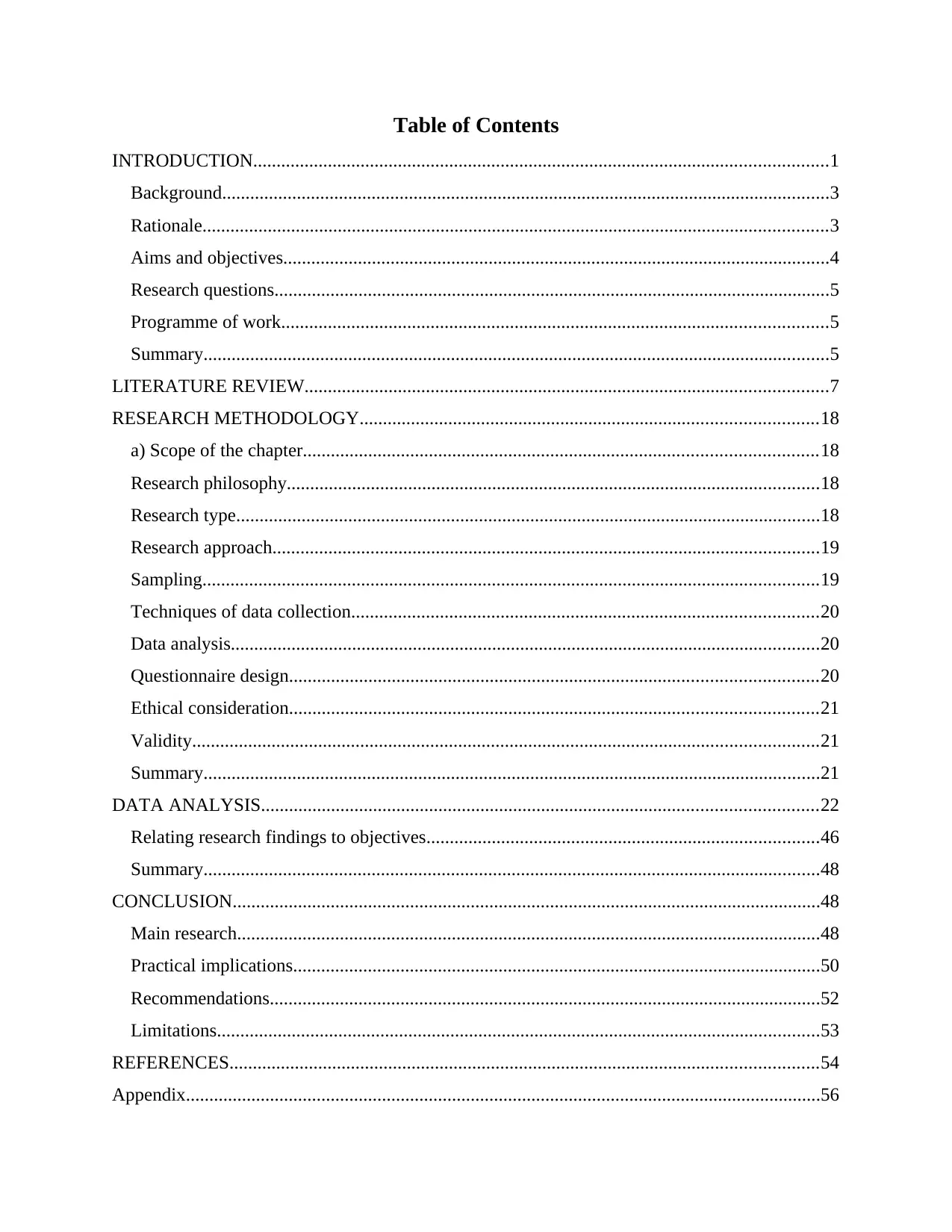
Table of Contents
INTRODUCTION...........................................................................................................................1
Background..................................................................................................................................3
Rationale......................................................................................................................................3
Aims and objectives.....................................................................................................................4
Research questions.......................................................................................................................5
Programme of work.....................................................................................................................5
Summary......................................................................................................................................5
LITERATURE REVIEW................................................................................................................7
RESEARCH METHODOLOGY..................................................................................................18
a) Scope of the chapter..............................................................................................................18
Research philosophy..................................................................................................................18
Research type.............................................................................................................................18
Research approach.....................................................................................................................19
Sampling....................................................................................................................................19
Techniques of data collection....................................................................................................20
Data analysis..............................................................................................................................20
Questionnaire design.................................................................................................................20
Ethical consideration.................................................................................................................21
Validity......................................................................................................................................21
Summary....................................................................................................................................21
DATA ANALYSIS.......................................................................................................................22
Relating research findings to objectives....................................................................................46
Summary....................................................................................................................................48
CONCLUSION..............................................................................................................................48
Main research.............................................................................................................................48
Practical implications.................................................................................................................50
Recommendations......................................................................................................................52
Limitations.................................................................................................................................53
REFERENCES..............................................................................................................................54
Appendix........................................................................................................................................56
INTRODUCTION...........................................................................................................................1
Background..................................................................................................................................3
Rationale......................................................................................................................................3
Aims and objectives.....................................................................................................................4
Research questions.......................................................................................................................5
Programme of work.....................................................................................................................5
Summary......................................................................................................................................5
LITERATURE REVIEW................................................................................................................7
RESEARCH METHODOLOGY..................................................................................................18
a) Scope of the chapter..............................................................................................................18
Research philosophy..................................................................................................................18
Research type.............................................................................................................................18
Research approach.....................................................................................................................19
Sampling....................................................................................................................................19
Techniques of data collection....................................................................................................20
Data analysis..............................................................................................................................20
Questionnaire design.................................................................................................................20
Ethical consideration.................................................................................................................21
Validity......................................................................................................................................21
Summary....................................................................................................................................21
DATA ANALYSIS.......................................................................................................................22
Relating research findings to objectives....................................................................................46
Summary....................................................................................................................................48
CONCLUSION..............................................................................................................................48
Main research.............................................................................................................................48
Practical implications.................................................................................................................50
Recommendations......................................................................................................................52
Limitations.................................................................................................................................53
REFERENCES..............................................................................................................................54
Appendix........................................................................................................................................56
Secure Best Marks with AI Grader
Need help grading? Try our AI Grader for instant feedback on your assignments.

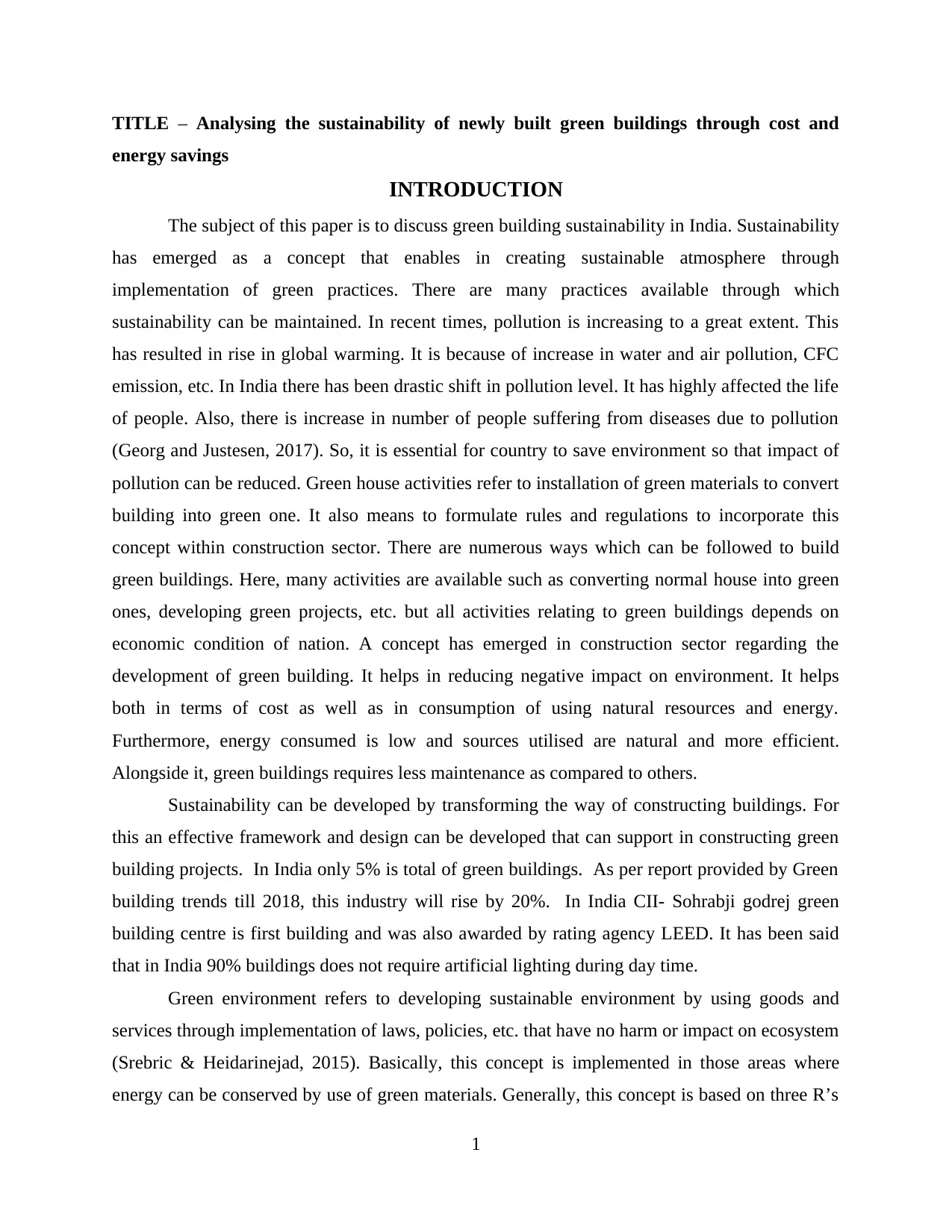
TITLE – Analysing the sustainability of newly built green buildings through cost and
energy savings
INTRODUCTION
The subject of this paper is to discuss green building sustainability in India. Sustainability
has emerged as a concept that enables in creating sustainable atmosphere through
implementation of green practices. There are many practices available through which
sustainability can be maintained. In recent times, pollution is increasing to a great extent. This
has resulted in rise in global warming. It is because of increase in water and air pollution, CFC
emission, etc. In India there has been drastic shift in pollution level. It has highly affected the life
of people. Also, there is increase in number of people suffering from diseases due to pollution
(Georg and Justesen, 2017). So, it is essential for country to save environment so that impact of
pollution can be reduced. Green house activities refer to installation of green materials to convert
building into green one. It also means to formulate rules and regulations to incorporate this
concept within construction sector. There are numerous ways which can be followed to build
green buildings. Here, many activities are available such as converting normal house into green
ones, developing green projects, etc. but all activities relating to green buildings depends on
economic condition of nation. A concept has emerged in construction sector regarding the
development of green building. It helps in reducing negative impact on environment. It helps
both in terms of cost as well as in consumption of using natural resources and energy.
Furthermore, energy consumed is low and sources utilised are natural and more efficient.
Alongside it, green buildings requires less maintenance as compared to others.
Sustainability can be developed by transforming the way of constructing buildings. For
this an effective framework and design can be developed that can support in constructing green
building projects. In India only 5% is total of green buildings. As per report provided by Green
building trends till 2018, this industry will rise by 20%. In India CII- Sohrabji godrej green
building centre is first building and was also awarded by rating agency LEED. It has been said
that in India 90% buildings does not require artificial lighting during day time.
Green environment refers to developing sustainable environment by using goods and
services through implementation of laws, policies, etc. that have no harm or impact on ecosystem
(Srebric & Heidarinejad, 2015). Basically, this concept is implemented in those areas where
energy can be conserved by use of green materials. Generally, this concept is based on three R’s
1
energy savings
INTRODUCTION
The subject of this paper is to discuss green building sustainability in India. Sustainability
has emerged as a concept that enables in creating sustainable atmosphere through
implementation of green practices. There are many practices available through which
sustainability can be maintained. In recent times, pollution is increasing to a great extent. This
has resulted in rise in global warming. It is because of increase in water and air pollution, CFC
emission, etc. In India there has been drastic shift in pollution level. It has highly affected the life
of people. Also, there is increase in number of people suffering from diseases due to pollution
(Georg and Justesen, 2017). So, it is essential for country to save environment so that impact of
pollution can be reduced. Green house activities refer to installation of green materials to convert
building into green one. It also means to formulate rules and regulations to incorporate this
concept within construction sector. There are numerous ways which can be followed to build
green buildings. Here, many activities are available such as converting normal house into green
ones, developing green projects, etc. but all activities relating to green buildings depends on
economic condition of nation. A concept has emerged in construction sector regarding the
development of green building. It helps in reducing negative impact on environment. It helps
both in terms of cost as well as in consumption of using natural resources and energy.
Furthermore, energy consumed is low and sources utilised are natural and more efficient.
Alongside it, green buildings requires less maintenance as compared to others.
Sustainability can be developed by transforming the way of constructing buildings. For
this an effective framework and design can be developed that can support in constructing green
building projects. In India only 5% is total of green buildings. As per report provided by Green
building trends till 2018, this industry will rise by 20%. In India CII- Sohrabji godrej green
building centre is first building and was also awarded by rating agency LEED. It has been said
that in India 90% buildings does not require artificial lighting during day time.
Green environment refers to developing sustainable environment by using goods and
services through implementation of laws, policies, etc. that have no harm or impact on ecosystem
(Srebric & Heidarinejad, 2015). Basically, this concept is implemented in those areas where
energy can be conserved by use of green materials. Generally, this concept is based on three R’s
1
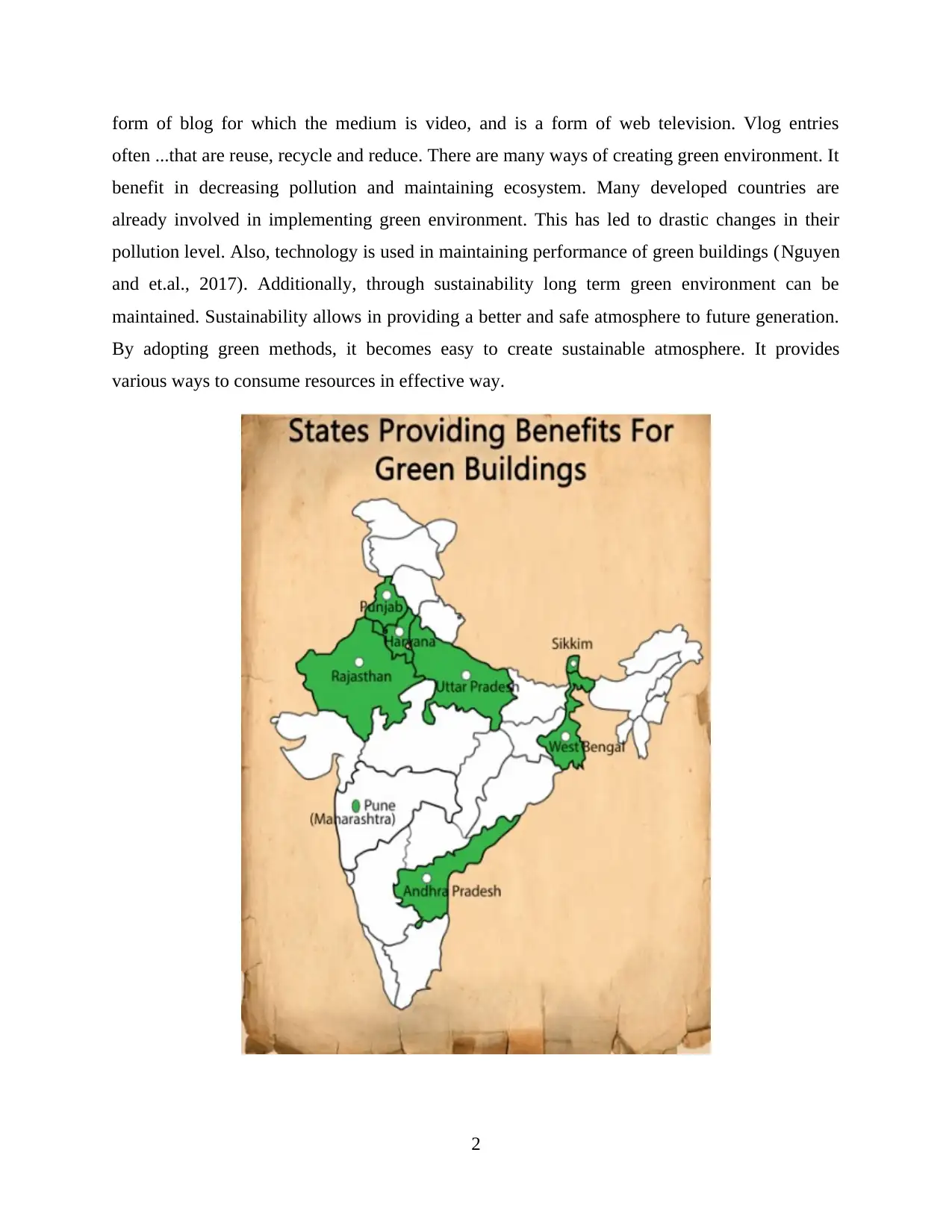
form of blog for which the medium is video, and is a form of web television. Vlog entries
often ...that are reuse, recycle and reduce. There are many ways of creating green environment. It
benefit in decreasing pollution and maintaining ecosystem. Many developed countries are
already involved in implementing green environment. This has led to drastic changes in their
pollution level. Also, technology is used in maintaining performance of green buildings (Nguyen
and et.al., 2017). Additionally, through sustainability long term green environment can be
maintained. Sustainability allows in providing a better and safe atmosphere to future generation.
By adopting green methods, it becomes easy to create sustainable atmosphere. It provides
various ways to consume resources in effective way.
2
often ...that are reuse, recycle and reduce. There are many ways of creating green environment. It
benefit in decreasing pollution and maintaining ecosystem. Many developed countries are
already involved in implementing green environment. This has led to drastic changes in their
pollution level. Also, technology is used in maintaining performance of green buildings (Nguyen
and et.al., 2017). Additionally, through sustainability long term green environment can be
maintained. Sustainability allows in providing a better and safe atmosphere to future generation.
By adopting green methods, it becomes easy to create sustainable atmosphere. It provides
various ways to consume resources in effective way.
2
Paraphrase This Document
Need a fresh take? Get an instant paraphrase of this document with our AI Paraphraser
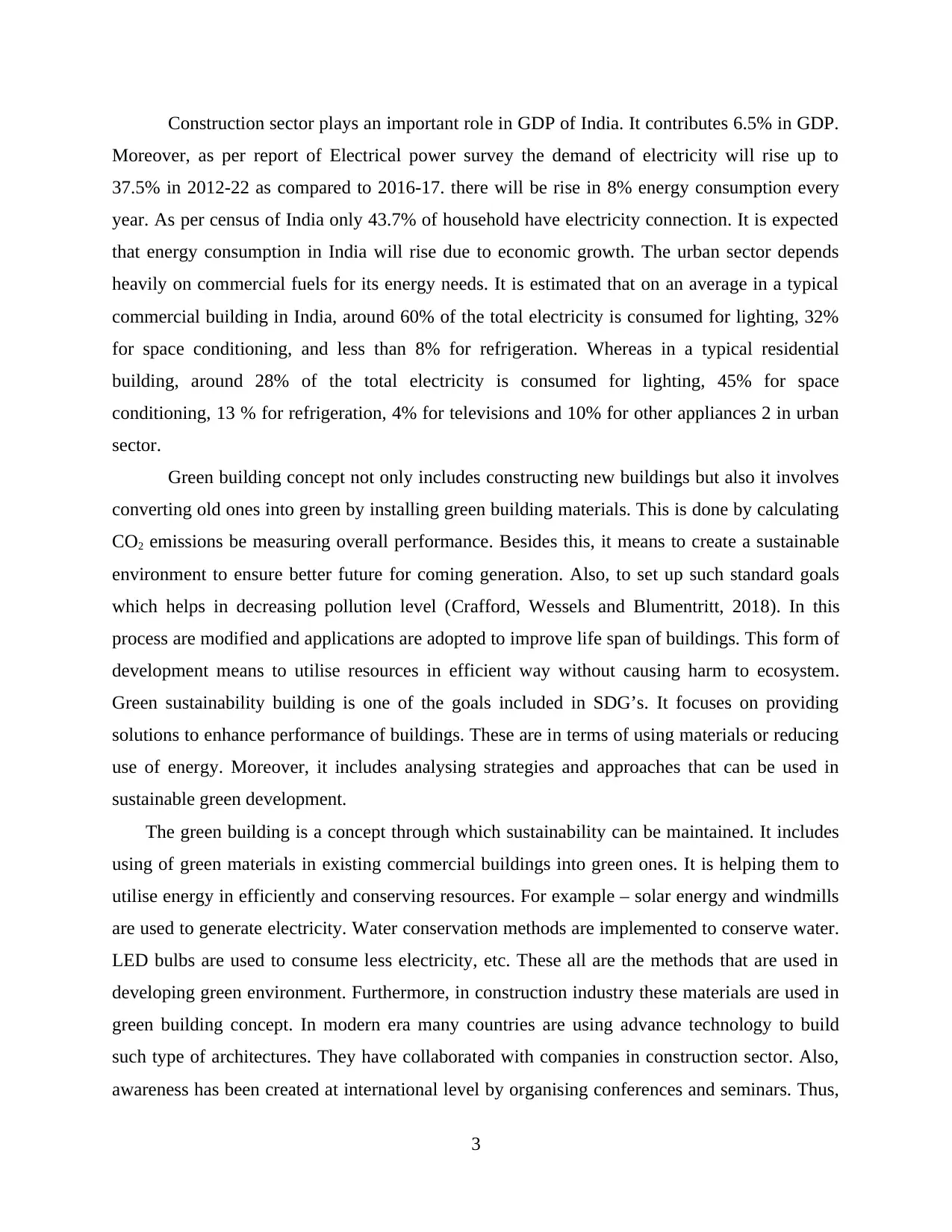
Construction sector plays an important role in GDP of India. It contributes 6.5% in GDP.
Moreover, as per report of Electrical power survey the demand of electricity will rise up to
37.5% in 2012-22 as compared to 2016-17. there will be rise in 8% energy consumption every
year. As per census of India only 43.7% of household have electricity connection. It is expected
that energy consumption in India will rise due to economic growth. The urban sector depends
heavily on commercial fuels for its energy needs. It is estimated that on an average in a typical
commercial building in India, around 60% of the total electricity is consumed for lighting, 32%
for space conditioning, and less than 8% for refrigeration. Whereas in a typical residential
building, around 28% of the total electricity is consumed for lighting, 45% for space
conditioning, 13 % for refrigeration, 4% for televisions and 10% for other appliances 2 in urban
sector.
Green building concept not only includes constructing new buildings but also it involves
converting old ones into green by installing green building materials. This is done by calculating
CO2 emissions be measuring overall performance. Besides this, it means to create a sustainable
environment to ensure better future for coming generation. Also, to set up such standard goals
which helps in decreasing pollution level (Crafford, Wessels and Blumentritt, 2018). In this
process are modified and applications are adopted to improve life span of buildings. This form of
development means to utilise resources in efficient way without causing harm to ecosystem.
Green sustainability building is one of the goals included in SDG’s. It focuses on providing
solutions to enhance performance of buildings. These are in terms of using materials or reducing
use of energy. Moreover, it includes analysing strategies and approaches that can be used in
sustainable green development.
The green building is a concept through which sustainability can be maintained. It includes
using of green materials in existing commercial buildings into green ones. It is helping them to
utilise energy in efficiently and conserving resources. For example – solar energy and windmills
are used to generate electricity. Water conservation methods are implemented to conserve water.
LED bulbs are used to consume less electricity, etc. These all are the methods that are used in
developing green environment. Furthermore, in construction industry these materials are used in
green building concept. In modern era many countries are using advance technology to build
such type of architectures. They have collaborated with companies in construction sector. Also,
awareness has been created at international level by organising conferences and seminars. Thus,
3
Moreover, as per report of Electrical power survey the demand of electricity will rise up to
37.5% in 2012-22 as compared to 2016-17. there will be rise in 8% energy consumption every
year. As per census of India only 43.7% of household have electricity connection. It is expected
that energy consumption in India will rise due to economic growth. The urban sector depends
heavily on commercial fuels for its energy needs. It is estimated that on an average in a typical
commercial building in India, around 60% of the total electricity is consumed for lighting, 32%
for space conditioning, and less than 8% for refrigeration. Whereas in a typical residential
building, around 28% of the total electricity is consumed for lighting, 45% for space
conditioning, 13 % for refrigeration, 4% for televisions and 10% for other appliances 2 in urban
sector.
Green building concept not only includes constructing new buildings but also it involves
converting old ones into green by installing green building materials. This is done by calculating
CO2 emissions be measuring overall performance. Besides this, it means to create a sustainable
environment to ensure better future for coming generation. Also, to set up such standard goals
which helps in decreasing pollution level (Crafford, Wessels and Blumentritt, 2018). In this
process are modified and applications are adopted to improve life span of buildings. This form of
development means to utilise resources in efficient way without causing harm to ecosystem.
Green sustainability building is one of the goals included in SDG’s. It focuses on providing
solutions to enhance performance of buildings. These are in terms of using materials or reducing
use of energy. Moreover, it includes analysing strategies and approaches that can be used in
sustainable green development.
The green building is a concept through which sustainability can be maintained. It includes
using of green materials in existing commercial buildings into green ones. It is helping them to
utilise energy in efficiently and conserving resources. For example – solar energy and windmills
are used to generate electricity. Water conservation methods are implemented to conserve water.
LED bulbs are used to consume less electricity, etc. These all are the methods that are used in
developing green environment. Furthermore, in construction industry these materials are used in
green building concept. In modern era many countries are using advance technology to build
such type of architectures. They have collaborated with companies in construction sector. Also,
awareness has been created at international level by organising conferences and seminars. Thus,
3
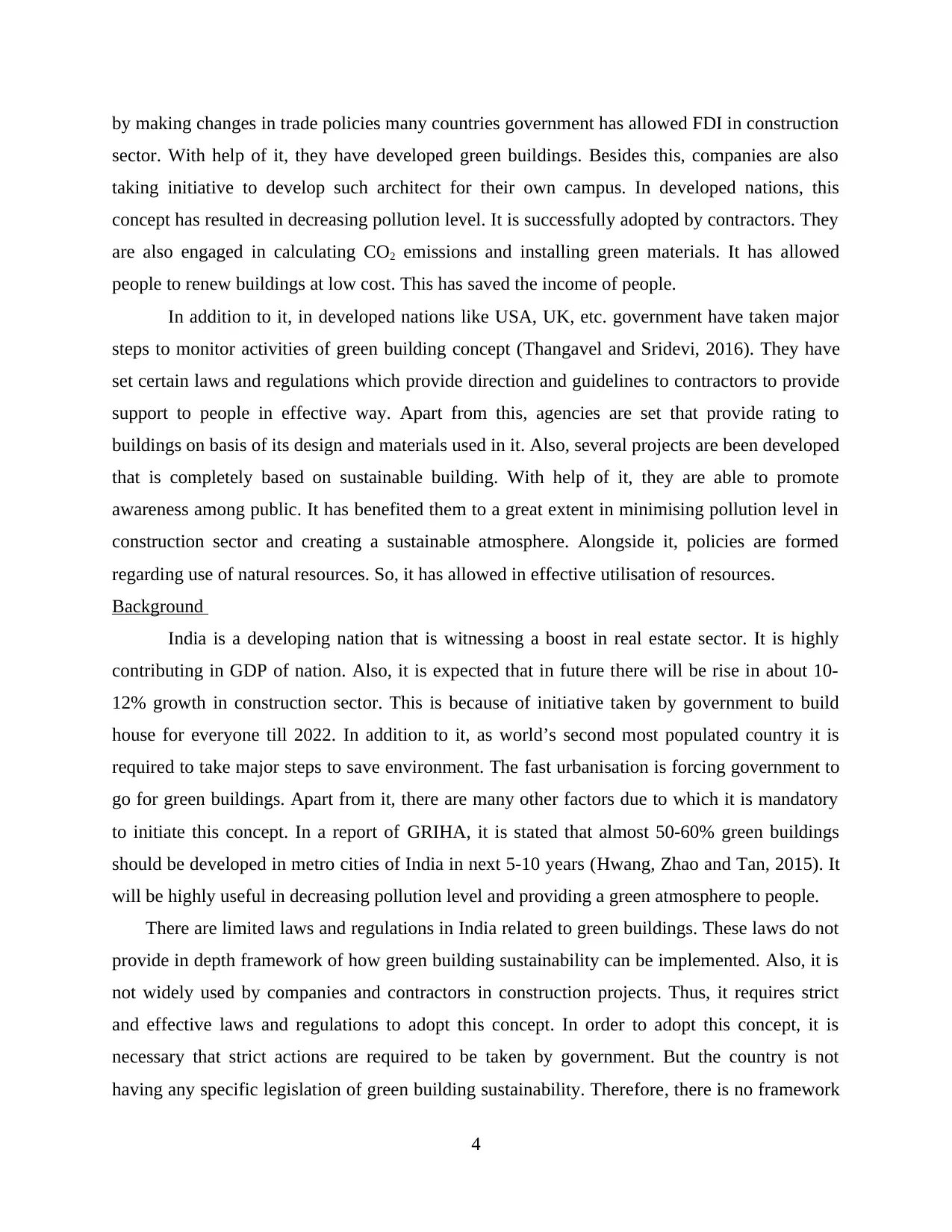
by making changes in trade policies many countries government has allowed FDI in construction
sector. With help of it, they have developed green buildings. Besides this, companies are also
taking initiative to develop such architect for their own campus. In developed nations, this
concept has resulted in decreasing pollution level. It is successfully adopted by contractors. They
are also engaged in calculating CO2 emissions and installing green materials. It has allowed
people to renew buildings at low cost. This has saved the income of people.
In addition to it, in developed nations like USA, UK, etc. government have taken major
steps to monitor activities of green building concept (Thangavel and Sridevi, 2016). They have
set certain laws and regulations which provide direction and guidelines to contractors to provide
support to people in effective way. Apart from this, agencies are set that provide rating to
buildings on basis of its design and materials used in it. Also, several projects are been developed
that is completely based on sustainable building. With help of it, they are able to promote
awareness among public. It has benefited them to a great extent in minimising pollution level in
construction sector and creating a sustainable atmosphere. Alongside it, policies are formed
regarding use of natural resources. So, it has allowed in effective utilisation of resources.
Background
India is a developing nation that is witnessing a boost in real estate sector. It is highly
contributing in GDP of nation. Also, it is expected that in future there will be rise in about 10-
12% growth in construction sector. This is because of initiative taken by government to build
house for everyone till 2022. In addition to it, as world’s second most populated country it is
required to take major steps to save environment. The fast urbanisation is forcing government to
go for green buildings. Apart from it, there are many other factors due to which it is mandatory
to initiate this concept. In a report of GRIHA, it is stated that almost 50-60% green buildings
should be developed in metro cities of India in next 5-10 years (Hwang, Zhao and Tan, 2015). It
will be highly useful in decreasing pollution level and providing a green atmosphere to people.
There are limited laws and regulations in India related to green buildings. These laws do not
provide in depth framework of how green building sustainability can be implemented. Also, it is
not widely used by companies and contractors in construction projects. Thus, it requires strict
and effective laws and regulations to adopt this concept. In order to adopt this concept, it is
necessary that strict actions are required to be taken by government. But the country is not
having any specific legislation of green building sustainability. Therefore, there is no framework
4
sector. With help of it, they have developed green buildings. Besides this, companies are also
taking initiative to develop such architect for their own campus. In developed nations, this
concept has resulted in decreasing pollution level. It is successfully adopted by contractors. They
are also engaged in calculating CO2 emissions and installing green materials. It has allowed
people to renew buildings at low cost. This has saved the income of people.
In addition to it, in developed nations like USA, UK, etc. government have taken major
steps to monitor activities of green building concept (Thangavel and Sridevi, 2016). They have
set certain laws and regulations which provide direction and guidelines to contractors to provide
support to people in effective way. Apart from this, agencies are set that provide rating to
buildings on basis of its design and materials used in it. Also, several projects are been developed
that is completely based on sustainable building. With help of it, they are able to promote
awareness among public. It has benefited them to a great extent in minimising pollution level in
construction sector and creating a sustainable atmosphere. Alongside it, policies are formed
regarding use of natural resources. So, it has allowed in effective utilisation of resources.
Background
India is a developing nation that is witnessing a boost in real estate sector. It is highly
contributing in GDP of nation. Also, it is expected that in future there will be rise in about 10-
12% growth in construction sector. This is because of initiative taken by government to build
house for everyone till 2022. In addition to it, as world’s second most populated country it is
required to take major steps to save environment. The fast urbanisation is forcing government to
go for green buildings. Apart from it, there are many other factors due to which it is mandatory
to initiate this concept. In a report of GRIHA, it is stated that almost 50-60% green buildings
should be developed in metro cities of India in next 5-10 years (Hwang, Zhao and Tan, 2015). It
will be highly useful in decreasing pollution level and providing a green atmosphere to people.
There are limited laws and regulations in India related to green buildings. These laws do not
provide in depth framework of how green building sustainability can be implemented. Also, it is
not widely used by companies and contractors in construction projects. Thus, it requires strict
and effective laws and regulations to adopt this concept. In order to adopt this concept, it is
necessary that strict actions are required to be taken by government. But the country is not
having any specific legislation of green building sustainability. Therefore, there is no framework
4
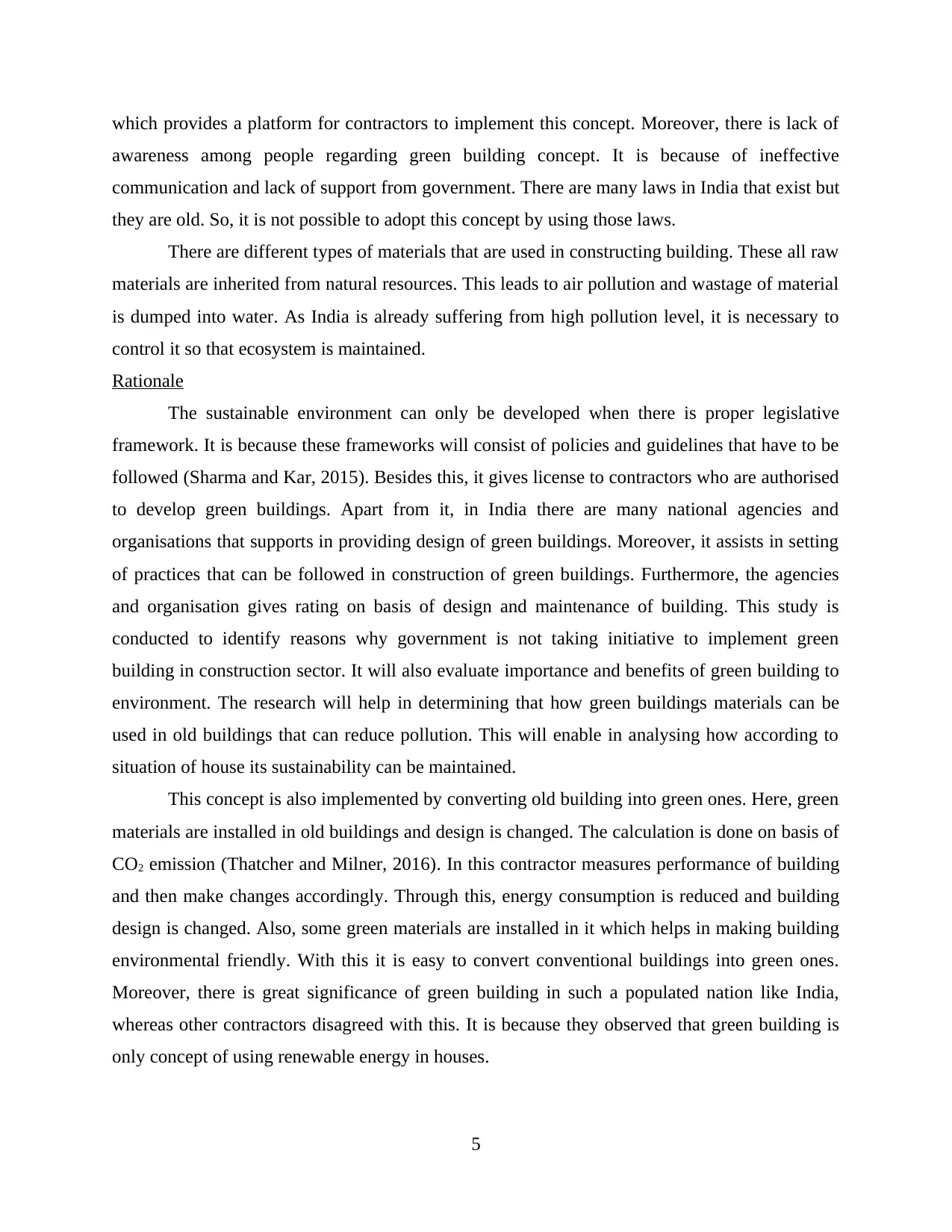
which provides a platform for contractors to implement this concept. Moreover, there is lack of
awareness among people regarding green building concept. It is because of ineffective
communication and lack of support from government. There are many laws in India that exist but
they are old. So, it is not possible to adopt this concept by using those laws.
There are different types of materials that are used in constructing building. These all raw
materials are inherited from natural resources. This leads to air pollution and wastage of material
is dumped into water. As India is already suffering from high pollution level, it is necessary to
control it so that ecosystem is maintained.
Rationale
The sustainable environment can only be developed when there is proper legislative
framework. It is because these frameworks will consist of policies and guidelines that have to be
followed (Sharma and Kar, 2015). Besides this, it gives license to contractors who are authorised
to develop green buildings. Apart from it, in India there are many national agencies and
organisations that supports in providing design of green buildings. Moreover, it assists in setting
of practices that can be followed in construction of green buildings. Furthermore, the agencies
and organisation gives rating on basis of design and maintenance of building. This study is
conducted to identify reasons why government is not taking initiative to implement green
building in construction sector. It will also evaluate importance and benefits of green building to
environment. The research will help in determining that how green buildings materials can be
used in old buildings that can reduce pollution. This will enable in analysing how according to
situation of house its sustainability can be maintained.
This concept is also implemented by converting old building into green ones. Here, green
materials are installed in old buildings and design is changed. The calculation is done on basis of
CO2 emission (Thatcher and Milner, 2016). In this contractor measures performance of building
and then make changes accordingly. Through this, energy consumption is reduced and building
design is changed. Also, some green materials are installed in it which helps in making building
environmental friendly. With this it is easy to convert conventional buildings into green ones.
Moreover, there is great significance of green building in such a populated nation like India,
whereas other contractors disagreed with this. It is because they observed that green building is
only concept of using renewable energy in houses.
5
awareness among people regarding green building concept. It is because of ineffective
communication and lack of support from government. There are many laws in India that exist but
they are old. So, it is not possible to adopt this concept by using those laws.
There are different types of materials that are used in constructing building. These all raw
materials are inherited from natural resources. This leads to air pollution and wastage of material
is dumped into water. As India is already suffering from high pollution level, it is necessary to
control it so that ecosystem is maintained.
Rationale
The sustainable environment can only be developed when there is proper legislative
framework. It is because these frameworks will consist of policies and guidelines that have to be
followed (Sharma and Kar, 2015). Besides this, it gives license to contractors who are authorised
to develop green buildings. Apart from it, in India there are many national agencies and
organisations that supports in providing design of green buildings. Moreover, it assists in setting
of practices that can be followed in construction of green buildings. Furthermore, the agencies
and organisation gives rating on basis of design and maintenance of building. This study is
conducted to identify reasons why government is not taking initiative to implement green
building in construction sector. It will also evaluate importance and benefits of green building to
environment. The research will help in determining that how green buildings materials can be
used in old buildings that can reduce pollution. This will enable in analysing how according to
situation of house its sustainability can be maintained.
This concept is also implemented by converting old building into green ones. Here, green
materials are installed in old buildings and design is changed. The calculation is done on basis of
CO2 emission (Thatcher and Milner, 2016). In this contractor measures performance of building
and then make changes accordingly. Through this, energy consumption is reduced and building
design is changed. Also, some green materials are installed in it which helps in making building
environmental friendly. With this it is easy to convert conventional buildings into green ones.
Moreover, there is great significance of green building in such a populated nation like India,
whereas other contractors disagreed with this. It is because they observed that green building is
only concept of using renewable energy in houses.
5
Secure Best Marks with AI Grader
Need help grading? Try our AI Grader for instant feedback on your assignments.
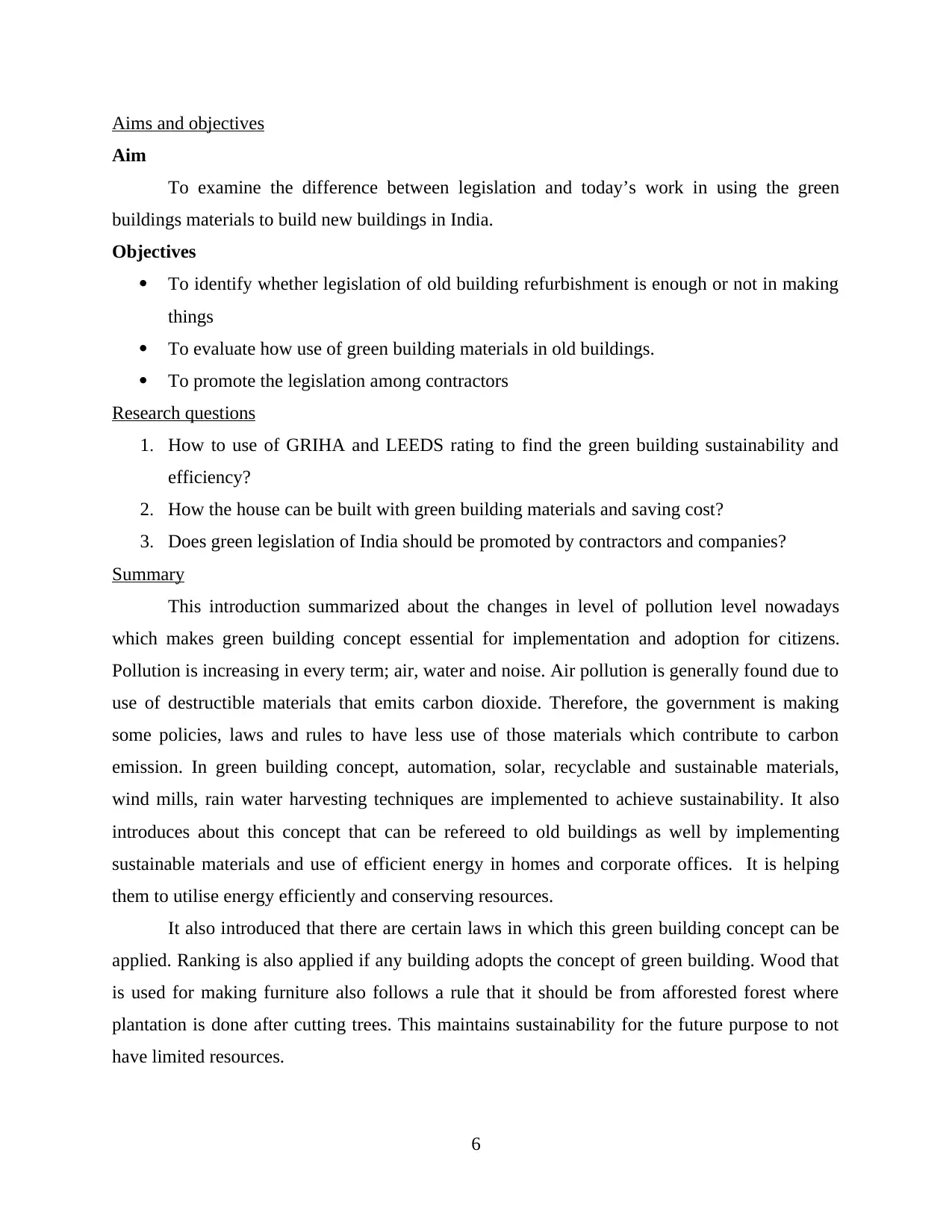
Aims and objectives
Aim
To examine the difference between legislation and today’s work in using the green
buildings materials to build new buildings in India.
Objectives
To identify whether legislation of old building refurbishment is enough or not in making
things
To evaluate how use of green building materials in old buildings.
To promote the legislation among contractors
Research questions
1. How to use of GRIHA and LEEDS rating to find the green building sustainability and
efficiency?
2. How the house can be built with green building materials and saving cost?
3. Does green legislation of India should be promoted by contractors and companies?
Summary
This introduction summarized about the changes in level of pollution level nowadays
which makes green building concept essential for implementation and adoption for citizens.
Pollution is increasing in every term; air, water and noise. Air pollution is generally found due to
use of destructible materials that emits carbon dioxide. Therefore, the government is making
some policies, laws and rules to have less use of those materials which contribute to carbon
emission. In green building concept, automation, solar, recyclable and sustainable materials,
wind mills, rain water harvesting techniques are implemented to achieve sustainability. It also
introduces about this concept that can be refereed to old buildings as well by implementing
sustainable materials and use of efficient energy in homes and corporate offices. It is helping
them to utilise energy efficiently and conserving resources.
It also introduced that there are certain laws in which this green building concept can be
applied. Ranking is also applied if any building adopts the concept of green building. Wood that
is used for making furniture also follows a rule that it should be from afforested forest where
plantation is done after cutting trees. This maintains sustainability for the future purpose to not
have limited resources.
6
Aim
To examine the difference between legislation and today’s work in using the green
buildings materials to build new buildings in India.
Objectives
To identify whether legislation of old building refurbishment is enough or not in making
things
To evaluate how use of green building materials in old buildings.
To promote the legislation among contractors
Research questions
1. How to use of GRIHA and LEEDS rating to find the green building sustainability and
efficiency?
2. How the house can be built with green building materials and saving cost?
3. Does green legislation of India should be promoted by contractors and companies?
Summary
This introduction summarized about the changes in level of pollution level nowadays
which makes green building concept essential for implementation and adoption for citizens.
Pollution is increasing in every term; air, water and noise. Air pollution is generally found due to
use of destructible materials that emits carbon dioxide. Therefore, the government is making
some policies, laws and rules to have less use of those materials which contribute to carbon
emission. In green building concept, automation, solar, recyclable and sustainable materials,
wind mills, rain water harvesting techniques are implemented to achieve sustainability. It also
introduces about this concept that can be refereed to old buildings as well by implementing
sustainable materials and use of efficient energy in homes and corporate offices. It is helping
them to utilise energy efficiently and conserving resources.
It also introduced that there are certain laws in which this green building concept can be
applied. Ranking is also applied if any building adopts the concept of green building. Wood that
is used for making furniture also follows a rule that it should be from afforested forest where
plantation is done after cutting trees. This maintains sustainability for the future purpose to not
have limited resources.
6

7
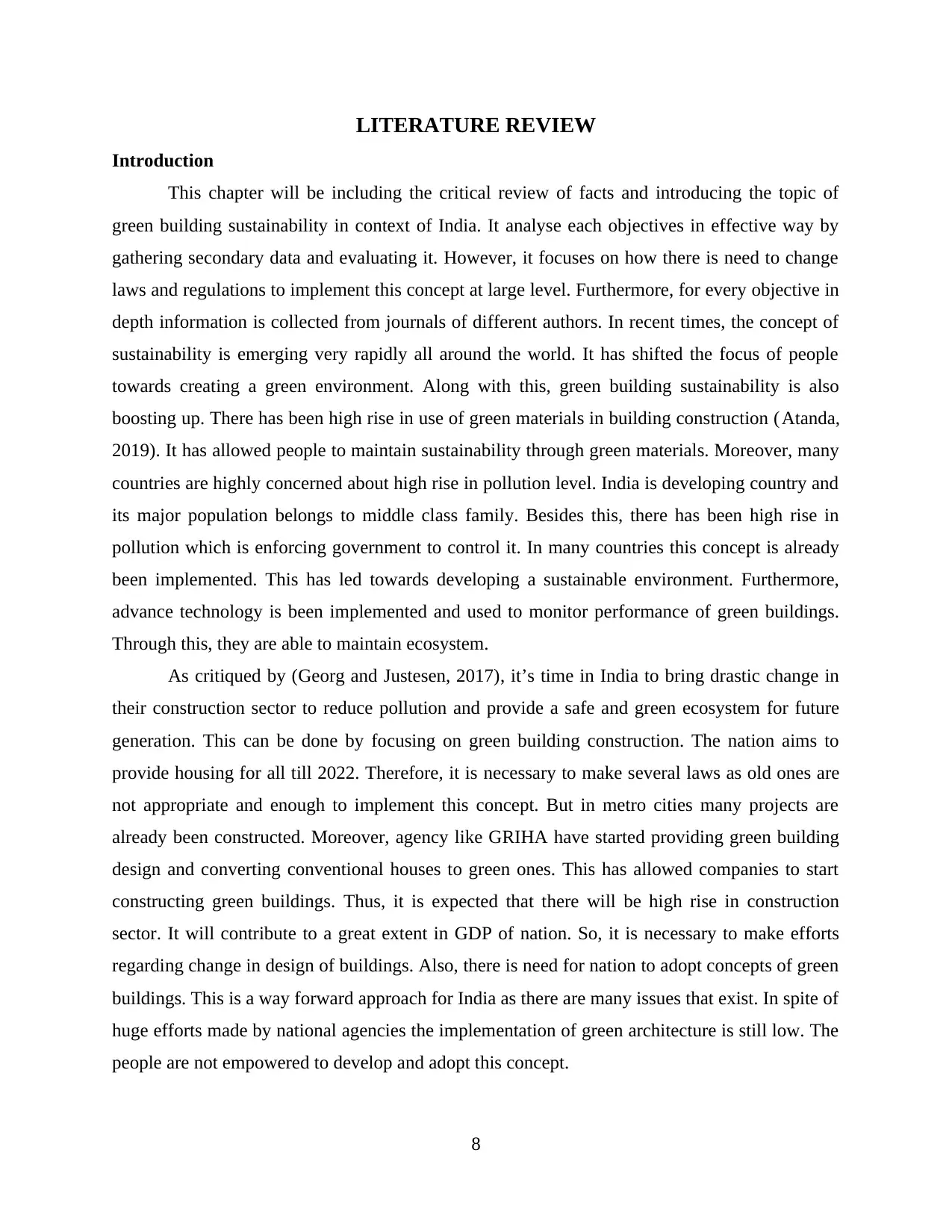
LITERATURE REVIEW
Introduction
This chapter will be including the critical review of facts and introducing the topic of
green building sustainability in context of India. It analyse each objectives in effective way by
gathering secondary data and evaluating it. However, it focuses on how there is need to change
laws and regulations to implement this concept at large level. Furthermore, for every objective in
depth information is collected from journals of different authors. In recent times, the concept of
sustainability is emerging very rapidly all around the world. It has shifted the focus of people
towards creating a green environment. Along with this, green building sustainability is also
boosting up. There has been high rise in use of green materials in building construction (Atanda,
2019). It has allowed people to maintain sustainability through green materials. Moreover, many
countries are highly concerned about high rise in pollution level. India is developing country and
its major population belongs to middle class family. Besides this, there has been high rise in
pollution which is enforcing government to control it. In many countries this concept is already
been implemented. This has led towards developing a sustainable environment. Furthermore,
advance technology is been implemented and used to monitor performance of green buildings.
Through this, they are able to maintain ecosystem.
As critiqued by (Georg and Justesen, 2017), it’s time in India to bring drastic change in
their construction sector to reduce pollution and provide a safe and green ecosystem for future
generation. This can be done by focusing on green building construction. The nation aims to
provide housing for all till 2022. Therefore, it is necessary to make several laws as old ones are
not appropriate and enough to implement this concept. But in metro cities many projects are
already been constructed. Moreover, agency like GRIHA have started providing green building
design and converting conventional houses to green ones. This has allowed companies to start
constructing green buildings. Thus, it is expected that there will be high rise in construction
sector. It will contribute to a great extent in GDP of nation. So, it is necessary to make efforts
regarding change in design of buildings. Also, there is need for nation to adopt concepts of green
buildings. This is a way forward approach for India as there are many issues that exist. In spite of
huge efforts made by national agencies the implementation of green architecture is still low. The
people are not empowered to develop and adopt this concept.
8
Introduction
This chapter will be including the critical review of facts and introducing the topic of
green building sustainability in context of India. It analyse each objectives in effective way by
gathering secondary data and evaluating it. However, it focuses on how there is need to change
laws and regulations to implement this concept at large level. Furthermore, for every objective in
depth information is collected from journals of different authors. In recent times, the concept of
sustainability is emerging very rapidly all around the world. It has shifted the focus of people
towards creating a green environment. Along with this, green building sustainability is also
boosting up. There has been high rise in use of green materials in building construction (Atanda,
2019). It has allowed people to maintain sustainability through green materials. Moreover, many
countries are highly concerned about high rise in pollution level. India is developing country and
its major population belongs to middle class family. Besides this, there has been high rise in
pollution which is enforcing government to control it. In many countries this concept is already
been implemented. This has led towards developing a sustainable environment. Furthermore,
advance technology is been implemented and used to monitor performance of green buildings.
Through this, they are able to maintain ecosystem.
As critiqued by (Georg and Justesen, 2017), it’s time in India to bring drastic change in
their construction sector to reduce pollution and provide a safe and green ecosystem for future
generation. This can be done by focusing on green building construction. The nation aims to
provide housing for all till 2022. Therefore, it is necessary to make several laws as old ones are
not appropriate and enough to implement this concept. But in metro cities many projects are
already been constructed. Moreover, agency like GRIHA have started providing green building
design and converting conventional houses to green ones. This has allowed companies to start
constructing green buildings. Thus, it is expected that there will be high rise in construction
sector. It will contribute to a great extent in GDP of nation. So, it is necessary to make efforts
regarding change in design of buildings. Also, there is need for nation to adopt concepts of green
buildings. This is a way forward approach for India as there are many issues that exist. In spite of
huge efforts made by national agencies the implementation of green architecture is still low. The
people are not empowered to develop and adopt this concept.
8
Paraphrase This Document
Need a fresh take? Get an instant paraphrase of this document with our AI Paraphraser
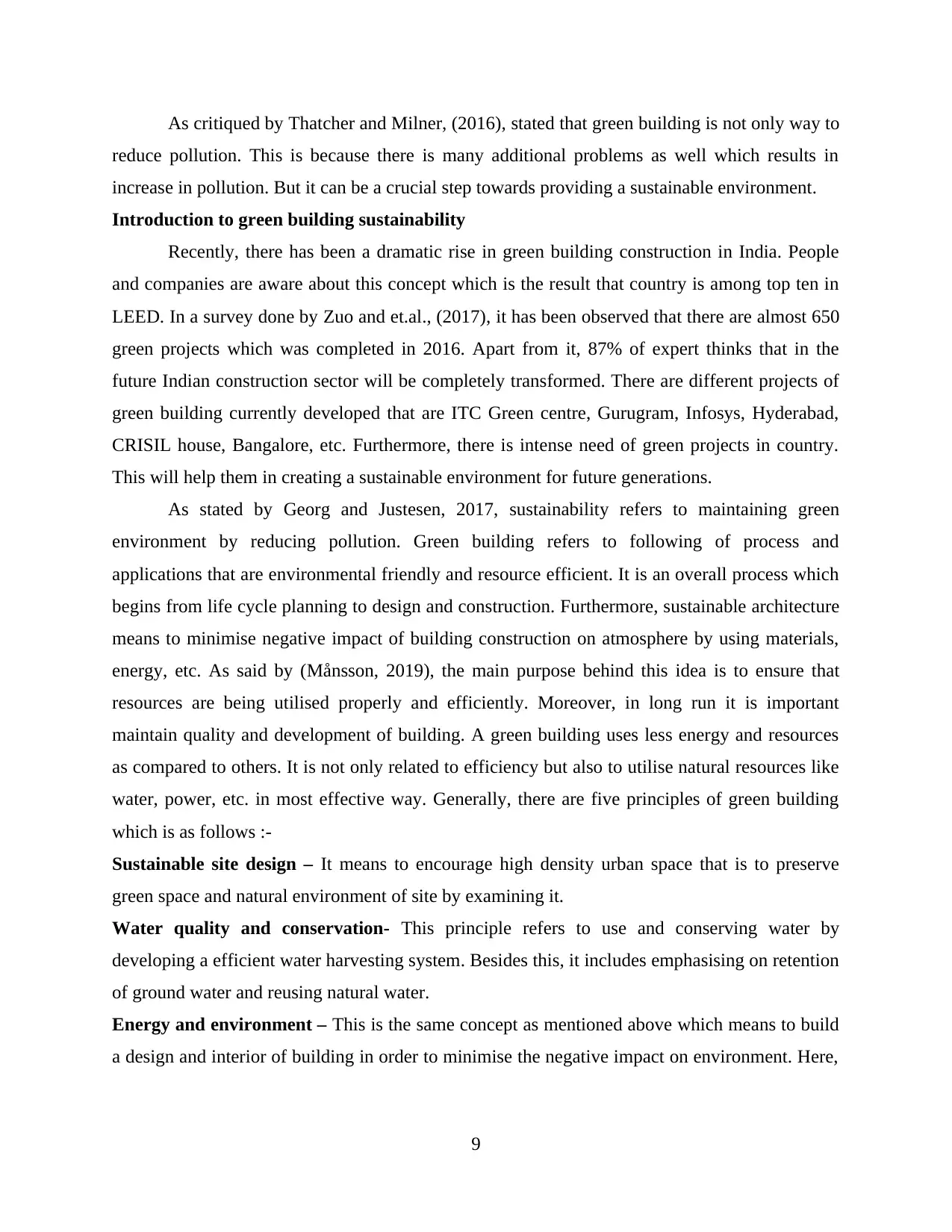
As critiqued by Thatcher and Milner, (2016), stated that green building is not only way to
reduce pollution. This is because there is many additional problems as well which results in
increase in pollution. But it can be a crucial step towards providing a sustainable environment.
Introduction to green building sustainability
Recently, there has been a dramatic rise in green building construction in India. People
and companies are aware about this concept which is the result that country is among top ten in
LEED. In a survey done by Zuo and et.al., (2017), it has been observed that there are almost 650
green projects which was completed in 2016. Apart from it, 87% of expert thinks that in the
future Indian construction sector will be completely transformed. There are different projects of
green building currently developed that are ITC Green centre, Gurugram, Infosys, Hyderabad,
CRISIL house, Bangalore, etc. Furthermore, there is intense need of green projects in country.
This will help them in creating a sustainable environment for future generations.
As stated by Georg and Justesen, 2017, sustainability refers to maintaining green
environment by reducing pollution. Green building refers to following of process and
applications that are environmental friendly and resource efficient. It is an overall process which
begins from life cycle planning to design and construction. Furthermore, sustainable architecture
means to minimise negative impact of building construction on atmosphere by using materials,
energy, etc. As said by (Månsson, 2019), the main purpose behind this idea is to ensure that
resources are being utilised properly and efficiently. Moreover, in long run it is important
maintain quality and development of building. A green building uses less energy and resources
as compared to others. It is not only related to efficiency but also to utilise natural resources like
water, power, etc. in most effective way. Generally, there are five principles of green building
which is as follows :-
Sustainable site design – It means to encourage high density urban space that is to preserve
green space and natural environment of site by examining it.
Water quality and conservation- This principle refers to use and conserving water by
developing a efficient water harvesting system. Besides this, it includes emphasising on retention
of ground water and reusing natural water.
Energy and environment – This is the same concept as mentioned above which means to build
a design and interior of building in order to minimise the negative impact on environment. Here,
9
reduce pollution. This is because there is many additional problems as well which results in
increase in pollution. But it can be a crucial step towards providing a sustainable environment.
Introduction to green building sustainability
Recently, there has been a dramatic rise in green building construction in India. People
and companies are aware about this concept which is the result that country is among top ten in
LEED. In a survey done by Zuo and et.al., (2017), it has been observed that there are almost 650
green projects which was completed in 2016. Apart from it, 87% of expert thinks that in the
future Indian construction sector will be completely transformed. There are different projects of
green building currently developed that are ITC Green centre, Gurugram, Infosys, Hyderabad,
CRISIL house, Bangalore, etc. Furthermore, there is intense need of green projects in country.
This will help them in creating a sustainable environment for future generations.
As stated by Georg and Justesen, 2017, sustainability refers to maintaining green
environment by reducing pollution. Green building refers to following of process and
applications that are environmental friendly and resource efficient. It is an overall process which
begins from life cycle planning to design and construction. Furthermore, sustainable architecture
means to minimise negative impact of building construction on atmosphere by using materials,
energy, etc. As said by (Månsson, 2019), the main purpose behind this idea is to ensure that
resources are being utilised properly and efficiently. Moreover, in long run it is important
maintain quality and development of building. A green building uses less energy and resources
as compared to others. It is not only related to efficiency but also to utilise natural resources like
water, power, etc. in most effective way. Generally, there are five principles of green building
which is as follows :-
Sustainable site design – It means to encourage high density urban space that is to preserve
green space and natural environment of site by examining it.
Water quality and conservation- This principle refers to use and conserving water by
developing a efficient water harvesting system. Besides this, it includes emphasising on retention
of ground water and reusing natural water.
Energy and environment – This is the same concept as mentioned above which means to build
a design and interior of building in order to minimise the negative impact on environment. Here,
9
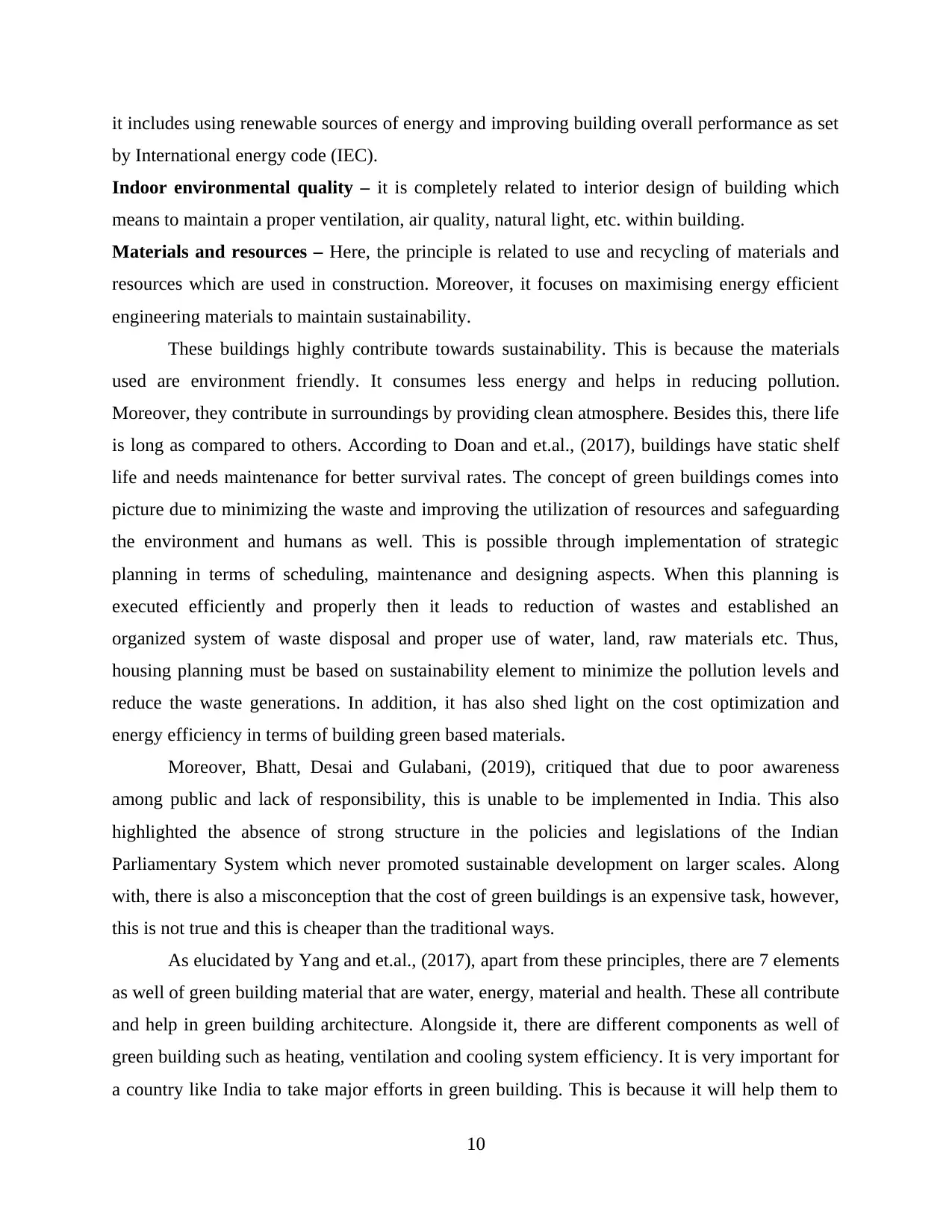
it includes using renewable sources of energy and improving building overall performance as set
by International energy code (IEC).
Indoor environmental quality – it is completely related to interior design of building which
means to maintain a proper ventilation, air quality, natural light, etc. within building.
Materials and resources – Here, the principle is related to use and recycling of materials and
resources which are used in construction. Moreover, it focuses on maximising energy efficient
engineering materials to maintain sustainability.
These buildings highly contribute towards sustainability. This is because the materials
used are environment friendly. It consumes less energy and helps in reducing pollution.
Moreover, they contribute in surroundings by providing clean atmosphere. Besides this, there life
is long as compared to others. According to Doan and et.al., (2017), buildings have static shelf
life and needs maintenance for better survival rates. The concept of green buildings comes into
picture due to minimizing the waste and improving the utilization of resources and safeguarding
the environment and humans as well. This is possible through implementation of strategic
planning in terms of scheduling, maintenance and designing aspects. When this planning is
executed efficiently and properly then it leads to reduction of wastes and established an
organized system of waste disposal and proper use of water, land, raw materials etc. Thus,
housing planning must be based on sustainability element to minimize the pollution levels and
reduce the waste generations. In addition, it has also shed light on the cost optimization and
energy efficiency in terms of building green based materials.
Moreover, Bhatt, Desai and Gulabani, (2019), critiqued that due to poor awareness
among public and lack of responsibility, this is unable to be implemented in India. This also
highlighted the absence of strong structure in the policies and legislations of the Indian
Parliamentary System which never promoted sustainable development on larger scales. Along
with, there is also a misconception that the cost of green buildings is an expensive task, however,
this is not true and this is cheaper than the traditional ways.
As elucidated by Yang and et.al., (2017), apart from these principles, there are 7 elements
as well of green building material that are water, energy, material and health. These all contribute
and help in green building architecture. Alongside it, there are different components as well of
green building such as heating, ventilation and cooling system efficiency. It is very important for
a country like India to take major efforts in green building. This is because it will help them to
10
by International energy code (IEC).
Indoor environmental quality – it is completely related to interior design of building which
means to maintain a proper ventilation, air quality, natural light, etc. within building.
Materials and resources – Here, the principle is related to use and recycling of materials and
resources which are used in construction. Moreover, it focuses on maximising energy efficient
engineering materials to maintain sustainability.
These buildings highly contribute towards sustainability. This is because the materials
used are environment friendly. It consumes less energy and helps in reducing pollution.
Moreover, they contribute in surroundings by providing clean atmosphere. Besides this, there life
is long as compared to others. According to Doan and et.al., (2017), buildings have static shelf
life and needs maintenance for better survival rates. The concept of green buildings comes into
picture due to minimizing the waste and improving the utilization of resources and safeguarding
the environment and humans as well. This is possible through implementation of strategic
planning in terms of scheduling, maintenance and designing aspects. When this planning is
executed efficiently and properly then it leads to reduction of wastes and established an
organized system of waste disposal and proper use of water, land, raw materials etc. Thus,
housing planning must be based on sustainability element to minimize the pollution levels and
reduce the waste generations. In addition, it has also shed light on the cost optimization and
energy efficiency in terms of building green based materials.
Moreover, Bhatt, Desai and Gulabani, (2019), critiqued that due to poor awareness
among public and lack of responsibility, this is unable to be implemented in India. This also
highlighted the absence of strong structure in the policies and legislations of the Indian
Parliamentary System which never promoted sustainable development on larger scales. Along
with, there is also a misconception that the cost of green buildings is an expensive task, however,
this is not true and this is cheaper than the traditional ways.
As elucidated by Yang and et.al., (2017), apart from these principles, there are 7 elements
as well of green building material that are water, energy, material and health. These all contribute
and help in green building architecture. Alongside it, there are different components as well of
green building such as heating, ventilation and cooling system efficiency. It is very important for
a country like India to take major efforts in green building. This is because it will help them to
10
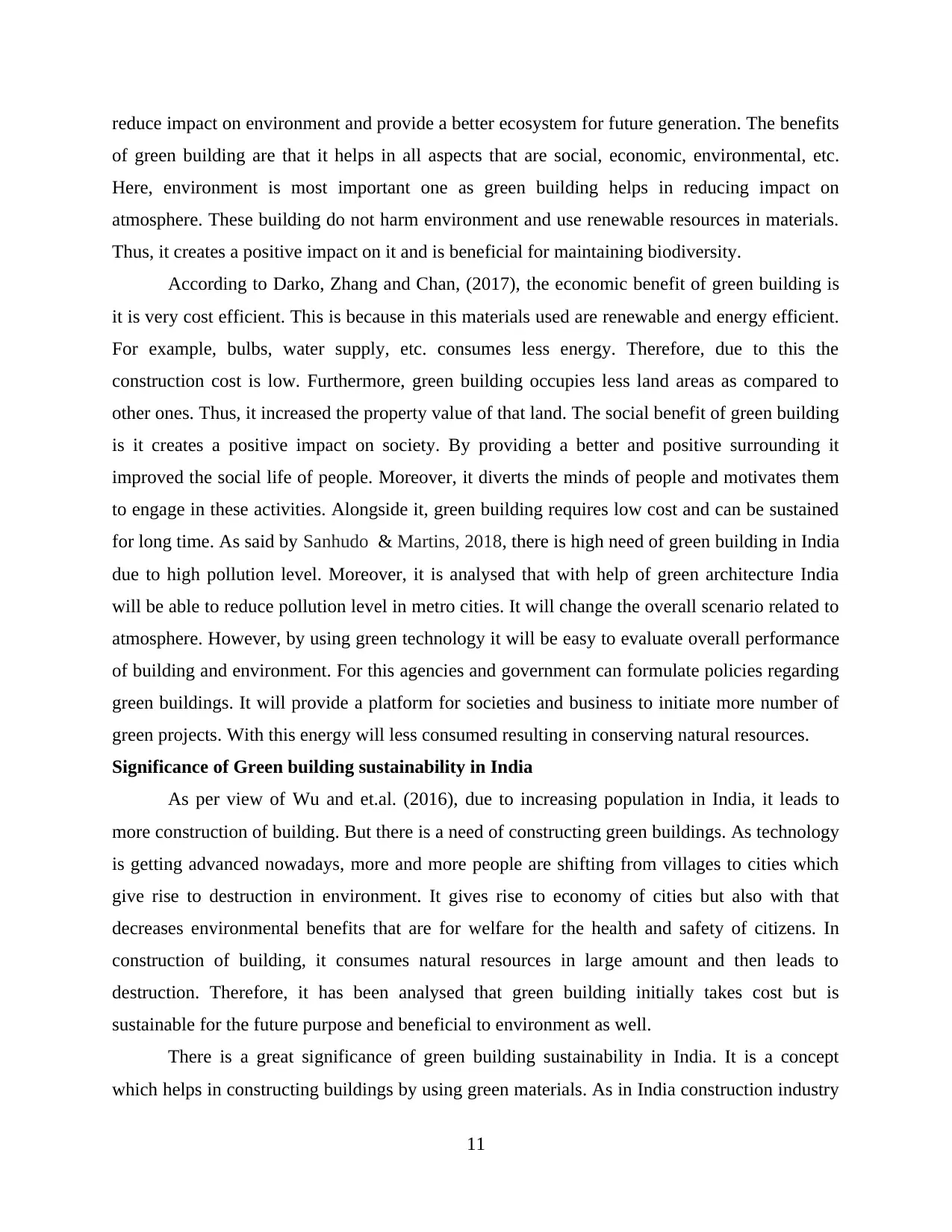
reduce impact on environment and provide a better ecosystem for future generation. The benefits
of green building are that it helps in all aspects that are social, economic, environmental, etc.
Here, environment is most important one as green building helps in reducing impact on
atmosphere. These building do not harm environment and use renewable resources in materials.
Thus, it creates a positive impact on it and is beneficial for maintaining biodiversity.
According to Darko, Zhang and Chan, (2017), the economic benefit of green building is
it is very cost efficient. This is because in this materials used are renewable and energy efficient.
For example, bulbs, water supply, etc. consumes less energy. Therefore, due to this the
construction cost is low. Furthermore, green building occupies less land areas as compared to
other ones. Thus, it increased the property value of that land. The social benefit of green building
is it creates a positive impact on society. By providing a better and positive surrounding it
improved the social life of people. Moreover, it diverts the minds of people and motivates them
to engage in these activities. Alongside it, green building requires low cost and can be sustained
for long time. As said by Sanhudo & Martins, 2018, there is high need of green building in India
due to high pollution level. Moreover, it is analysed that with help of green architecture India
will be able to reduce pollution level in metro cities. It will change the overall scenario related to
atmosphere. However, by using green technology it will be easy to evaluate overall performance
of building and environment. For this agencies and government can formulate policies regarding
green buildings. It will provide a platform for societies and business to initiate more number of
green projects. With this energy will less consumed resulting in conserving natural resources.
Significance of Green building sustainability in India
As per view of Wu and et.al. (2016), due to increasing population in India, it leads to
more construction of building. But there is a need of constructing green buildings. As technology
is getting advanced nowadays, more and more people are shifting from villages to cities which
give rise to destruction in environment. It gives rise to economy of cities but also with that
decreases environmental benefits that are for welfare for the health and safety of citizens. In
construction of building, it consumes natural resources in large amount and then leads to
destruction. Therefore, it has been analysed that green building initially takes cost but is
sustainable for the future purpose and beneficial to environment as well.
There is a great significance of green building sustainability in India. It is a concept
which helps in constructing buildings by using green materials. As in India construction industry
11
of green building are that it helps in all aspects that are social, economic, environmental, etc.
Here, environment is most important one as green building helps in reducing impact on
atmosphere. These building do not harm environment and use renewable resources in materials.
Thus, it creates a positive impact on it and is beneficial for maintaining biodiversity.
According to Darko, Zhang and Chan, (2017), the economic benefit of green building is
it is very cost efficient. This is because in this materials used are renewable and energy efficient.
For example, bulbs, water supply, etc. consumes less energy. Therefore, due to this the
construction cost is low. Furthermore, green building occupies less land areas as compared to
other ones. Thus, it increased the property value of that land. The social benefit of green building
is it creates a positive impact on society. By providing a better and positive surrounding it
improved the social life of people. Moreover, it diverts the minds of people and motivates them
to engage in these activities. Alongside it, green building requires low cost and can be sustained
for long time. As said by Sanhudo & Martins, 2018, there is high need of green building in India
due to high pollution level. Moreover, it is analysed that with help of green architecture India
will be able to reduce pollution level in metro cities. It will change the overall scenario related to
atmosphere. However, by using green technology it will be easy to evaluate overall performance
of building and environment. For this agencies and government can formulate policies regarding
green buildings. It will provide a platform for societies and business to initiate more number of
green projects. With this energy will less consumed resulting in conserving natural resources.
Significance of Green building sustainability in India
As per view of Wu and et.al. (2016), due to increasing population in India, it leads to
more construction of building. But there is a need of constructing green buildings. As technology
is getting advanced nowadays, more and more people are shifting from villages to cities which
give rise to destruction in environment. It gives rise to economy of cities but also with that
decreases environmental benefits that are for welfare for the health and safety of citizens. In
construction of building, it consumes natural resources in large amount and then leads to
destruction. Therefore, it has been analysed that green building initially takes cost but is
sustainable for the future purpose and beneficial to environment as well.
There is a great significance of green building sustainability in India. It is a concept
which helps in constructing buildings by using green materials. As in India construction industry
11
Secure Best Marks with AI Grader
Need help grading? Try our AI Grader for instant feedback on your assignments.
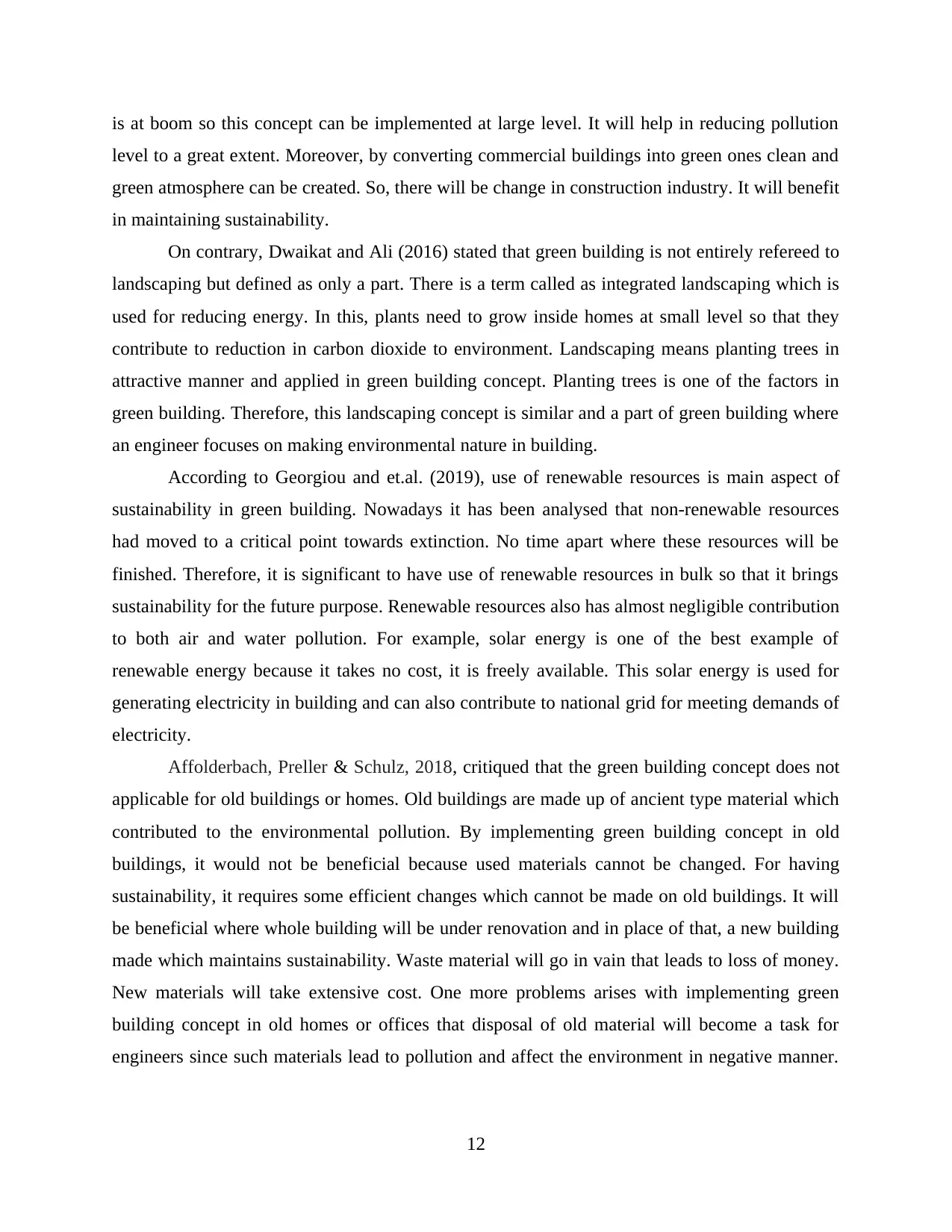
is at boom so this concept can be implemented at large level. It will help in reducing pollution
level to a great extent. Moreover, by converting commercial buildings into green ones clean and
green atmosphere can be created. So, there will be change in construction industry. It will benefit
in maintaining sustainability.
On contrary, Dwaikat and Ali (2016) stated that green building is not entirely refereed to
landscaping but defined as only a part. There is a term called as integrated landscaping which is
used for reducing energy. In this, plants need to grow inside homes at small level so that they
contribute to reduction in carbon dioxide to environment. Landscaping means planting trees in
attractive manner and applied in green building concept. Planting trees is one of the factors in
green building. Therefore, this landscaping concept is similar and a part of green building where
an engineer focuses on making environmental nature in building.
According to Georgiou and et.al. (2019), use of renewable resources is main aspect of
sustainability in green building. Nowadays it has been analysed that non-renewable resources
had moved to a critical point towards extinction. No time apart where these resources will be
finished. Therefore, it is significant to have use of renewable resources in bulk so that it brings
sustainability for the future purpose. Renewable resources also has almost negligible contribution
to both air and water pollution. For example, solar energy is one of the best example of
renewable energy because it takes no cost, it is freely available. This solar energy is used for
generating electricity in building and can also contribute to national grid for meeting demands of
electricity.
Affolderbach, Preller & Schulz, 2018, critiqued that the green building concept does not
applicable for old buildings or homes. Old buildings are made up of ancient type material which
contributed to the environmental pollution. By implementing green building concept in old
buildings, it would not be beneficial because used materials cannot be changed. For having
sustainability, it requires some efficient changes which cannot be made on old buildings. It will
be beneficial where whole building will be under renovation and in place of that, a new building
made which maintains sustainability. Waste material will go in vain that leads to loss of money.
New materials will take extensive cost. One more problems arises with implementing green
building concept in old homes or offices that disposal of old material will become a task for
engineers since such materials lead to pollution and affect the environment in negative manner.
12
level to a great extent. Moreover, by converting commercial buildings into green ones clean and
green atmosphere can be created. So, there will be change in construction industry. It will benefit
in maintaining sustainability.
On contrary, Dwaikat and Ali (2016) stated that green building is not entirely refereed to
landscaping but defined as only a part. There is a term called as integrated landscaping which is
used for reducing energy. In this, plants need to grow inside homes at small level so that they
contribute to reduction in carbon dioxide to environment. Landscaping means planting trees in
attractive manner and applied in green building concept. Planting trees is one of the factors in
green building. Therefore, this landscaping concept is similar and a part of green building where
an engineer focuses on making environmental nature in building.
According to Georgiou and et.al. (2019), use of renewable resources is main aspect of
sustainability in green building. Nowadays it has been analysed that non-renewable resources
had moved to a critical point towards extinction. No time apart where these resources will be
finished. Therefore, it is significant to have use of renewable resources in bulk so that it brings
sustainability for the future purpose. Renewable resources also has almost negligible contribution
to both air and water pollution. For example, solar energy is one of the best example of
renewable energy because it takes no cost, it is freely available. This solar energy is used for
generating electricity in building and can also contribute to national grid for meeting demands of
electricity.
Affolderbach, Preller & Schulz, 2018, critiqued that the green building concept does not
applicable for old buildings or homes. Old buildings are made up of ancient type material which
contributed to the environmental pollution. By implementing green building concept in old
buildings, it would not be beneficial because used materials cannot be changed. For having
sustainability, it requires some efficient changes which cannot be made on old buildings. It will
be beneficial where whole building will be under renovation and in place of that, a new building
made which maintains sustainability. Waste material will go in vain that leads to loss of money.
New materials will take extensive cost. One more problems arises with implementing green
building concept in old homes or offices that disposal of old material will become a task for
engineers since such materials lead to pollution and affect the environment in negative manner.
12
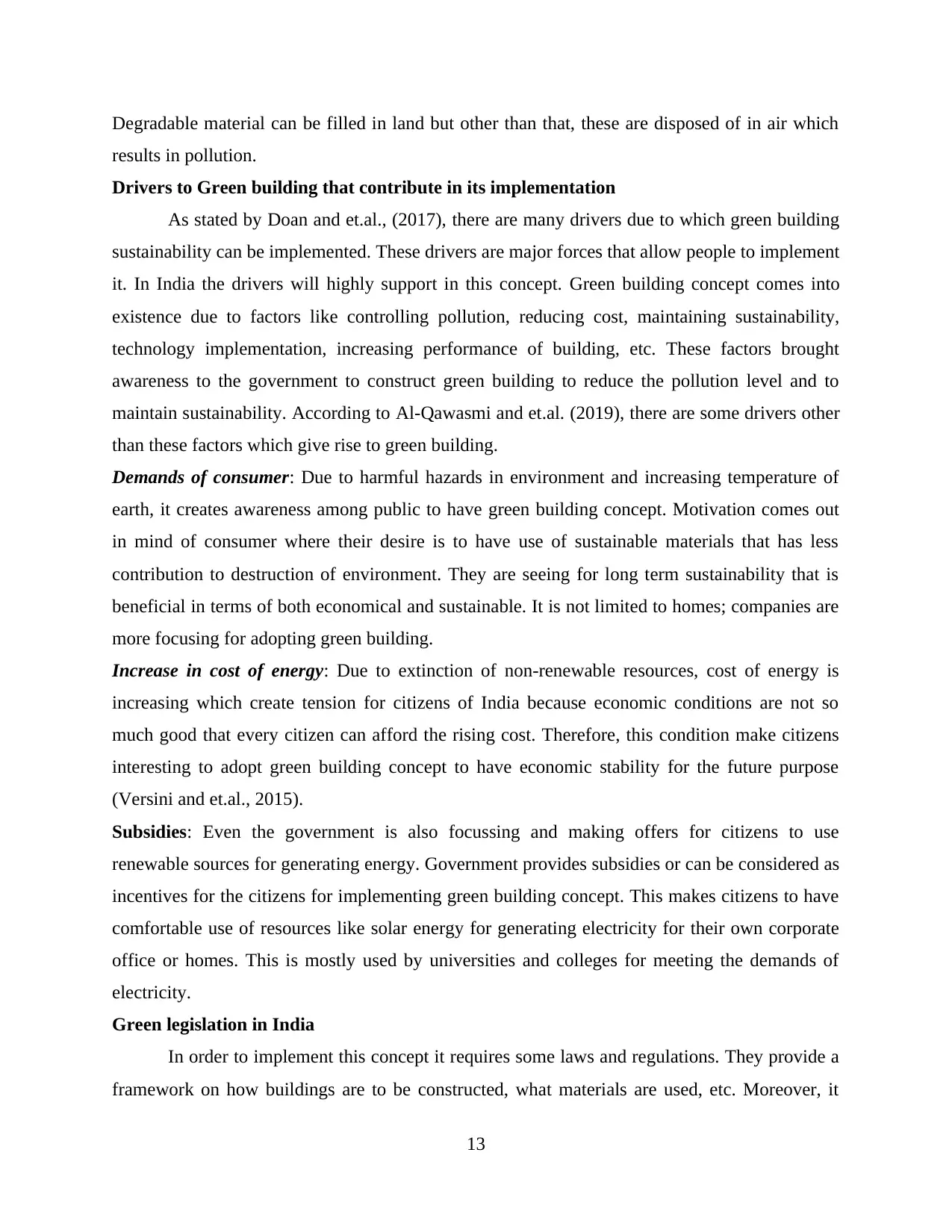
Degradable material can be filled in land but other than that, these are disposed of in air which
results in pollution.
Drivers to Green building that contribute in its implementation
As stated by Doan and et.al., (2017), there are many drivers due to which green building
sustainability can be implemented. These drivers are major forces that allow people to implement
it. In India the drivers will highly support in this concept. Green building concept comes into
existence due to factors like controlling pollution, reducing cost, maintaining sustainability,
technology implementation, increasing performance of building, etc. These factors brought
awareness to the government to construct green building to reduce the pollution level and to
maintain sustainability. According to Al-Qawasmi and et.al. (2019), there are some drivers other
than these factors which give rise to green building.
Demands of consumer: Due to harmful hazards in environment and increasing temperature of
earth, it creates awareness among public to have green building concept. Motivation comes out
in mind of consumer where their desire is to have use of sustainable materials that has less
contribution to destruction of environment. They are seeing for long term sustainability that is
beneficial in terms of both economical and sustainable. It is not limited to homes; companies are
more focusing for adopting green building.
Increase in cost of energy: Due to extinction of non-renewable resources, cost of energy is
increasing which create tension for citizens of India because economic conditions are not so
much good that every citizen can afford the rising cost. Therefore, this condition make citizens
interesting to adopt green building concept to have economic stability for the future purpose
(Versini and et.al., 2015).
Subsidies: Even the government is also focussing and making offers for citizens to use
renewable sources for generating energy. Government provides subsidies or can be considered as
incentives for the citizens for implementing green building concept. This makes citizens to have
comfortable use of resources like solar energy for generating electricity for their own corporate
office or homes. This is mostly used by universities and colleges for meeting the demands of
electricity.
Green legislation in India
In order to implement this concept it requires some laws and regulations. They provide a
framework on how buildings are to be constructed, what materials are used, etc. Moreover, it
13
results in pollution.
Drivers to Green building that contribute in its implementation
As stated by Doan and et.al., (2017), there are many drivers due to which green building
sustainability can be implemented. These drivers are major forces that allow people to implement
it. In India the drivers will highly support in this concept. Green building concept comes into
existence due to factors like controlling pollution, reducing cost, maintaining sustainability,
technology implementation, increasing performance of building, etc. These factors brought
awareness to the government to construct green building to reduce the pollution level and to
maintain sustainability. According to Al-Qawasmi and et.al. (2019), there are some drivers other
than these factors which give rise to green building.
Demands of consumer: Due to harmful hazards in environment and increasing temperature of
earth, it creates awareness among public to have green building concept. Motivation comes out
in mind of consumer where their desire is to have use of sustainable materials that has less
contribution to destruction of environment. They are seeing for long term sustainability that is
beneficial in terms of both economical and sustainable. It is not limited to homes; companies are
more focusing for adopting green building.
Increase in cost of energy: Due to extinction of non-renewable resources, cost of energy is
increasing which create tension for citizens of India because economic conditions are not so
much good that every citizen can afford the rising cost. Therefore, this condition make citizens
interesting to adopt green building concept to have economic stability for the future purpose
(Versini and et.al., 2015).
Subsidies: Even the government is also focussing and making offers for citizens to use
renewable sources for generating energy. Government provides subsidies or can be considered as
incentives for the citizens for implementing green building concept. This makes citizens to have
comfortable use of resources like solar energy for generating electricity for their own corporate
office or homes. This is mostly used by universities and colleges for meeting the demands of
electricity.
Green legislation in India
In order to implement this concept it requires some laws and regulations. They provide a
framework on how buildings are to be constructed, what materials are used, etc. Moreover, it
13
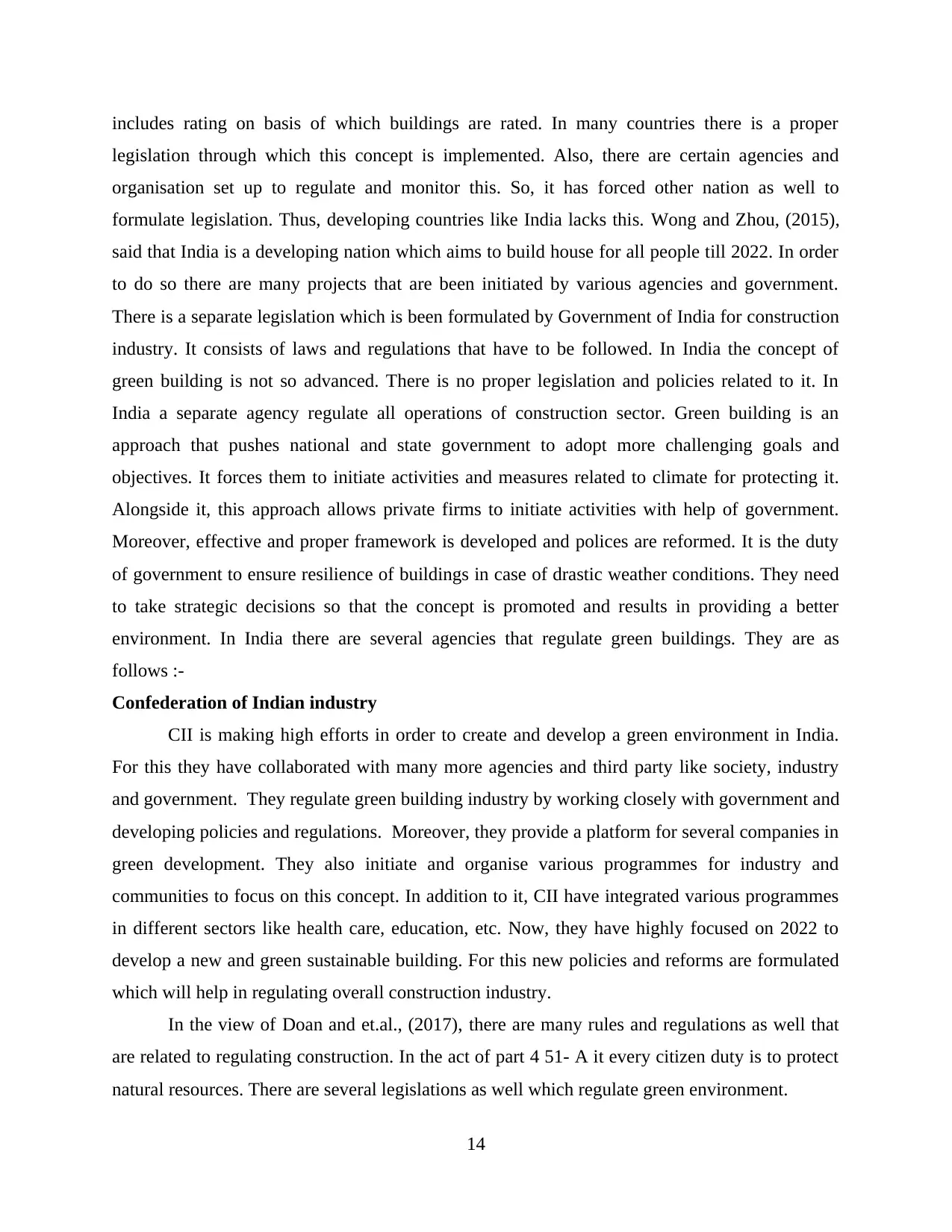
includes rating on basis of which buildings are rated. In many countries there is a proper
legislation through which this concept is implemented. Also, there are certain agencies and
organisation set up to regulate and monitor this. So, it has forced other nation as well to
formulate legislation. Thus, developing countries like India lacks this. Wong and Zhou, (2015),
said that India is a developing nation which aims to build house for all people till 2022. In order
to do so there are many projects that are been initiated by various agencies and government.
There is a separate legislation which is been formulated by Government of India for construction
industry. It consists of laws and regulations that have to be followed. In India the concept of
green building is not so advanced. There is no proper legislation and policies related to it. In
India a separate agency regulate all operations of construction sector. Green building is an
approach that pushes national and state government to adopt more challenging goals and
objectives. It forces them to initiate activities and measures related to climate for protecting it.
Alongside it, this approach allows private firms to initiate activities with help of government.
Moreover, effective and proper framework is developed and polices are reformed. It is the duty
of government to ensure resilience of buildings in case of drastic weather conditions. They need
to take strategic decisions so that the concept is promoted and results in providing a better
environment. In India there are several agencies that regulate green buildings. They are as
follows :-
Confederation of Indian industry
CII is making high efforts in order to create and develop a green environment in India.
For this they have collaborated with many more agencies and third party like society, industry
and government. They regulate green building industry by working closely with government and
developing policies and regulations. Moreover, they provide a platform for several companies in
green development. They also initiate and organise various programmes for industry and
communities to focus on this concept. In addition to it, CII have integrated various programmes
in different sectors like health care, education, etc. Now, they have highly focused on 2022 to
develop a new and green sustainable building. For this new policies and reforms are formulated
which will help in regulating overall construction industry.
In the view of Doan and et.al., (2017), there are many rules and regulations as well that
are related to regulating construction. In the act of part 4 51- A it every citizen duty is to protect
natural resources. There are several legislations as well which regulate green environment.
14
legislation through which this concept is implemented. Also, there are certain agencies and
organisation set up to regulate and monitor this. So, it has forced other nation as well to
formulate legislation. Thus, developing countries like India lacks this. Wong and Zhou, (2015),
said that India is a developing nation which aims to build house for all people till 2022. In order
to do so there are many projects that are been initiated by various agencies and government.
There is a separate legislation which is been formulated by Government of India for construction
industry. It consists of laws and regulations that have to be followed. In India the concept of
green building is not so advanced. There is no proper legislation and policies related to it. In
India a separate agency regulate all operations of construction sector. Green building is an
approach that pushes national and state government to adopt more challenging goals and
objectives. It forces them to initiate activities and measures related to climate for protecting it.
Alongside it, this approach allows private firms to initiate activities with help of government.
Moreover, effective and proper framework is developed and polices are reformed. It is the duty
of government to ensure resilience of buildings in case of drastic weather conditions. They need
to take strategic decisions so that the concept is promoted and results in providing a better
environment. In India there are several agencies that regulate green buildings. They are as
follows :-
Confederation of Indian industry
CII is making high efforts in order to create and develop a green environment in India.
For this they have collaborated with many more agencies and third party like society, industry
and government. They regulate green building industry by working closely with government and
developing policies and regulations. Moreover, they provide a platform for several companies in
green development. They also initiate and organise various programmes for industry and
communities to focus on this concept. In addition to it, CII have integrated various programmes
in different sectors like health care, education, etc. Now, they have highly focused on 2022 to
develop a new and green sustainable building. For this new policies and reforms are formulated
which will help in regulating overall construction industry.
In the view of Doan and et.al., (2017), there are many rules and regulations as well that
are related to regulating construction. In the act of part 4 51- A it every citizen duty is to protect
natural resources. There are several legislations as well which regulate green environment.
14
Paraphrase This Document
Need a fresh take? Get an instant paraphrase of this document with our AI Paraphraser
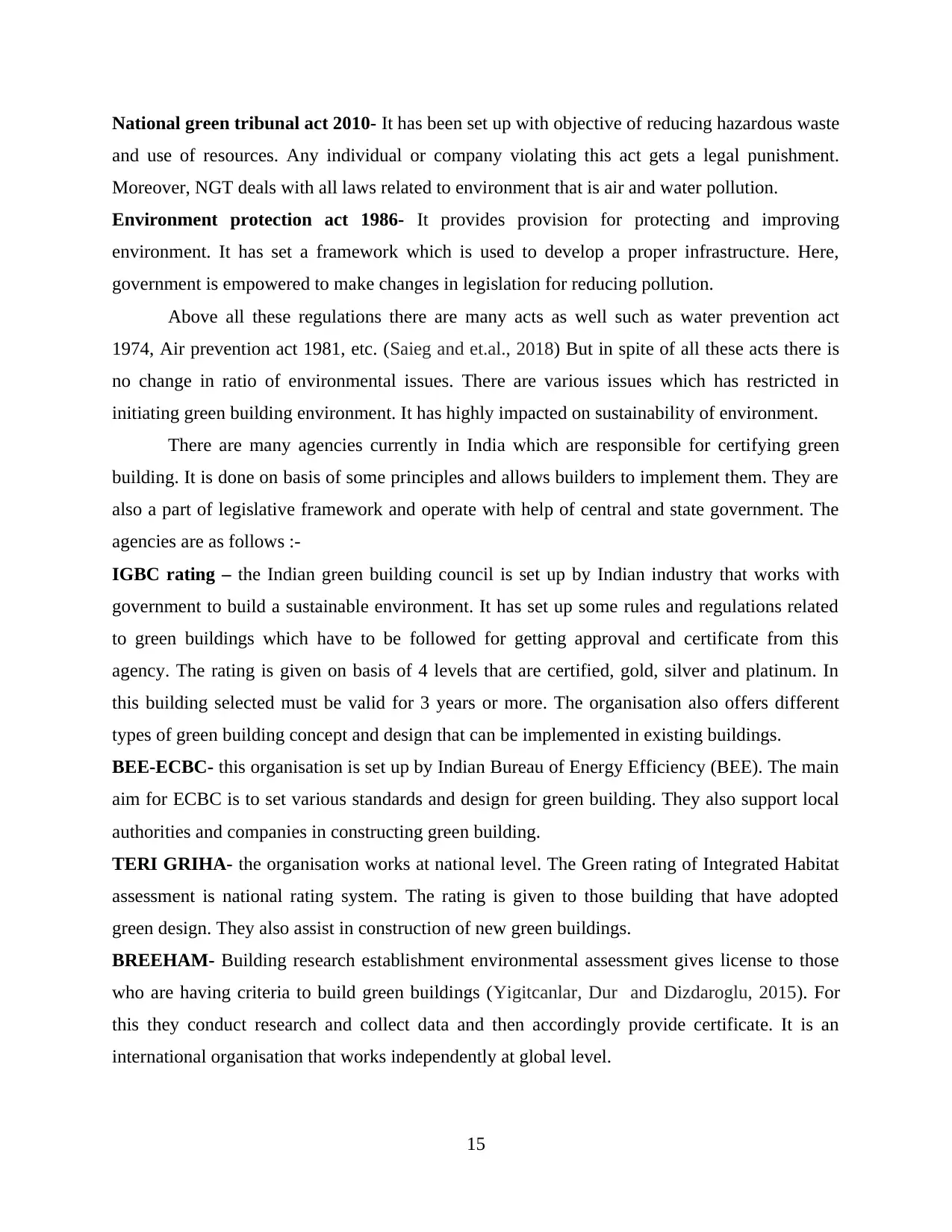
National green tribunal act 2010- It has been set up with objective of reducing hazardous waste
and use of resources. Any individual or company violating this act gets a legal punishment.
Moreover, NGT deals with all laws related to environment that is air and water pollution.
Environment protection act 1986- It provides provision for protecting and improving
environment. It has set a framework which is used to develop a proper infrastructure. Here,
government is empowered to make changes in legislation for reducing pollution.
Above all these regulations there are many acts as well such as water prevention act
1974, Air prevention act 1981, etc. (Saieg and et.al., 2018) But in spite of all these acts there is
no change in ratio of environmental issues. There are various issues which has restricted in
initiating green building environment. It has highly impacted on sustainability of environment.
There are many agencies currently in India which are responsible for certifying green
building. It is done on basis of some principles and allows builders to implement them. They are
also a part of legislative framework and operate with help of central and state government. The
agencies are as follows :-
IGBC rating – the Indian green building council is set up by Indian industry that works with
government to build a sustainable environment. It has set up some rules and regulations related
to green buildings which have to be followed for getting approval and certificate from this
agency. The rating is given on basis of 4 levels that are certified, gold, silver and platinum. In
this building selected must be valid for 3 years or more. The organisation also offers different
types of green building concept and design that can be implemented in existing buildings.
BEE-ECBC- this organisation is set up by Indian Bureau of Energy Efficiency (BEE). The main
aim for ECBC is to set various standards and design for green building. They also support local
authorities and companies in constructing green building.
TERI GRIHA- the organisation works at national level. The Green rating of Integrated Habitat
assessment is national rating system. The rating is given to those building that have adopted
green design. They also assist in construction of new green buildings.
BREEHAM- Building research establishment environmental assessment gives license to those
who are having criteria to build green buildings (Yigitcanlar, Dur and Dizdaroglu, 2015). For
this they conduct research and collect data and then accordingly provide certificate. It is an
international organisation that works independently at global level.
15
and use of resources. Any individual or company violating this act gets a legal punishment.
Moreover, NGT deals with all laws related to environment that is air and water pollution.
Environment protection act 1986- It provides provision for protecting and improving
environment. It has set a framework which is used to develop a proper infrastructure. Here,
government is empowered to make changes in legislation for reducing pollution.
Above all these regulations there are many acts as well such as water prevention act
1974, Air prevention act 1981, etc. (Saieg and et.al., 2018) But in spite of all these acts there is
no change in ratio of environmental issues. There are various issues which has restricted in
initiating green building environment. It has highly impacted on sustainability of environment.
There are many agencies currently in India which are responsible for certifying green
building. It is done on basis of some principles and allows builders to implement them. They are
also a part of legislative framework and operate with help of central and state government. The
agencies are as follows :-
IGBC rating – the Indian green building council is set up by Indian industry that works with
government to build a sustainable environment. It has set up some rules and regulations related
to green buildings which have to be followed for getting approval and certificate from this
agency. The rating is given on basis of 4 levels that are certified, gold, silver and platinum. In
this building selected must be valid for 3 years or more. The organisation also offers different
types of green building concept and design that can be implemented in existing buildings.
BEE-ECBC- this organisation is set up by Indian Bureau of Energy Efficiency (BEE). The main
aim for ECBC is to set various standards and design for green building. They also support local
authorities and companies in constructing green building.
TERI GRIHA- the organisation works at national level. The Green rating of Integrated Habitat
assessment is national rating system. The rating is given to those building that have adopted
green design. They also assist in construction of new green buildings.
BREEHAM- Building research establishment environmental assessment gives license to those
who are having criteria to build green buildings (Yigitcanlar, Dur and Dizdaroglu, 2015). For
this they conduct research and collect data and then accordingly provide certificate. It is an
international organisation that works independently at global level.
15
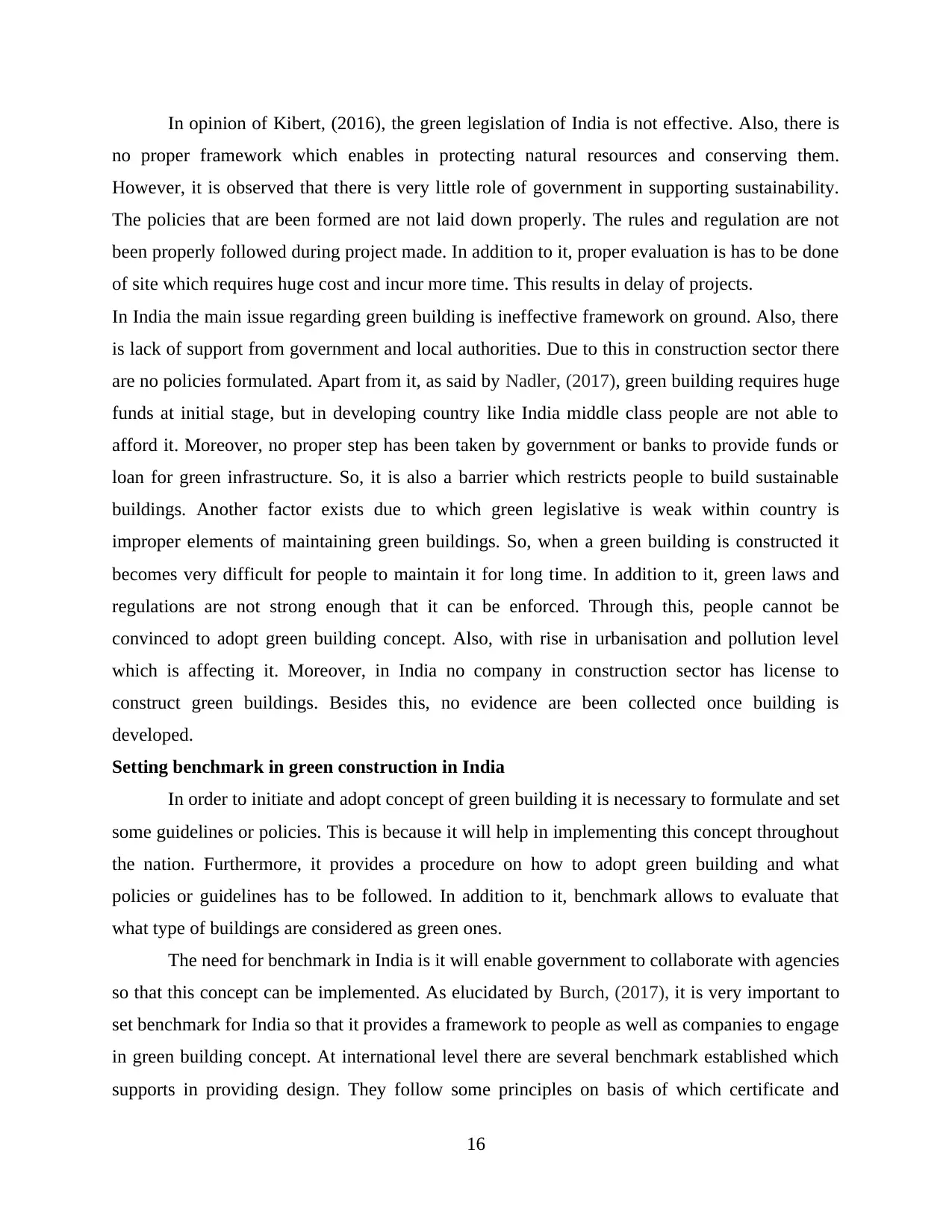
In opinion of Kibert, (2016), the green legislation of India is not effective. Also, there is
no proper framework which enables in protecting natural resources and conserving them.
However, it is observed that there is very little role of government in supporting sustainability.
The policies that are been formed are not laid down properly. The rules and regulation are not
been properly followed during project made. In addition to it, proper evaluation is has to be done
of site which requires huge cost and incur more time. This results in delay of projects.
In India the main issue regarding green building is ineffective framework on ground. Also, there
is lack of support from government and local authorities. Due to this in construction sector there
are no policies formulated. Apart from it, as said by Nadler, (2017), green building requires huge
funds at initial stage, but in developing country like India middle class people are not able to
afford it. Moreover, no proper step has been taken by government or banks to provide funds or
loan for green infrastructure. So, it is also a barrier which restricts people to build sustainable
buildings. Another factor exists due to which green legislative is weak within country is
improper elements of maintaining green buildings. So, when a green building is constructed it
becomes very difficult for people to maintain it for long time. In addition to it, green laws and
regulations are not strong enough that it can be enforced. Through this, people cannot be
convinced to adopt green building concept. Also, with rise in urbanisation and pollution level
which is affecting it. Moreover, in India no company in construction sector has license to
construct green buildings. Besides this, no evidence are been collected once building is
developed.
Setting benchmark in green construction in India
In order to initiate and adopt concept of green building it is necessary to formulate and set
some guidelines or policies. This is because it will help in implementing this concept throughout
the nation. Furthermore, it provides a procedure on how to adopt green building and what
policies or guidelines has to be followed. In addition to it, benchmark allows to evaluate that
what type of buildings are considered as green ones.
The need for benchmark in India is it will enable government to collaborate with agencies
so that this concept can be implemented. As elucidated by Burch, (2017), it is very important to
set benchmark for India so that it provides a framework to people as well as companies to engage
in green building concept. At international level there are several benchmark established which
supports in providing design. They follow some principles on basis of which certificate and
16
no proper framework which enables in protecting natural resources and conserving them.
However, it is observed that there is very little role of government in supporting sustainability.
The policies that are been formed are not laid down properly. The rules and regulation are not
been properly followed during project made. In addition to it, proper evaluation is has to be done
of site which requires huge cost and incur more time. This results in delay of projects.
In India the main issue regarding green building is ineffective framework on ground. Also, there
is lack of support from government and local authorities. Due to this in construction sector there
are no policies formulated. Apart from it, as said by Nadler, (2017), green building requires huge
funds at initial stage, but in developing country like India middle class people are not able to
afford it. Moreover, no proper step has been taken by government or banks to provide funds or
loan for green infrastructure. So, it is also a barrier which restricts people to build sustainable
buildings. Another factor exists due to which green legislative is weak within country is
improper elements of maintaining green buildings. So, when a green building is constructed it
becomes very difficult for people to maintain it for long time. In addition to it, green laws and
regulations are not strong enough that it can be enforced. Through this, people cannot be
convinced to adopt green building concept. Also, with rise in urbanisation and pollution level
which is affecting it. Moreover, in India no company in construction sector has license to
construct green buildings. Besides this, no evidence are been collected once building is
developed.
Setting benchmark in green construction in India
In order to initiate and adopt concept of green building it is necessary to formulate and set
some guidelines or policies. This is because it will help in implementing this concept throughout
the nation. Furthermore, it provides a procedure on how to adopt green building and what
policies or guidelines has to be followed. In addition to it, benchmark allows to evaluate that
what type of buildings are considered as green ones.
The need for benchmark in India is it will enable government to collaborate with agencies
so that this concept can be implemented. As elucidated by Burch, (2017), it is very important to
set benchmark for India so that it provides a framework to people as well as companies to engage
in green building concept. At international level there are several benchmark established which
supports in providing design. They follow some principles on basis of which certificate and
16
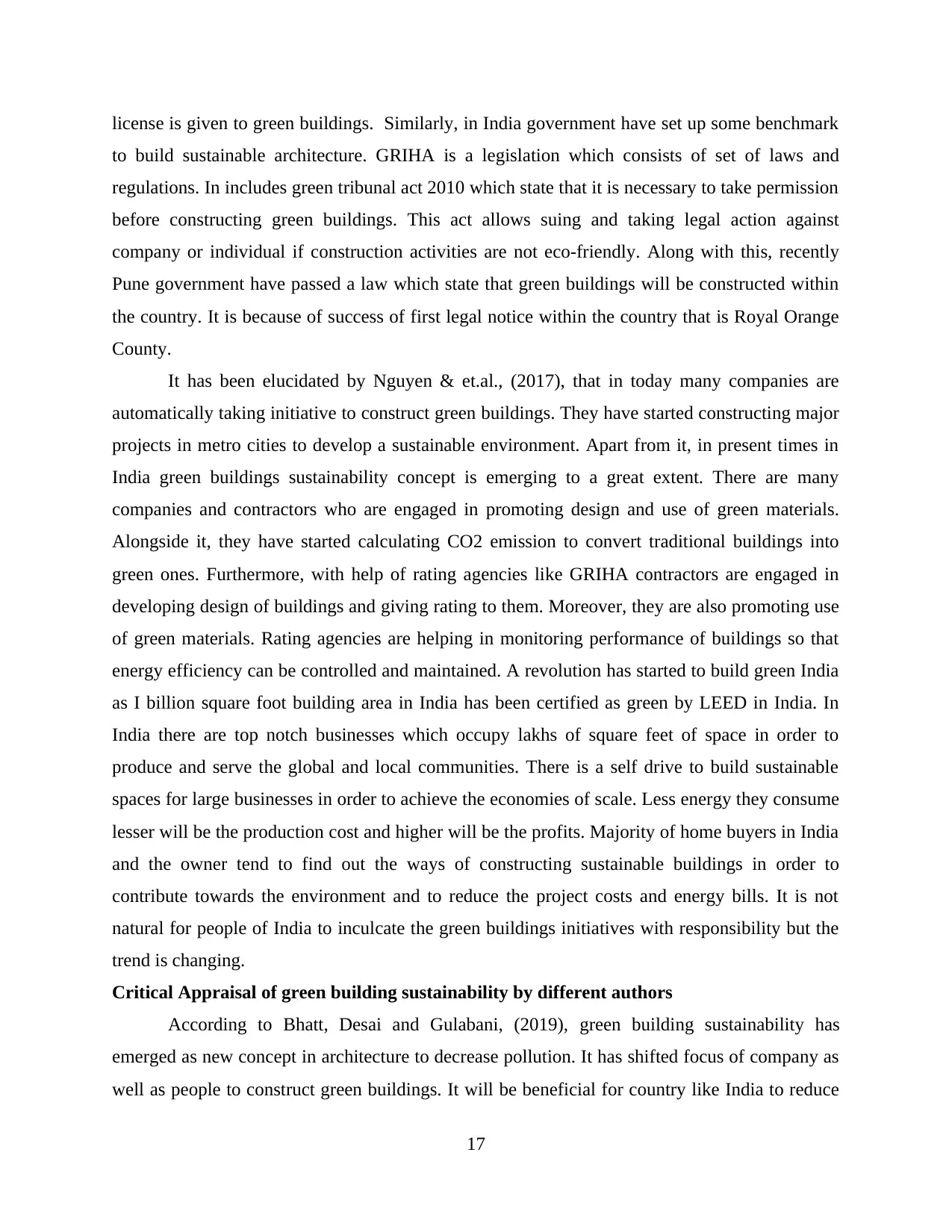
license is given to green buildings. Similarly, in India government have set up some benchmark
to build sustainable architecture. GRIHA is a legislation which consists of set of laws and
regulations. In includes green tribunal act 2010 which state that it is necessary to take permission
before constructing green buildings. This act allows suing and taking legal action against
company or individual if construction activities are not eco-friendly. Along with this, recently
Pune government have passed a law which state that green buildings will be constructed within
the country. It is because of success of first legal notice within the country that is Royal Orange
County.
It has been elucidated by Nguyen & et.al., (2017), that in today many companies are
automatically taking initiative to construct green buildings. They have started constructing major
projects in metro cities to develop a sustainable environment. Apart from it, in present times in
India green buildings sustainability concept is emerging to a great extent. There are many
companies and contractors who are engaged in promoting design and use of green materials.
Alongside it, they have started calculating CO2 emission to convert traditional buildings into
green ones. Furthermore, with help of rating agencies like GRIHA contractors are engaged in
developing design of buildings and giving rating to them. Moreover, they are also promoting use
of green materials. Rating agencies are helping in monitoring performance of buildings so that
energy efficiency can be controlled and maintained. A revolution has started to build green India
as I billion square foot building area in India has been certified as green by LEED in India. In
India there are top notch businesses which occupy lakhs of square feet of space in order to
produce and serve the global and local communities. There is a self drive to build sustainable
spaces for large businesses in order to achieve the economies of scale. Less energy they consume
lesser will be the production cost and higher will be the profits. Majority of home buyers in India
and the owner tend to find out the ways of constructing sustainable buildings in order to
contribute towards the environment and to reduce the project costs and energy bills. It is not
natural for people of India to inculcate the green buildings initiatives with responsibility but the
trend is changing.
Critical Appraisal of green building sustainability by different authors
According to Bhatt, Desai and Gulabani, (2019), green building sustainability has
emerged as new concept in architecture to decrease pollution. It has shifted focus of company as
well as people to construct green buildings. It will be beneficial for country like India to reduce
17
to build sustainable architecture. GRIHA is a legislation which consists of set of laws and
regulations. In includes green tribunal act 2010 which state that it is necessary to take permission
before constructing green buildings. This act allows suing and taking legal action against
company or individual if construction activities are not eco-friendly. Along with this, recently
Pune government have passed a law which state that green buildings will be constructed within
the country. It is because of success of first legal notice within the country that is Royal Orange
County.
It has been elucidated by Nguyen & et.al., (2017), that in today many companies are
automatically taking initiative to construct green buildings. They have started constructing major
projects in metro cities to develop a sustainable environment. Apart from it, in present times in
India green buildings sustainability concept is emerging to a great extent. There are many
companies and contractors who are engaged in promoting design and use of green materials.
Alongside it, they have started calculating CO2 emission to convert traditional buildings into
green ones. Furthermore, with help of rating agencies like GRIHA contractors are engaged in
developing design of buildings and giving rating to them. Moreover, they are also promoting use
of green materials. Rating agencies are helping in monitoring performance of buildings so that
energy efficiency can be controlled and maintained. A revolution has started to build green India
as I billion square foot building area in India has been certified as green by LEED in India. In
India there are top notch businesses which occupy lakhs of square feet of space in order to
produce and serve the global and local communities. There is a self drive to build sustainable
spaces for large businesses in order to achieve the economies of scale. Less energy they consume
lesser will be the production cost and higher will be the profits. Majority of home buyers in India
and the owner tend to find out the ways of constructing sustainable buildings in order to
contribute towards the environment and to reduce the project costs and energy bills. It is not
natural for people of India to inculcate the green buildings initiatives with responsibility but the
trend is changing.
Critical Appraisal of green building sustainability by different authors
According to Bhatt, Desai and Gulabani, (2019), green building sustainability has
emerged as new concept in architecture to decrease pollution. It has shifted focus of company as
well as people to construct green buildings. It will be beneficial for country like India to reduce
17
Secure Best Marks with AI Grader
Need help grading? Try our AI Grader for instant feedback on your assignments.
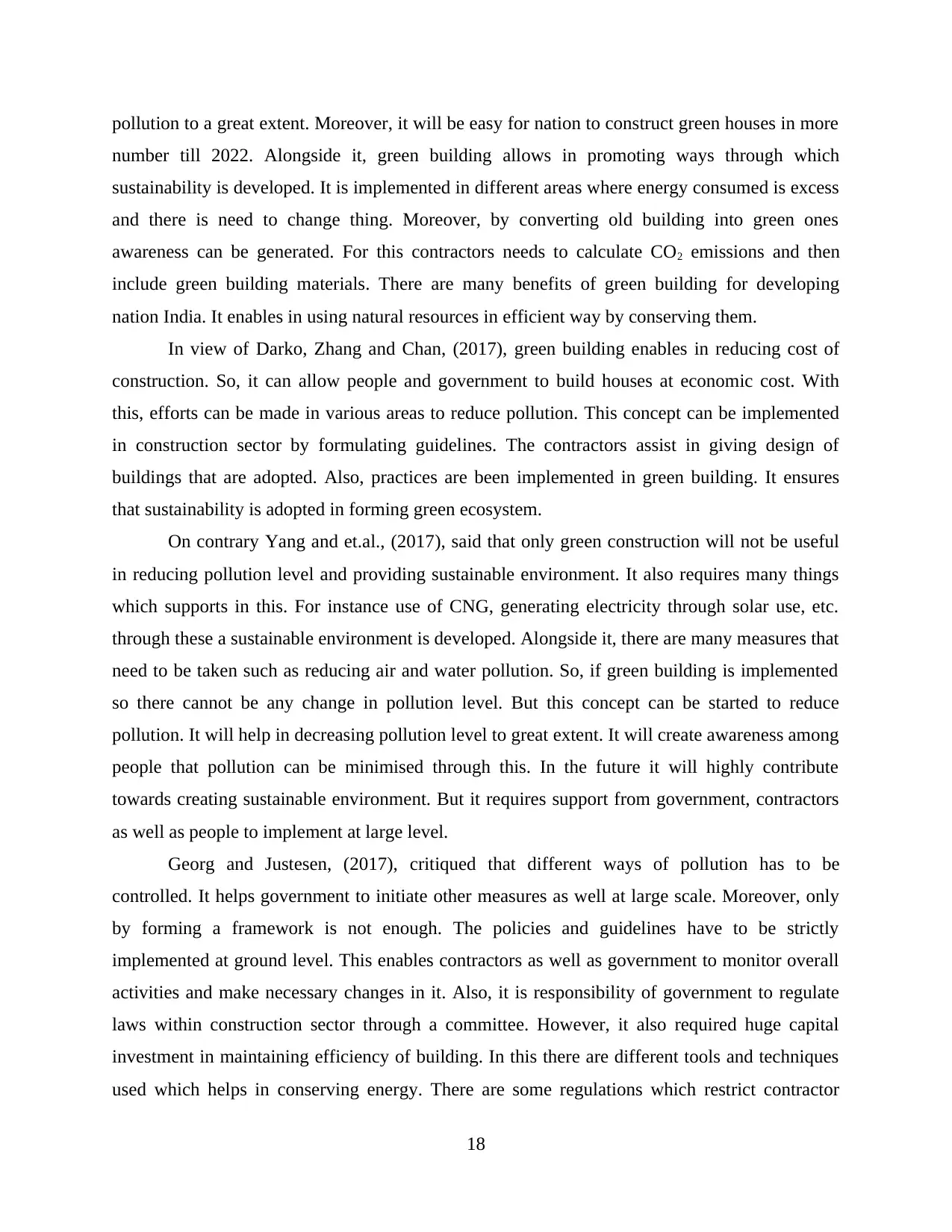
pollution to a great extent. Moreover, it will be easy for nation to construct green houses in more
number till 2022. Alongside it, green building allows in promoting ways through which
sustainability is developed. It is implemented in different areas where energy consumed is excess
and there is need to change thing. Moreover, by converting old building into green ones
awareness can be generated. For this contractors needs to calculate CO2 emissions and then
include green building materials. There are many benefits of green building for developing
nation India. It enables in using natural resources in efficient way by conserving them.
In view of Darko, Zhang and Chan, (2017), green building enables in reducing cost of
construction. So, it can allow people and government to build houses at economic cost. With
this, efforts can be made in various areas to reduce pollution. This concept can be implemented
in construction sector by formulating guidelines. The contractors assist in giving design of
buildings that are adopted. Also, practices are been implemented in green building. It ensures
that sustainability is adopted in forming green ecosystem.
On contrary Yang and et.al., (2017), said that only green construction will not be useful
in reducing pollution level and providing sustainable environment. It also requires many things
which supports in this. For instance use of CNG, generating electricity through solar use, etc.
through these a sustainable environment is developed. Alongside it, there are many measures that
need to be taken such as reducing air and water pollution. So, if green building is implemented
so there cannot be any change in pollution level. But this concept can be started to reduce
pollution. It will help in decreasing pollution level to great extent. It will create awareness among
people that pollution can be minimised through this. In the future it will highly contribute
towards creating sustainable environment. But it requires support from government, contractors
as well as people to implement at large level.
Georg and Justesen, (2017), critiqued that different ways of pollution has to be
controlled. It helps government to initiate other measures as well at large scale. Moreover, only
by forming a framework is not enough. The policies and guidelines have to be strictly
implemented at ground level. This enables contractors as well as government to monitor overall
activities and make necessary changes in it. Also, it is responsibility of government to regulate
laws within construction sector through a committee. However, it also required huge capital
investment in maintaining efficiency of building. In this there are different tools and techniques
used which helps in conserving energy. There are some regulations which restrict contractor
18
number till 2022. Alongside it, green building allows in promoting ways through which
sustainability is developed. It is implemented in different areas where energy consumed is excess
and there is need to change thing. Moreover, by converting old building into green ones
awareness can be generated. For this contractors needs to calculate CO2 emissions and then
include green building materials. There are many benefits of green building for developing
nation India. It enables in using natural resources in efficient way by conserving them.
In view of Darko, Zhang and Chan, (2017), green building enables in reducing cost of
construction. So, it can allow people and government to build houses at economic cost. With
this, efforts can be made in various areas to reduce pollution. This concept can be implemented
in construction sector by formulating guidelines. The contractors assist in giving design of
buildings that are adopted. Also, practices are been implemented in green building. It ensures
that sustainability is adopted in forming green ecosystem.
On contrary Yang and et.al., (2017), said that only green construction will not be useful
in reducing pollution level and providing sustainable environment. It also requires many things
which supports in this. For instance use of CNG, generating electricity through solar use, etc.
through these a sustainable environment is developed. Alongside it, there are many measures that
need to be taken such as reducing air and water pollution. So, if green building is implemented
so there cannot be any change in pollution level. But this concept can be started to reduce
pollution. It will help in decreasing pollution level to great extent. It will create awareness among
people that pollution can be minimised through this. In the future it will highly contribute
towards creating sustainable environment. But it requires support from government, contractors
as well as people to implement at large level.
Georg and Justesen, (2017), critiqued that different ways of pollution has to be
controlled. It helps government to initiate other measures as well at large scale. Moreover, only
by forming a framework is not enough. The policies and guidelines have to be strictly
implemented at ground level. This enables contractors as well as government to monitor overall
activities and make necessary changes in it. Also, it is responsibility of government to regulate
laws within construction sector through a committee. However, it also required huge capital
investment in maintaining efficiency of building. In this there are different tools and techniques
used which helps in conserving energy. There are some regulations which restrict contractor
18
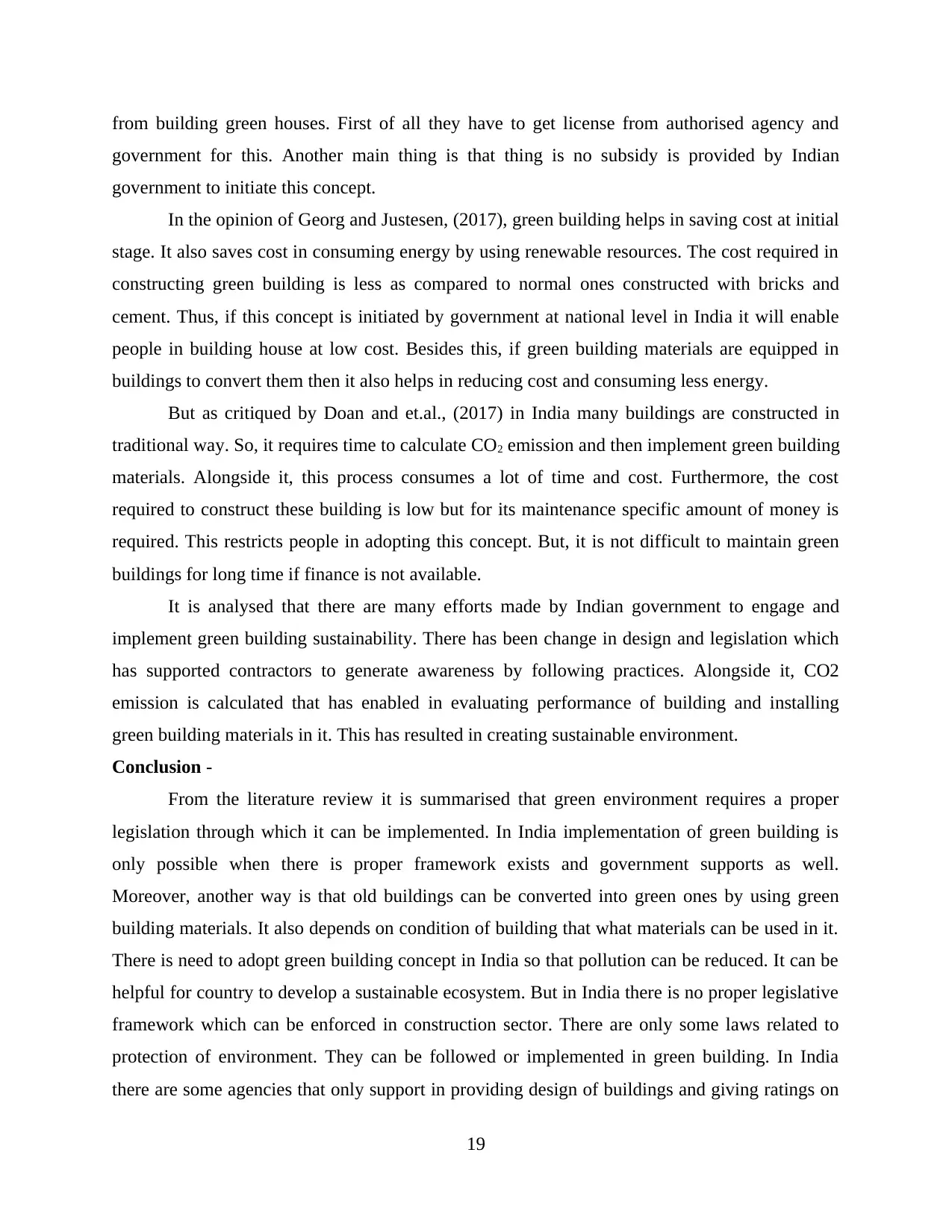
from building green houses. First of all they have to get license from authorised agency and
government for this. Another main thing is that thing is no subsidy is provided by Indian
government to initiate this concept.
In the opinion of Georg and Justesen, (2017), green building helps in saving cost at initial
stage. It also saves cost in consuming energy by using renewable resources. The cost required in
constructing green building is less as compared to normal ones constructed with bricks and
cement. Thus, if this concept is initiated by government at national level in India it will enable
people in building house at low cost. Besides this, if green building materials are equipped in
buildings to convert them then it also helps in reducing cost and consuming less energy.
But as critiqued by Doan and et.al., (2017) in India many buildings are constructed in
traditional way. So, it requires time to calculate CO2 emission and then implement green building
materials. Alongside it, this process consumes a lot of time and cost. Furthermore, the cost
required to construct these building is low but for its maintenance specific amount of money is
required. This restricts people in adopting this concept. But, it is not difficult to maintain green
buildings for long time if finance is not available.
It is analysed that there are many efforts made by Indian government to engage and
implement green building sustainability. There has been change in design and legislation which
has supported contractors to generate awareness by following practices. Alongside it, CO2
emission is calculated that has enabled in evaluating performance of building and installing
green building materials in it. This has resulted in creating sustainable environment.
Conclusion -
From the literature review it is summarised that green environment requires a proper
legislation through which it can be implemented. In India implementation of green building is
only possible when there is proper framework exists and government supports as well.
Moreover, another way is that old buildings can be converted into green ones by using green
building materials. It also depends on condition of building that what materials can be used in it.
There is need to adopt green building concept in India so that pollution can be reduced. It can be
helpful for country to develop a sustainable ecosystem. But in India there is no proper legislative
framework which can be enforced in construction sector. There are only some laws related to
protection of environment. They can be followed or implemented in green building. In India
there are some agencies that only support in providing design of buildings and giving ratings on
19
government for this. Another main thing is that thing is no subsidy is provided by Indian
government to initiate this concept.
In the opinion of Georg and Justesen, (2017), green building helps in saving cost at initial
stage. It also saves cost in consuming energy by using renewable resources. The cost required in
constructing green building is less as compared to normal ones constructed with bricks and
cement. Thus, if this concept is initiated by government at national level in India it will enable
people in building house at low cost. Besides this, if green building materials are equipped in
buildings to convert them then it also helps in reducing cost and consuming less energy.
But as critiqued by Doan and et.al., (2017) in India many buildings are constructed in
traditional way. So, it requires time to calculate CO2 emission and then implement green building
materials. Alongside it, this process consumes a lot of time and cost. Furthermore, the cost
required to construct these building is low but for its maintenance specific amount of money is
required. This restricts people in adopting this concept. But, it is not difficult to maintain green
buildings for long time if finance is not available.
It is analysed that there are many efforts made by Indian government to engage and
implement green building sustainability. There has been change in design and legislation which
has supported contractors to generate awareness by following practices. Alongside it, CO2
emission is calculated that has enabled in evaluating performance of building and installing
green building materials in it. This has resulted in creating sustainable environment.
Conclusion -
From the literature review it is summarised that green environment requires a proper
legislation through which it can be implemented. In India implementation of green building is
only possible when there is proper framework exists and government supports as well.
Moreover, another way is that old buildings can be converted into green ones by using green
building materials. It also depends on condition of building that what materials can be used in it.
There is need to adopt green building concept in India so that pollution can be reduced. It can be
helpful for country to develop a sustainable ecosystem. But in India there is no proper legislative
framework which can be enforced in construction sector. There are only some laws related to
protection of environment. They can be followed or implemented in green building. In India
there are some agencies that only support in providing design of buildings and giving ratings on
19

this basis. Also, it helps in following some practices through which green materials can be used.
There are already some green buildings that is been developed by large companies. So, in order
to implement this laws and regulations are required. It will allow agencies to support contractors
in creating design of building and using green materials to convert old ones.
20
There are already some green buildings that is been developed by large companies. So, in order
to implement this laws and regulations are required. It will allow agencies to support contractors
in creating design of building and using green materials to convert old ones.
20
Paraphrase This Document
Need a fresh take? Get an instant paraphrase of this document with our AI Paraphraser
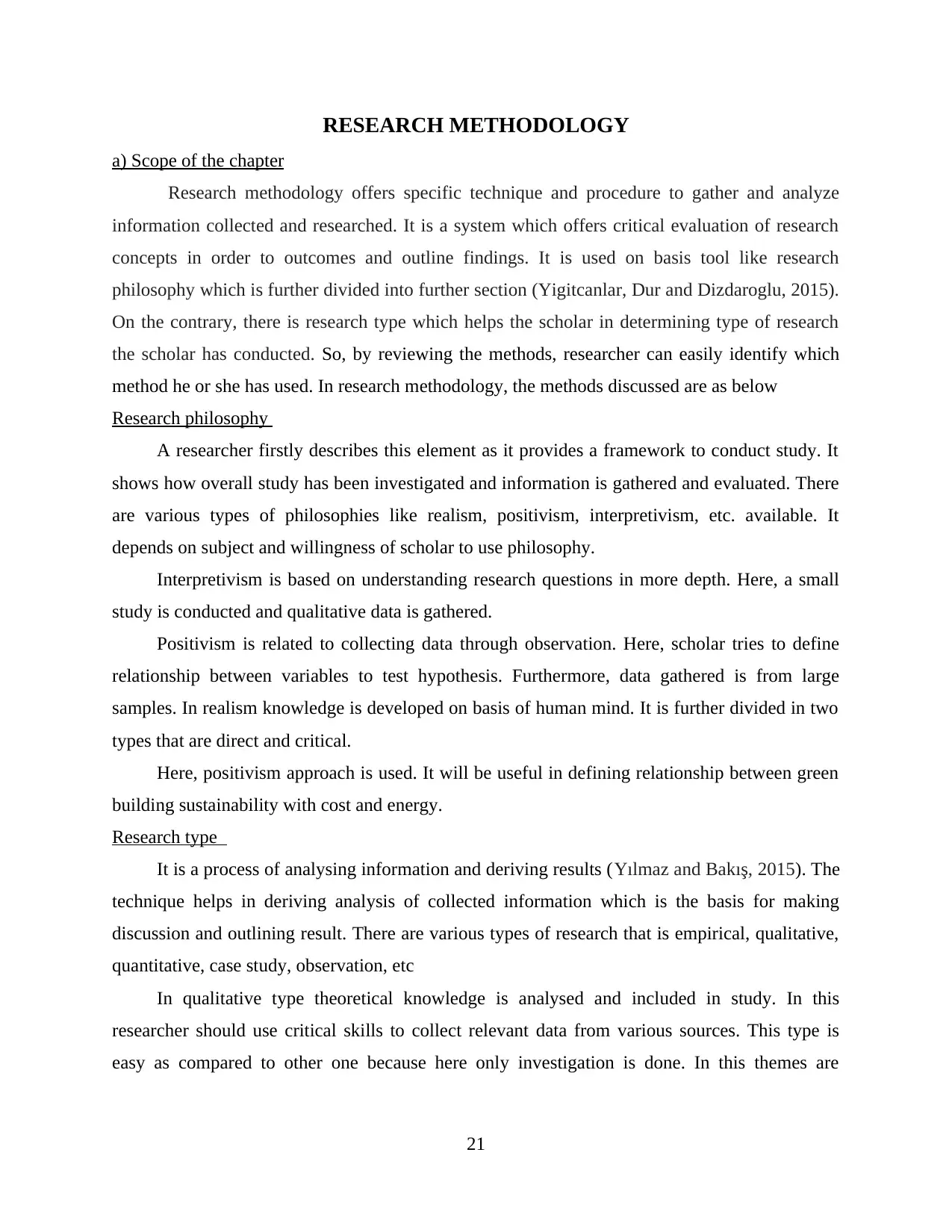
RESEARCH METHODOLOGY
a) Scope of the chapter
Research methodology offers specific technique and procedure to gather and analyze
information collected and researched. It is a system which offers critical evaluation of research
concepts in order to outcomes and outline findings. It is used on basis tool like research
philosophy which is further divided into further section (Yigitcanlar, Dur and Dizdaroglu, 2015).
On the contrary, there is research type which helps the scholar in determining type of research
the scholar has conducted. So, by reviewing the methods, researcher can easily identify which
method he or she has used. In research methodology, the methods discussed are as below
Research philosophy
A researcher firstly describes this element as it provides a framework to conduct study. It
shows how overall study has been investigated and information is gathered and evaluated. There
are various types of philosophies like realism, positivism, interpretivism, etc. available. It
depends on subject and willingness of scholar to use philosophy.
Interpretivism is based on understanding research questions in more depth. Here, a small
study is conducted and qualitative data is gathered.
Positivism is related to collecting data through observation. Here, scholar tries to define
relationship between variables to test hypothesis. Furthermore, data gathered is from large
samples. In realism knowledge is developed on basis of human mind. It is further divided in two
types that are direct and critical.
Here, positivism approach is used. It will be useful in defining relationship between green
building sustainability with cost and energy.
Research type
It is a process of analysing information and deriving results (Yılmaz and Bakış, 2015). The
technique helps in deriving analysis of collected information which is the basis for making
discussion and outlining result. There are various types of research that is empirical, qualitative,
quantitative, case study, observation, etc
In qualitative type theoretical knowledge is analysed and included in study. In this
researcher should use critical skills to collect relevant data from various sources. This type is
easy as compared to other one because here only investigation is done. In this themes are
21
a) Scope of the chapter
Research methodology offers specific technique and procedure to gather and analyze
information collected and researched. It is a system which offers critical evaluation of research
concepts in order to outcomes and outline findings. It is used on basis tool like research
philosophy which is further divided into further section (Yigitcanlar, Dur and Dizdaroglu, 2015).
On the contrary, there is research type which helps the scholar in determining type of research
the scholar has conducted. So, by reviewing the methods, researcher can easily identify which
method he or she has used. In research methodology, the methods discussed are as below
Research philosophy
A researcher firstly describes this element as it provides a framework to conduct study. It
shows how overall study has been investigated and information is gathered and evaluated. There
are various types of philosophies like realism, positivism, interpretivism, etc. available. It
depends on subject and willingness of scholar to use philosophy.
Interpretivism is based on understanding research questions in more depth. Here, a small
study is conducted and qualitative data is gathered.
Positivism is related to collecting data through observation. Here, scholar tries to define
relationship between variables to test hypothesis. Furthermore, data gathered is from large
samples. In realism knowledge is developed on basis of human mind. It is further divided in two
types that are direct and critical.
Here, positivism approach is used. It will be useful in defining relationship between green
building sustainability with cost and energy.
Research type
It is a process of analysing information and deriving results (Yılmaz and Bakış, 2015). The
technique helps in deriving analysis of collected information which is the basis for making
discussion and outlining result. There are various types of research that is empirical, qualitative,
quantitative, case study, observation, etc
In qualitative type theoretical knowledge is analysed and included in study. In this
researcher should use critical skills to collect relevant data from various sources. This type is
easy as compared to other one because here only investigation is done. In this themes are
21
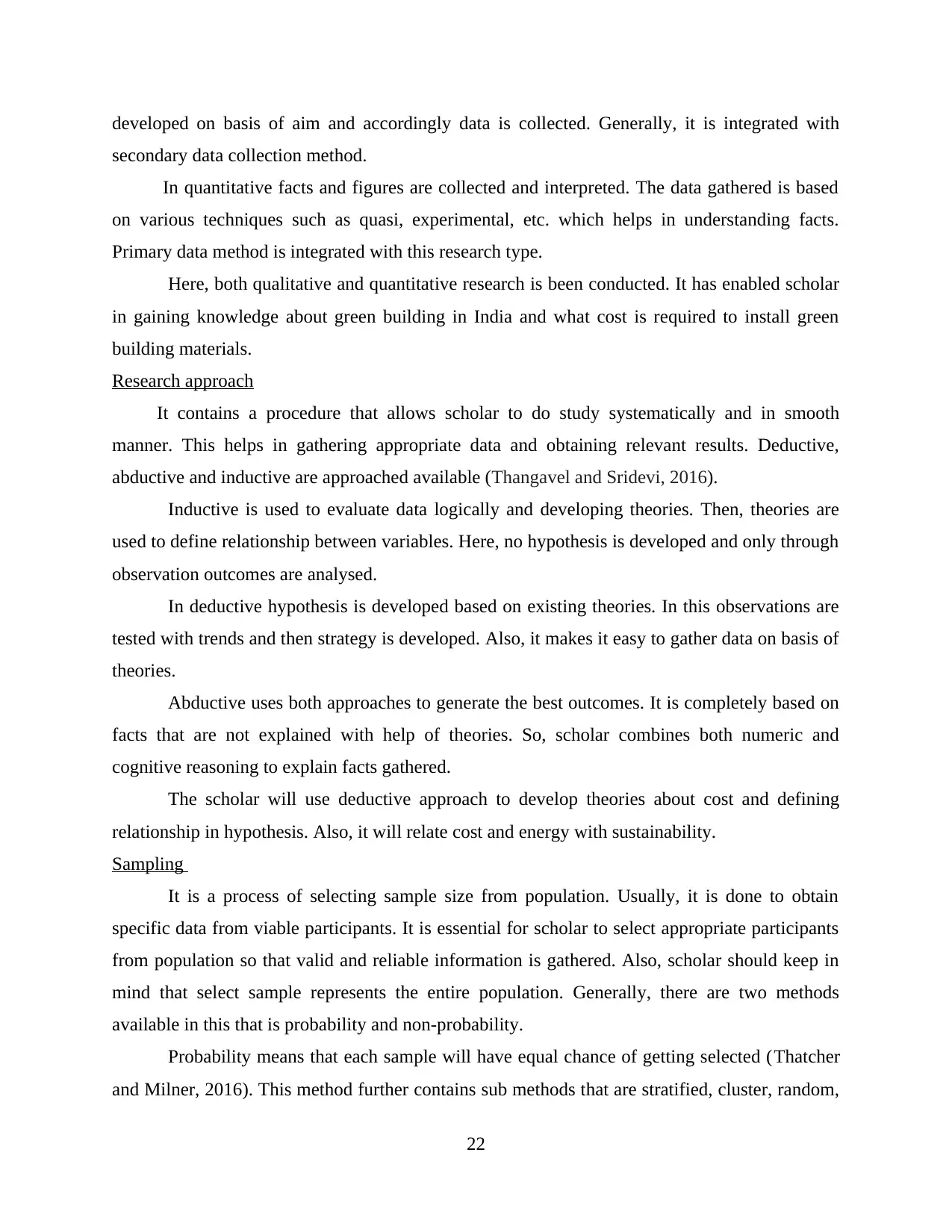
developed on basis of aim and accordingly data is collected. Generally, it is integrated with
secondary data collection method.
In quantitative facts and figures are collected and interpreted. The data gathered is based
on various techniques such as quasi, experimental, etc. which helps in understanding facts.
Primary data method is integrated with this research type.
Here, both qualitative and quantitative research is been conducted. It has enabled scholar
in gaining knowledge about green building in India and what cost is required to install green
building materials.
Research approach
It contains a procedure that allows scholar to do study systematically and in smooth
manner. This helps in gathering appropriate data and obtaining relevant results. Deductive,
abductive and inductive are approached available (Thangavel and Sridevi, 2016).
Inductive is used to evaluate data logically and developing theories. Then, theories are
used to define relationship between variables. Here, no hypothesis is developed and only through
observation outcomes are analysed.
In deductive hypothesis is developed based on existing theories. In this observations are
tested with trends and then strategy is developed. Also, it makes it easy to gather data on basis of
theories.
Abductive uses both approaches to generate the best outcomes. It is completely based on
facts that are not explained with help of theories. So, scholar combines both numeric and
cognitive reasoning to explain facts gathered.
The scholar will use deductive approach to develop theories about cost and defining
relationship in hypothesis. Also, it will relate cost and energy with sustainability.
Sampling
It is a process of selecting sample size from population. Usually, it is done to obtain
specific data from viable participants. It is essential for scholar to select appropriate participants
from population so that valid and reliable information is gathered. Also, scholar should keep in
mind that select sample represents the entire population. Generally, there are two methods
available in this that is probability and non-probability.
Probability means that each sample will have equal chance of getting selected (Thatcher
and Milner, 2016). This method further contains sub methods that are stratified, cluster, random,
22
secondary data collection method.
In quantitative facts and figures are collected and interpreted. The data gathered is based
on various techniques such as quasi, experimental, etc. which helps in understanding facts.
Primary data method is integrated with this research type.
Here, both qualitative and quantitative research is been conducted. It has enabled scholar
in gaining knowledge about green building in India and what cost is required to install green
building materials.
Research approach
It contains a procedure that allows scholar to do study systematically and in smooth
manner. This helps in gathering appropriate data and obtaining relevant results. Deductive,
abductive and inductive are approached available (Thangavel and Sridevi, 2016).
Inductive is used to evaluate data logically and developing theories. Then, theories are
used to define relationship between variables. Here, no hypothesis is developed and only through
observation outcomes are analysed.
In deductive hypothesis is developed based on existing theories. In this observations are
tested with trends and then strategy is developed. Also, it makes it easy to gather data on basis of
theories.
Abductive uses both approaches to generate the best outcomes. It is completely based on
facts that are not explained with help of theories. So, scholar combines both numeric and
cognitive reasoning to explain facts gathered.
The scholar will use deductive approach to develop theories about cost and defining
relationship in hypothesis. Also, it will relate cost and energy with sustainability.
Sampling
It is a process of selecting sample size from population. Usually, it is done to obtain
specific data from viable participants. It is essential for scholar to select appropriate participants
from population so that valid and reliable information is gathered. Also, scholar should keep in
mind that select sample represents the entire population. Generally, there are two methods
available in this that is probability and non-probability.
Probability means that each sample will have equal chance of getting selected (Thatcher
and Milner, 2016). This method further contains sub methods that are stratified, cluster, random,
22
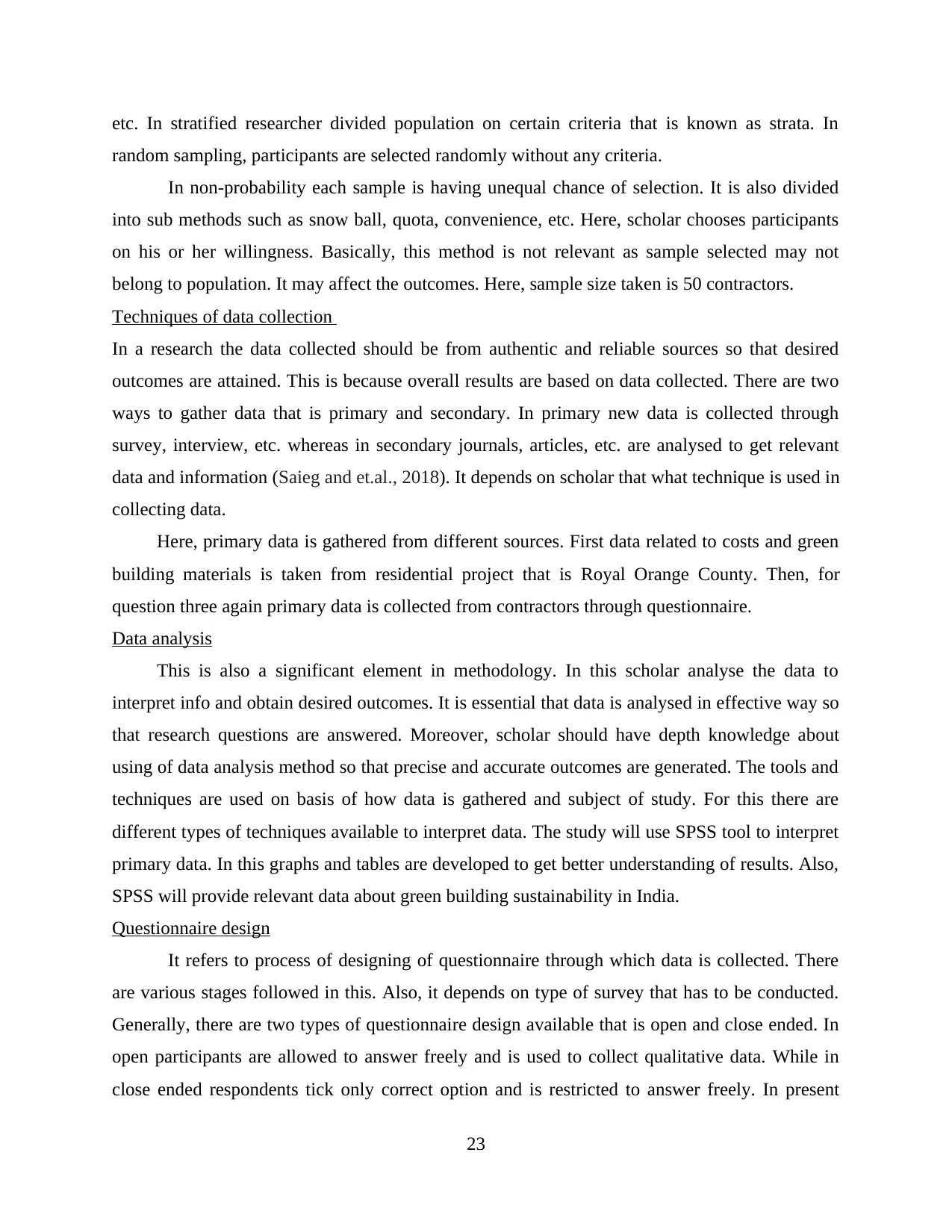
etc. In stratified researcher divided population on certain criteria that is known as strata. In
random sampling, participants are selected randomly without any criteria.
In non-probability each sample is having unequal chance of selection. It is also divided
into sub methods such as snow ball, quota, convenience, etc. Here, scholar chooses participants
on his or her willingness. Basically, this method is not relevant as sample selected may not
belong to population. It may affect the outcomes. Here, sample size taken is 50 contractors.
Techniques of data collection
In a research the data collected should be from authentic and reliable sources so that desired
outcomes are attained. This is because overall results are based on data collected. There are two
ways to gather data that is primary and secondary. In primary new data is collected through
survey, interview, etc. whereas in secondary journals, articles, etc. are analysed to get relevant
data and information (Saieg and et.al., 2018). It depends on scholar that what technique is used in
collecting data.
Here, primary data is gathered from different sources. First data related to costs and green
building materials is taken from residential project that is Royal Orange County. Then, for
question three again primary data is collected from contractors through questionnaire.
Data analysis
This is also a significant element in methodology. In this scholar analyse the data to
interpret info and obtain desired outcomes. It is essential that data is analysed in effective way so
that research questions are answered. Moreover, scholar should have depth knowledge about
using of data analysis method so that precise and accurate outcomes are generated. The tools and
techniques are used on basis of how data is gathered and subject of study. For this there are
different types of techniques available to interpret data. The study will use SPSS tool to interpret
primary data. In this graphs and tables are developed to get better understanding of results. Also,
SPSS will provide relevant data about green building sustainability in India.
Questionnaire design
It refers to process of designing of questionnaire through which data is collected. There
are various stages followed in this. Also, it depends on type of survey that has to be conducted.
Generally, there are two types of questionnaire design available that is open and close ended. In
open participants are allowed to answer freely and is used to collect qualitative data. While in
close ended respondents tick only correct option and is restricted to answer freely. In present
23
random sampling, participants are selected randomly without any criteria.
In non-probability each sample is having unequal chance of selection. It is also divided
into sub methods such as snow ball, quota, convenience, etc. Here, scholar chooses participants
on his or her willingness. Basically, this method is not relevant as sample selected may not
belong to population. It may affect the outcomes. Here, sample size taken is 50 contractors.
Techniques of data collection
In a research the data collected should be from authentic and reliable sources so that desired
outcomes are attained. This is because overall results are based on data collected. There are two
ways to gather data that is primary and secondary. In primary new data is collected through
survey, interview, etc. whereas in secondary journals, articles, etc. are analysed to get relevant
data and information (Saieg and et.al., 2018). It depends on scholar that what technique is used in
collecting data.
Here, primary data is gathered from different sources. First data related to costs and green
building materials is taken from residential project that is Royal Orange County. Then, for
question three again primary data is collected from contractors through questionnaire.
Data analysis
This is also a significant element in methodology. In this scholar analyse the data to
interpret info and obtain desired outcomes. It is essential that data is analysed in effective way so
that research questions are answered. Moreover, scholar should have depth knowledge about
using of data analysis method so that precise and accurate outcomes are generated. The tools and
techniques are used on basis of how data is gathered and subject of study. For this there are
different types of techniques available to interpret data. The study will use SPSS tool to interpret
primary data. In this graphs and tables are developed to get better understanding of results. Also,
SPSS will provide relevant data about green building sustainability in India.
Questionnaire design
It refers to process of designing of questionnaire through which data is collected. There
are various stages followed in this. Also, it depends on type of survey that has to be conducted.
Generally, there are two types of questionnaire design available that is open and close ended. In
open participants are allowed to answer freely and is used to collect qualitative data. While in
close ended respondents tick only correct option and is restricted to answer freely. In present
23
Secure Best Marks with AI Grader
Need help grading? Try our AI Grader for instant feedback on your assignments.
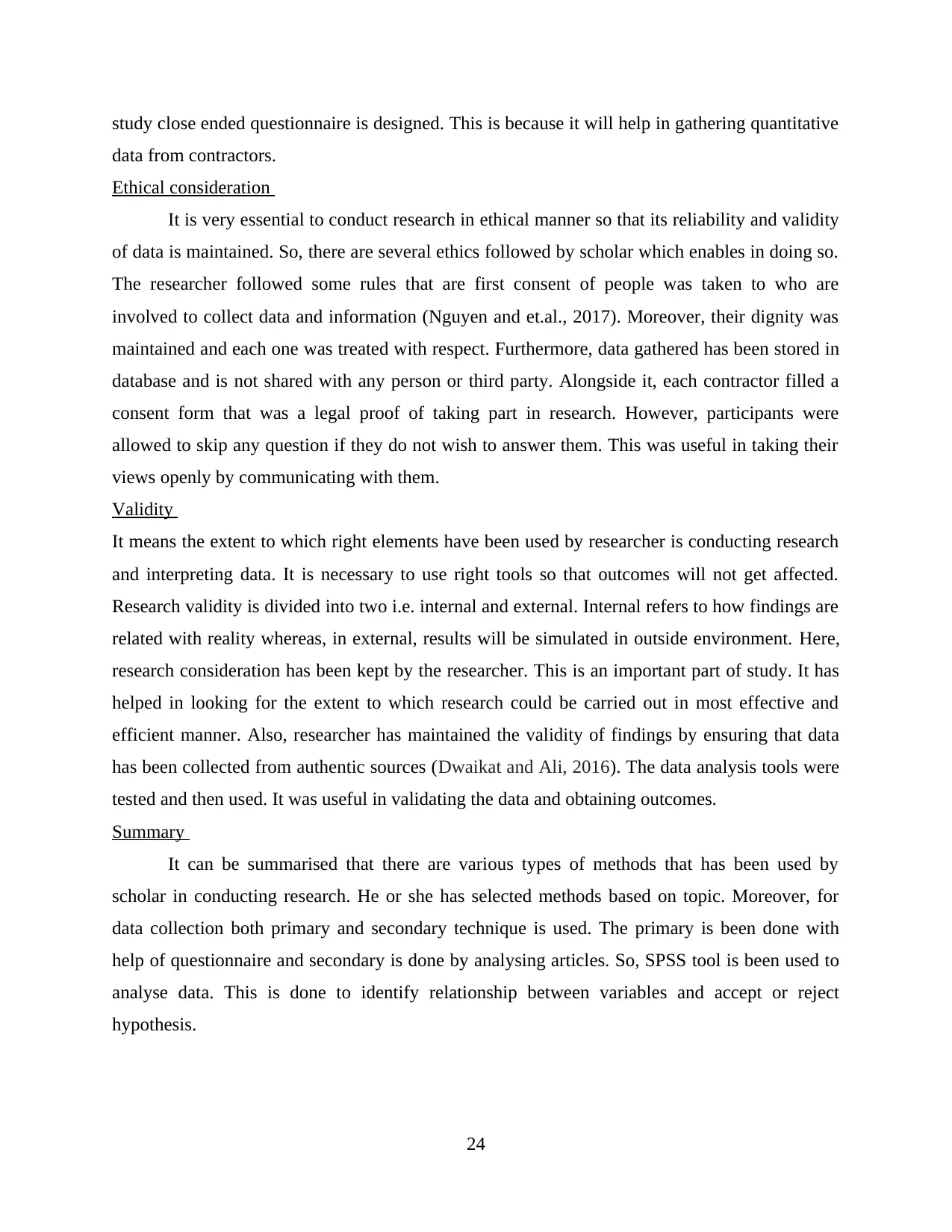
study close ended questionnaire is designed. This is because it will help in gathering quantitative
data from contractors.
Ethical consideration
It is very essential to conduct research in ethical manner so that its reliability and validity
of data is maintained. So, there are several ethics followed by scholar which enables in doing so.
The researcher followed some rules that are first consent of people was taken to who are
involved to collect data and information (Nguyen and et.al., 2017). Moreover, their dignity was
maintained and each one was treated with respect. Furthermore, data gathered has been stored in
database and is not shared with any person or third party. Alongside it, each contractor filled a
consent form that was a legal proof of taking part in research. However, participants were
allowed to skip any question if they do not wish to answer them. This was useful in taking their
views openly by communicating with them.
Validity
It means the extent to which right elements have been used by researcher is conducting research
and interpreting data. It is necessary to use right tools so that outcomes will not get affected.
Research validity is divided into two i.e. internal and external. Internal refers to how findings are
related with reality whereas, in external, results will be simulated in outside environment. Here,
research consideration has been kept by the researcher. This is an important part of study. It has
helped in looking for the extent to which research could be carried out in most effective and
efficient manner. Also, researcher has maintained the validity of findings by ensuring that data
has been collected from authentic sources (Dwaikat and Ali, 2016). The data analysis tools were
tested and then used. It was useful in validating the data and obtaining outcomes.
Summary
It can be summarised that there are various types of methods that has been used by
scholar in conducting research. He or she has selected methods based on topic. Moreover, for
data collection both primary and secondary technique is used. The primary is been done with
help of questionnaire and secondary is done by analysing articles. So, SPSS tool is been used to
analyse data. This is done to identify relationship between variables and accept or reject
hypothesis.
24
data from contractors.
Ethical consideration
It is very essential to conduct research in ethical manner so that its reliability and validity
of data is maintained. So, there are several ethics followed by scholar which enables in doing so.
The researcher followed some rules that are first consent of people was taken to who are
involved to collect data and information (Nguyen and et.al., 2017). Moreover, their dignity was
maintained and each one was treated with respect. Furthermore, data gathered has been stored in
database and is not shared with any person or third party. Alongside it, each contractor filled a
consent form that was a legal proof of taking part in research. However, participants were
allowed to skip any question if they do not wish to answer them. This was useful in taking their
views openly by communicating with them.
Validity
It means the extent to which right elements have been used by researcher is conducting research
and interpreting data. It is necessary to use right tools so that outcomes will not get affected.
Research validity is divided into two i.e. internal and external. Internal refers to how findings are
related with reality whereas, in external, results will be simulated in outside environment. Here,
research consideration has been kept by the researcher. This is an important part of study. It has
helped in looking for the extent to which research could be carried out in most effective and
efficient manner. Also, researcher has maintained the validity of findings by ensuring that data
has been collected from authentic sources (Dwaikat and Ali, 2016). The data analysis tools were
tested and then used. It was useful in validating the data and obtaining outcomes.
Summary
It can be summarised that there are various types of methods that has been used by
scholar in conducting research. He or she has selected methods based on topic. Moreover, for
data collection both primary and secondary technique is used. The primary is been done with
help of questionnaire and secondary is done by analysing articles. So, SPSS tool is been used to
analyse data. This is done to identify relationship between variables and accept or reject
hypothesis.
24
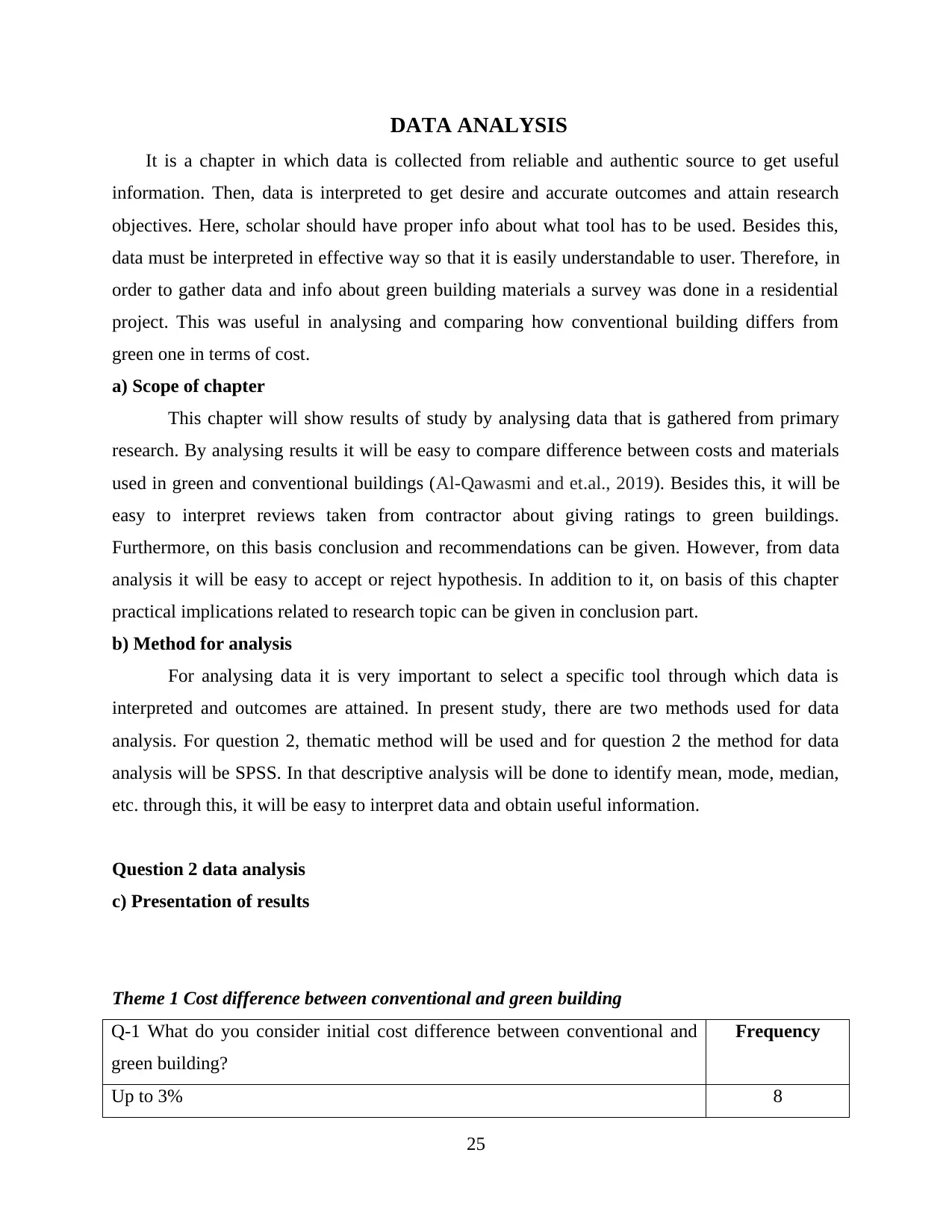
DATA ANALYSIS
It is a chapter in which data is collected from reliable and authentic source to get useful
information. Then, data is interpreted to get desire and accurate outcomes and attain research
objectives. Here, scholar should have proper info about what tool has to be used. Besides this,
data must be interpreted in effective way so that it is easily understandable to user. Therefore, in
order to gather data and info about green building materials a survey was done in a residential
project. This was useful in analysing and comparing how conventional building differs from
green one in terms of cost.
a) Scope of chapter
This chapter will show results of study by analysing data that is gathered from primary
research. By analysing results it will be easy to compare difference between costs and materials
used in green and conventional buildings (Al-Qawasmi and et.al., 2019). Besides this, it will be
easy to interpret reviews taken from contractor about giving ratings to green buildings.
Furthermore, on this basis conclusion and recommendations can be given. However, from data
analysis it will be easy to accept or reject hypothesis. In addition to it, on basis of this chapter
practical implications related to research topic can be given in conclusion part.
b) Method for analysis
For analysing data it is very important to select a specific tool through which data is
interpreted and outcomes are attained. In present study, there are two methods used for data
analysis. For question 2, thematic method will be used and for question 2 the method for data
analysis will be SPSS. In that descriptive analysis will be done to identify mean, mode, median,
etc. through this, it will be easy to interpret data and obtain useful information.
Question 2 data analysis
c) Presentation of results
Theme 1 Cost difference between conventional and green building
Q-1 What do you consider initial cost difference between conventional and
green building?
Frequency
Up to 3% 8
25
It is a chapter in which data is collected from reliable and authentic source to get useful
information. Then, data is interpreted to get desire and accurate outcomes and attain research
objectives. Here, scholar should have proper info about what tool has to be used. Besides this,
data must be interpreted in effective way so that it is easily understandable to user. Therefore, in
order to gather data and info about green building materials a survey was done in a residential
project. This was useful in analysing and comparing how conventional building differs from
green one in terms of cost.
a) Scope of chapter
This chapter will show results of study by analysing data that is gathered from primary
research. By analysing results it will be easy to compare difference between costs and materials
used in green and conventional buildings (Al-Qawasmi and et.al., 2019). Besides this, it will be
easy to interpret reviews taken from contractor about giving ratings to green buildings.
Furthermore, on this basis conclusion and recommendations can be given. However, from data
analysis it will be easy to accept or reject hypothesis. In addition to it, on basis of this chapter
practical implications related to research topic can be given in conclusion part.
b) Method for analysis
For analysing data it is very important to select a specific tool through which data is
interpreted and outcomes are attained. In present study, there are two methods used for data
analysis. For question 2, thematic method will be used and for question 2 the method for data
analysis will be SPSS. In that descriptive analysis will be done to identify mean, mode, median,
etc. through this, it will be easy to interpret data and obtain useful information.
Question 2 data analysis
c) Presentation of results
Theme 1 Cost difference between conventional and green building
Q-1 What do you consider initial cost difference between conventional and
green building?
Frequency
Up to 3% 8
25
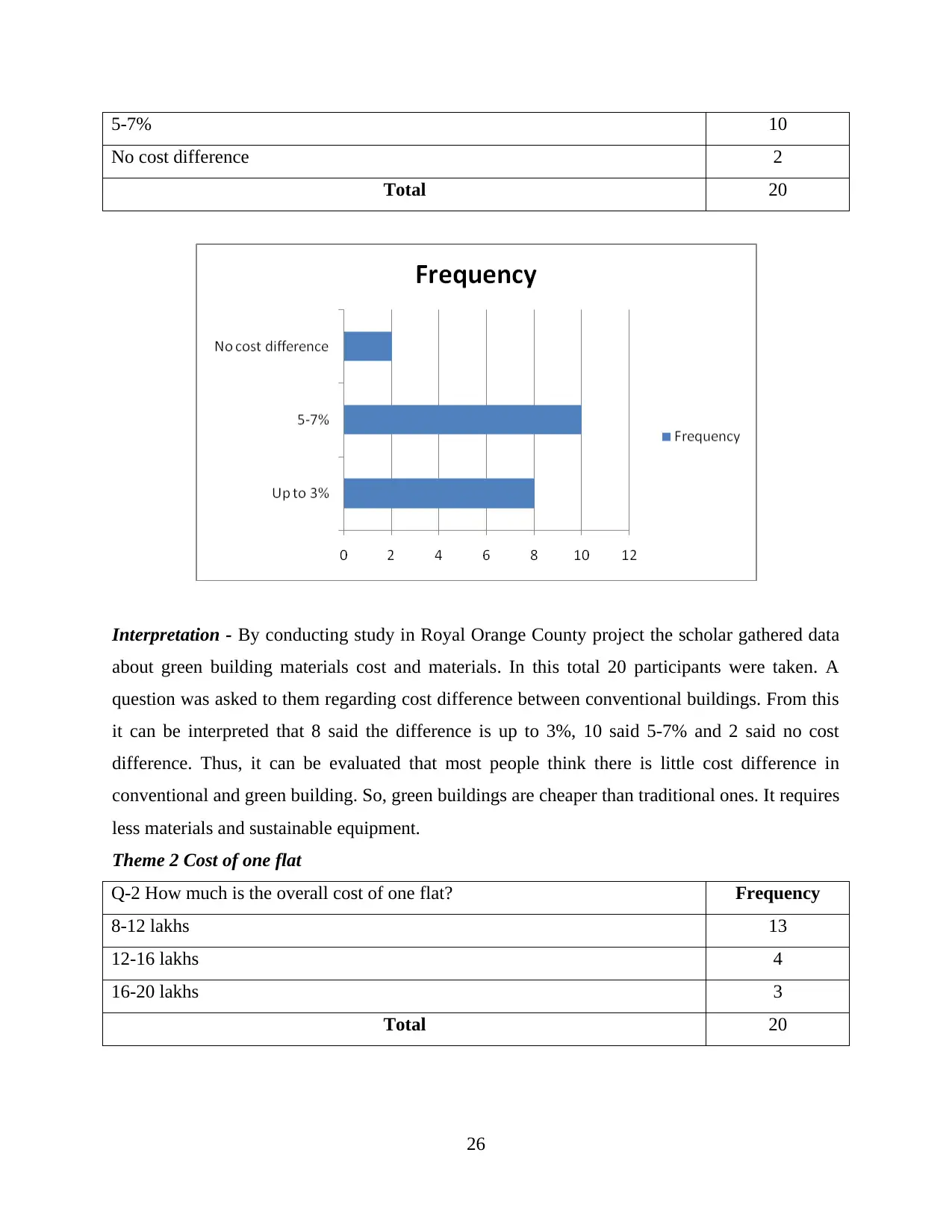
5-7% 10
No cost difference 2
Total 20
Interpretation - By conducting study in Royal Orange County project the scholar gathered data
about green building materials cost and materials. In this total 20 participants were taken. A
question was asked to them regarding cost difference between conventional buildings. From this
it can be interpreted that 8 said the difference is up to 3%, 10 said 5-7% and 2 said no cost
difference. Thus, it can be evaluated that most people think there is little cost difference in
conventional and green building. So, green buildings are cheaper than traditional ones. It requires
less materials and sustainable equipment.
Theme 2 Cost of one flat
Q-2 How much is the overall cost of one flat? Frequency
8-12 lakhs 13
12-16 lakhs 4
16-20 lakhs 3
Total 20
26
No cost difference 2
Total 20
Interpretation - By conducting study in Royal Orange County project the scholar gathered data
about green building materials cost and materials. In this total 20 participants were taken. A
question was asked to them regarding cost difference between conventional buildings. From this
it can be interpreted that 8 said the difference is up to 3%, 10 said 5-7% and 2 said no cost
difference. Thus, it can be evaluated that most people think there is little cost difference in
conventional and green building. So, green buildings are cheaper than traditional ones. It requires
less materials and sustainable equipment.
Theme 2 Cost of one flat
Q-2 How much is the overall cost of one flat? Frequency
8-12 lakhs 13
12-16 lakhs 4
16-20 lakhs 3
Total 20
26
Paraphrase This Document
Need a fresh take? Get an instant paraphrase of this document with our AI Paraphraser
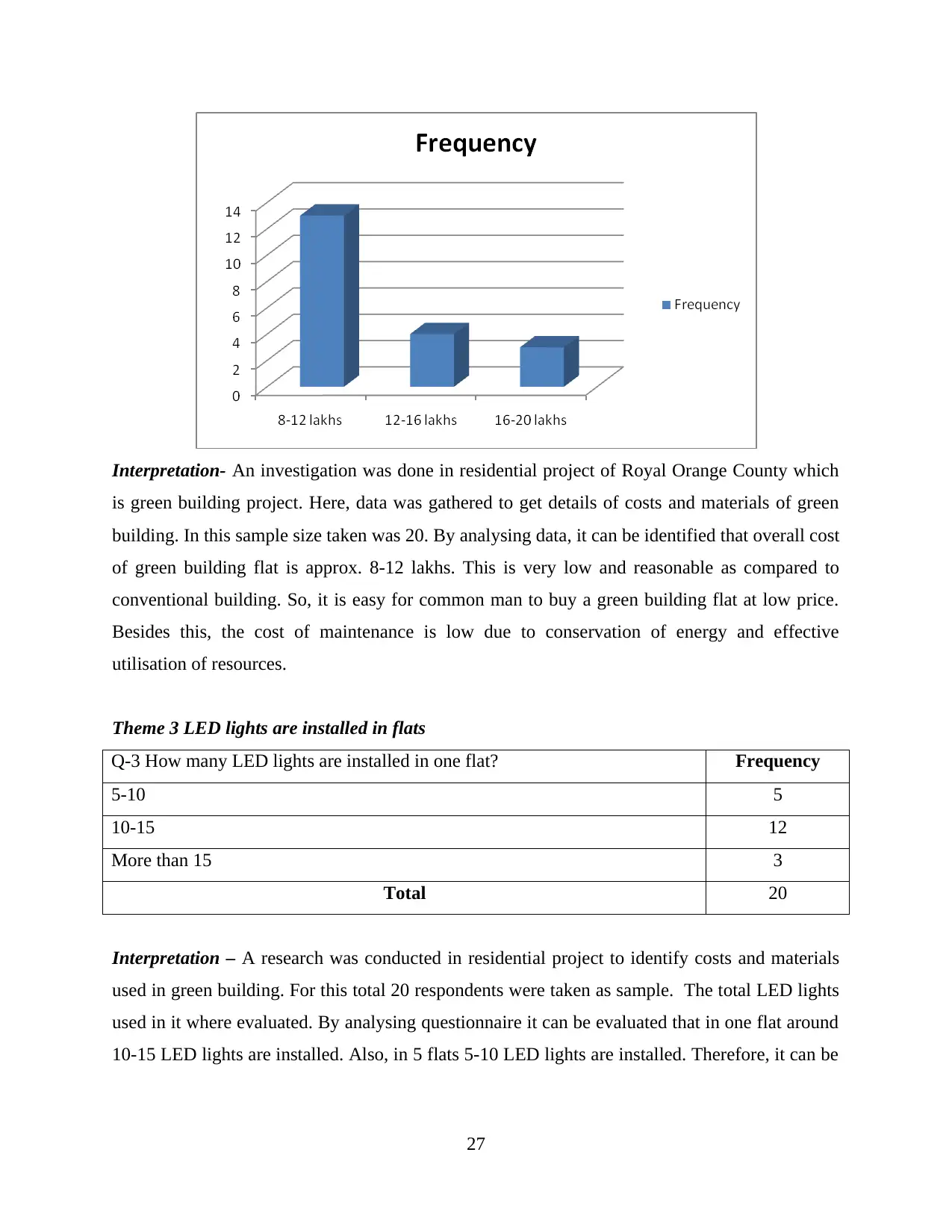
Interpretation- An investigation was done in residential project of Royal Orange County which
is green building project. Here, data was gathered to get details of costs and materials of green
building. In this sample size taken was 20. By analysing data, it can be identified that overall cost
of green building flat is approx. 8-12 lakhs. This is very low and reasonable as compared to
conventional building. So, it is easy for common man to buy a green building flat at low price.
Besides this, the cost of maintenance is low due to conservation of energy and effective
utilisation of resources.
Theme 3 LED lights are installed in flats
Q-3 How many LED lights are installed in one flat? Frequency
5-10 5
10-15 12
More than 15 3
Total 20
Interpretation – A research was conducted in residential project to identify costs and materials
used in green building. For this total 20 respondents were taken as sample. The total LED lights
used in it where evaluated. By analysing questionnaire it can be evaluated that in one flat around
10-15 LED lights are installed. Also, in 5 flats 5-10 LED lights are installed. Therefore, it can be
27
is green building project. Here, data was gathered to get details of costs and materials of green
building. In this sample size taken was 20. By analysing data, it can be identified that overall cost
of green building flat is approx. 8-12 lakhs. This is very low and reasonable as compared to
conventional building. So, it is easy for common man to buy a green building flat at low price.
Besides this, the cost of maintenance is low due to conservation of energy and effective
utilisation of resources.
Theme 3 LED lights are installed in flats
Q-3 How many LED lights are installed in one flat? Frequency
5-10 5
10-15 12
More than 15 3
Total 20
Interpretation – A research was conducted in residential project to identify costs and materials
used in green building. For this total 20 respondents were taken as sample. The total LED lights
used in it where evaluated. By analysing questionnaire it can be evaluated that in one flat around
10-15 LED lights are installed. Also, in 5 flats 5-10 LED lights are installed. Therefore, it can be
27
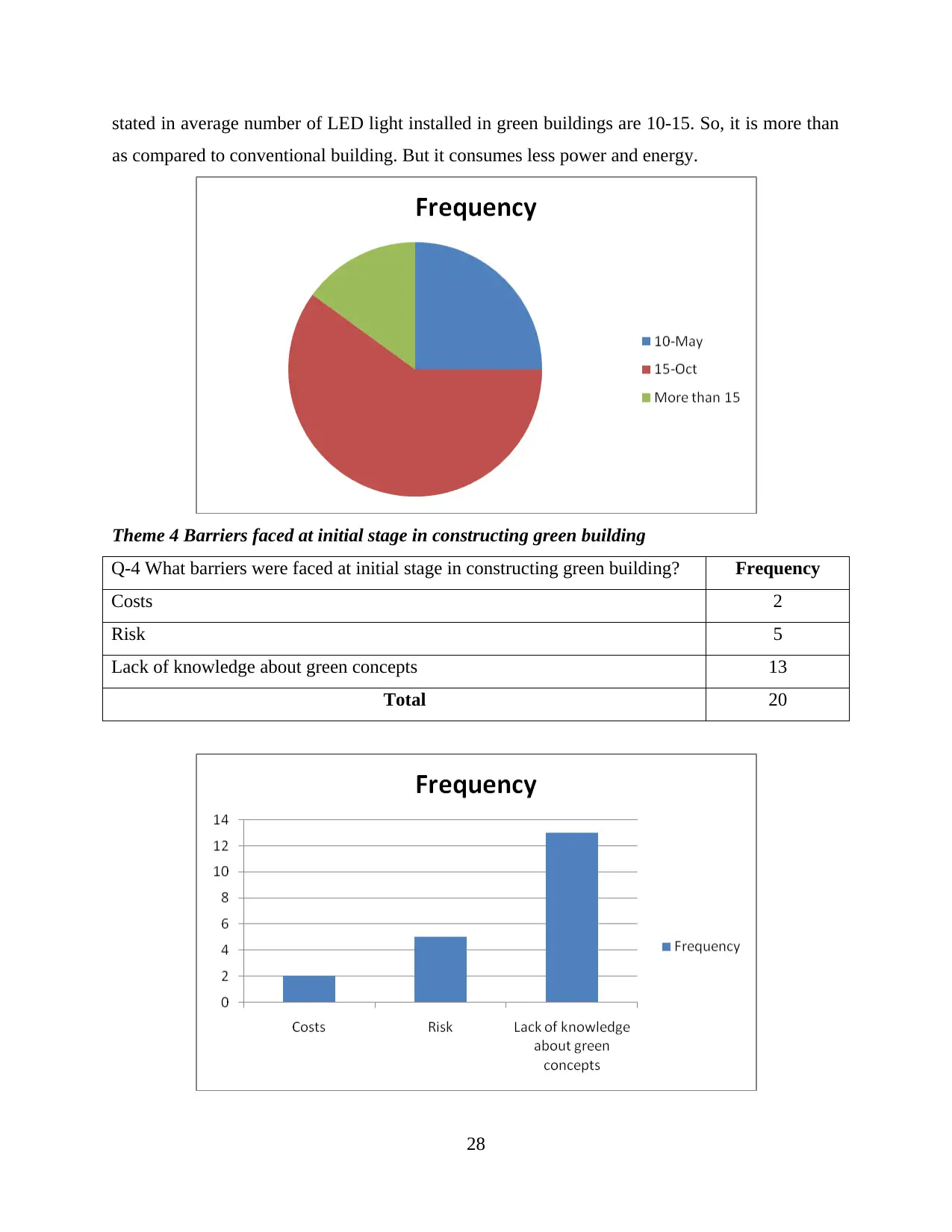
stated in average number of LED light installed in green buildings are 10-15. So, it is more than
as compared to conventional building. But it consumes less power and energy.
Theme 4 Barriers faced at initial stage in constructing green building
Q-4 What barriers were faced at initial stage in constructing green building? Frequency
Costs 2
Risk 5
Lack of knowledge about green concepts 13
Total 20
28
as compared to conventional building. But it consumes less power and energy.
Theme 4 Barriers faced at initial stage in constructing green building
Q-4 What barriers were faced at initial stage in constructing green building? Frequency
Costs 2
Risk 5
Lack of knowledge about green concepts 13
Total 20
28
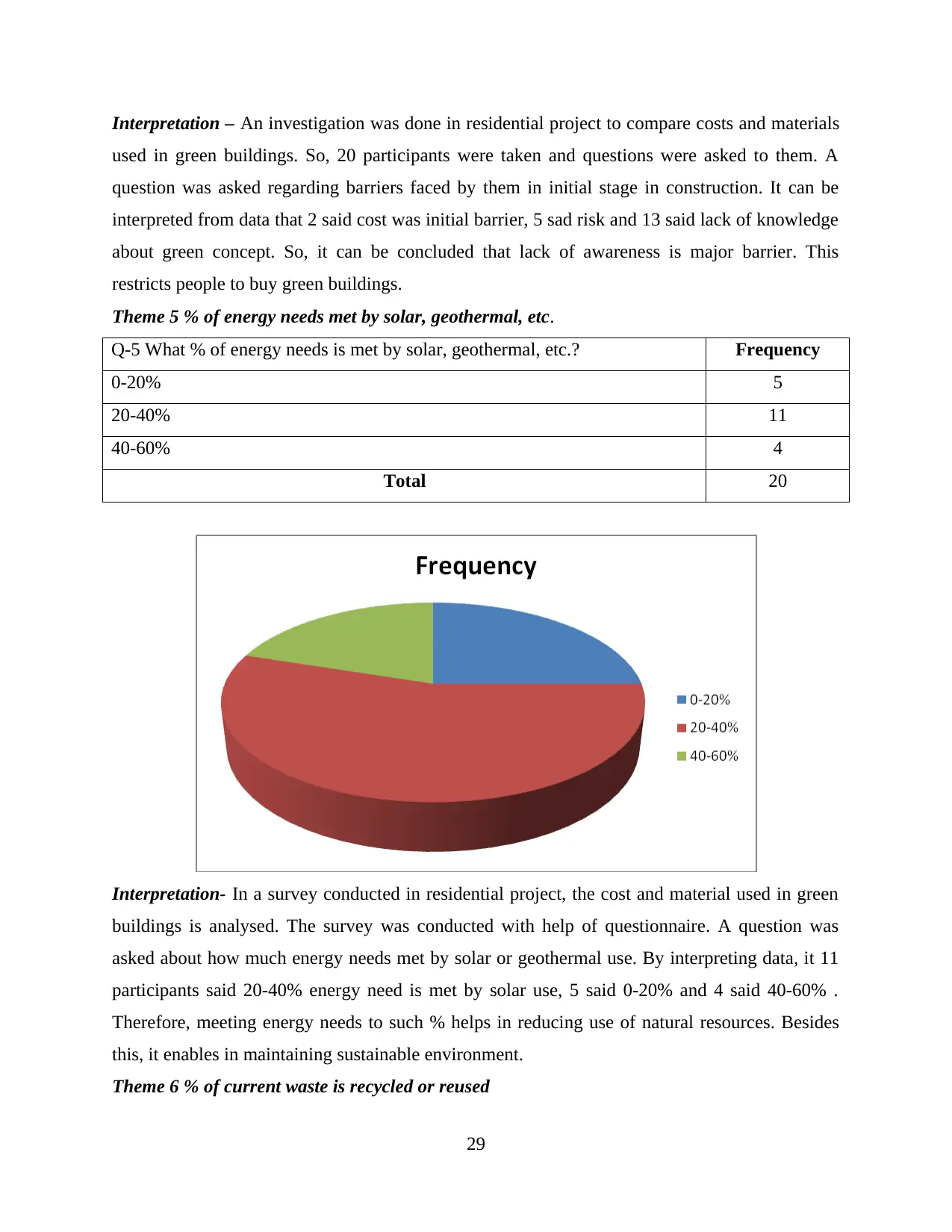
Interpretation – An investigation was done in residential project to compare costs and materials
used in green buildings. So, 20 participants were taken and questions were asked to them. A
question was asked regarding barriers faced by them in initial stage in construction. It can be
interpreted from data that 2 said cost was initial barrier, 5 sad risk and 13 said lack of knowledge
about green concept. So, it can be concluded that lack of awareness is major barrier. This
restricts people to buy green buildings.
Theme 5 % of energy needs met by solar, geothermal, etc.
Q-5 What % of energy needs is met by solar, geothermal, etc.? Frequency
0-20% 5
20-40% 11
40-60% 4
Total 20
Interpretation- In a survey conducted in residential project, the cost and material used in green
buildings is analysed. The survey was conducted with help of questionnaire. A question was
asked about how much energy needs met by solar or geothermal use. By interpreting data, it 11
participants said 20-40% energy need is met by solar use, 5 said 0-20% and 4 said 40-60% .
Therefore, meeting energy needs to such % helps in reducing use of natural resources. Besides
this, it enables in maintaining sustainable environment.
Theme 6 % of current waste is recycled or reused
29
used in green buildings. So, 20 participants were taken and questions were asked to them. A
question was asked regarding barriers faced by them in initial stage in construction. It can be
interpreted from data that 2 said cost was initial barrier, 5 sad risk and 13 said lack of knowledge
about green concept. So, it can be concluded that lack of awareness is major barrier. This
restricts people to buy green buildings.
Theme 5 % of energy needs met by solar, geothermal, etc.
Q-5 What % of energy needs is met by solar, geothermal, etc.? Frequency
0-20% 5
20-40% 11
40-60% 4
Total 20
Interpretation- In a survey conducted in residential project, the cost and material used in green
buildings is analysed. The survey was conducted with help of questionnaire. A question was
asked about how much energy needs met by solar or geothermal use. By interpreting data, it 11
participants said 20-40% energy need is met by solar use, 5 said 0-20% and 4 said 40-60% .
Therefore, meeting energy needs to such % helps in reducing use of natural resources. Besides
this, it enables in maintaining sustainable environment.
Theme 6 % of current waste is recycled or reused
29
Secure Best Marks with AI Grader
Need help grading? Try our AI Grader for instant feedback on your assignments.
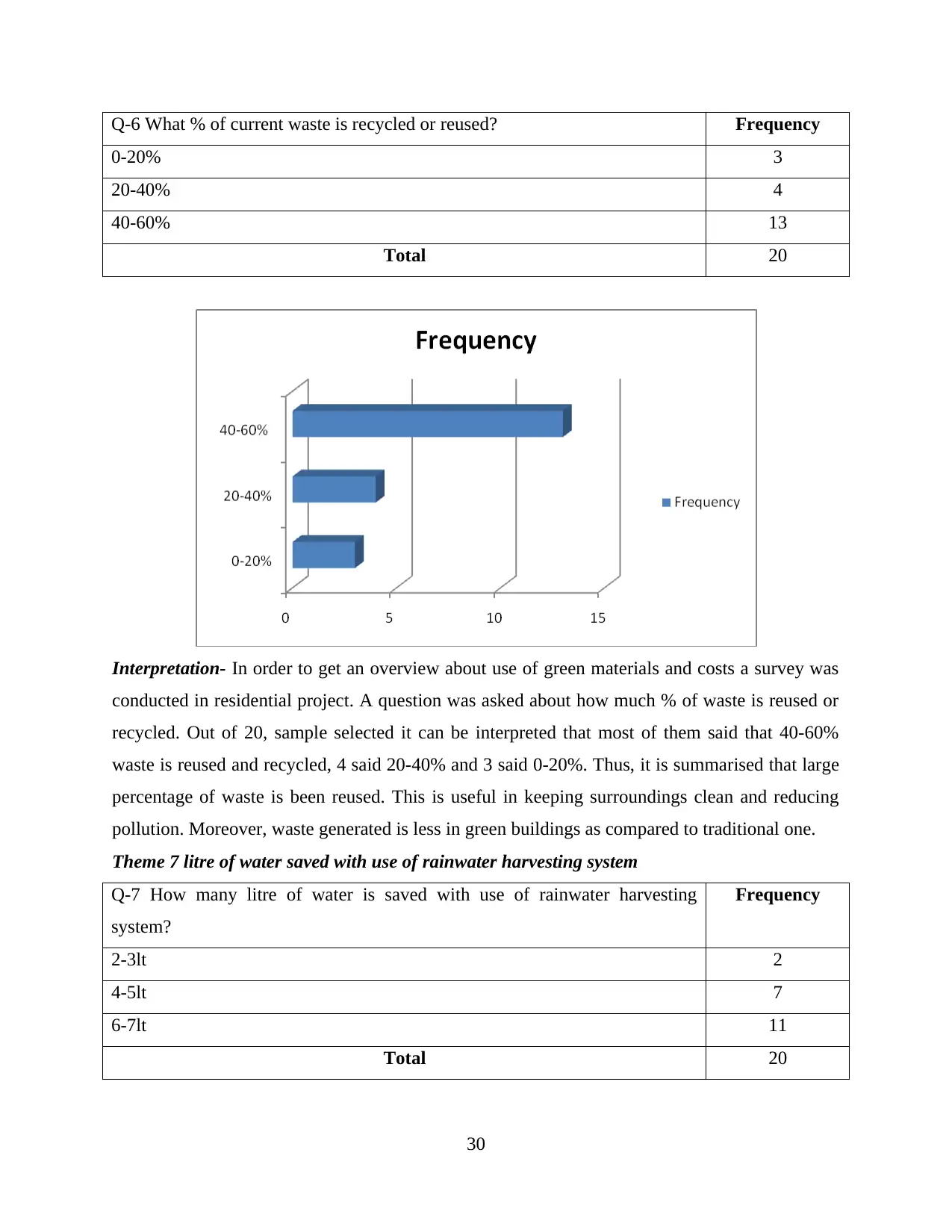
Q-6 What % of current waste is recycled or reused? Frequency
0-20% 3
20-40% 4
40-60% 13
Total 20
Interpretation- In order to get an overview about use of green materials and costs a survey was
conducted in residential project. A question was asked about how much % of waste is reused or
recycled. Out of 20, sample selected it can be interpreted that most of them said that 40-60%
waste is reused and recycled, 4 said 20-40% and 3 said 0-20%. Thus, it is summarised that large
percentage of waste is been reused. This is useful in keeping surroundings clean and reducing
pollution. Moreover, waste generated is less in green buildings as compared to traditional one.
Theme 7 litre of water saved with use of rainwater harvesting system
Q-7 How many litre of water is saved with use of rainwater harvesting
system?
Frequency
2-3lt 2
4-5lt 7
6-7lt 11
Total 20
30
0-20% 3
20-40% 4
40-60% 13
Total 20
Interpretation- In order to get an overview about use of green materials and costs a survey was
conducted in residential project. A question was asked about how much % of waste is reused or
recycled. Out of 20, sample selected it can be interpreted that most of them said that 40-60%
waste is reused and recycled, 4 said 20-40% and 3 said 0-20%. Thus, it is summarised that large
percentage of waste is been reused. This is useful in keeping surroundings clean and reducing
pollution. Moreover, waste generated is less in green buildings as compared to traditional one.
Theme 7 litre of water saved with use of rainwater harvesting system
Q-7 How many litre of water is saved with use of rainwater harvesting
system?
Frequency
2-3lt 2
4-5lt 7
6-7lt 11
Total 20
30
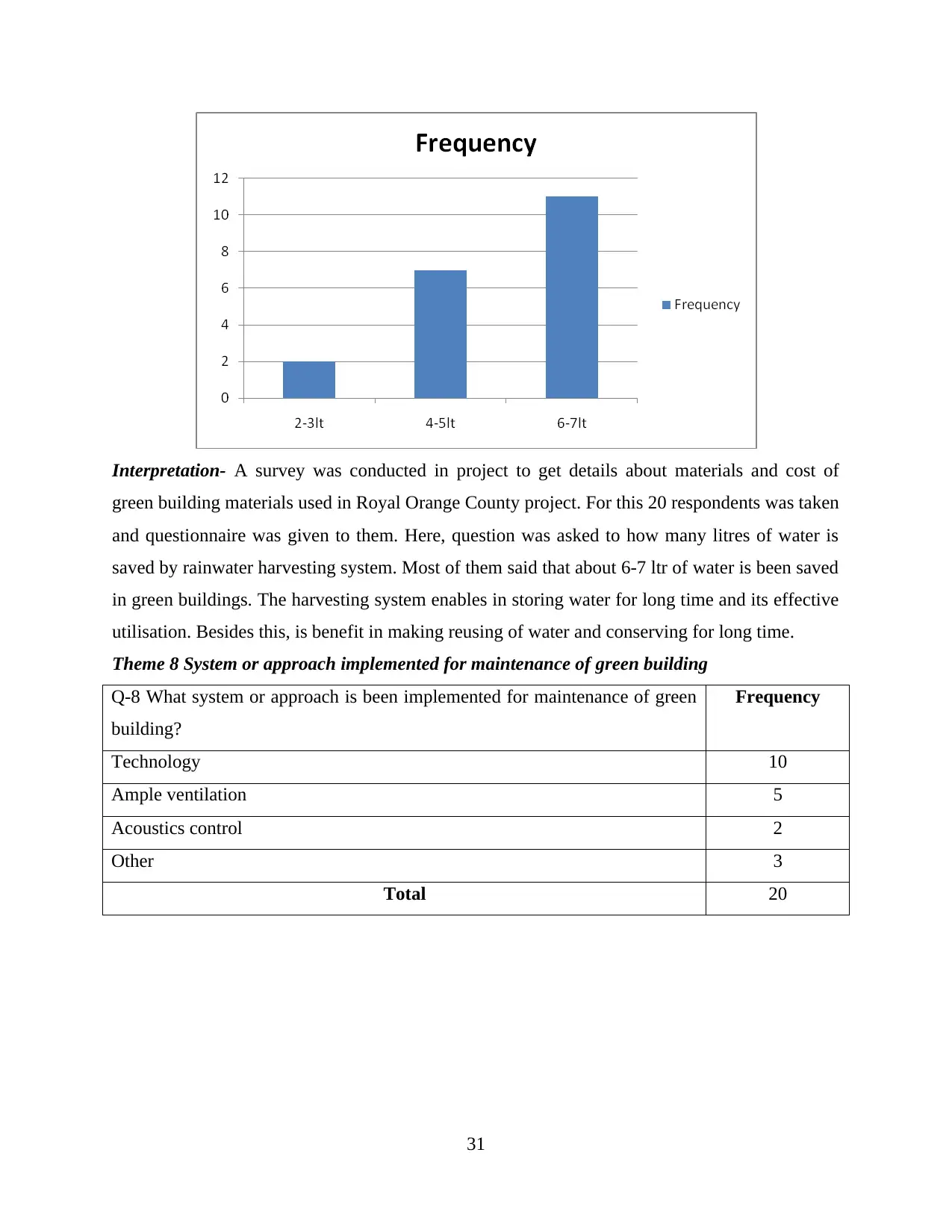
Interpretation- A survey was conducted in project to get details about materials and cost of
green building materials used in Royal Orange County project. For this 20 respondents was taken
and questionnaire was given to them. Here, question was asked to how many litres of water is
saved by rainwater harvesting system. Most of them said that about 6-7 ltr of water is been saved
in green buildings. The harvesting system enables in storing water for long time and its effective
utilisation. Besides this, is benefit in making reusing of water and conserving for long time.
Theme 8 System or approach implemented for maintenance of green building
Q-8 What system or approach is been implemented for maintenance of green
building?
Frequency
Technology 10
Ample ventilation 5
Acoustics control 2
Other 3
Total 20
31
green building materials used in Royal Orange County project. For this 20 respondents was taken
and questionnaire was given to them. Here, question was asked to how many litres of water is
saved by rainwater harvesting system. Most of them said that about 6-7 ltr of water is been saved
in green buildings. The harvesting system enables in storing water for long time and its effective
utilisation. Besides this, is benefit in making reusing of water and conserving for long time.
Theme 8 System or approach implemented for maintenance of green building
Q-8 What system or approach is been implemented for maintenance of green
building?
Frequency
Technology 10
Ample ventilation 5
Acoustics control 2
Other 3
Total 20
31
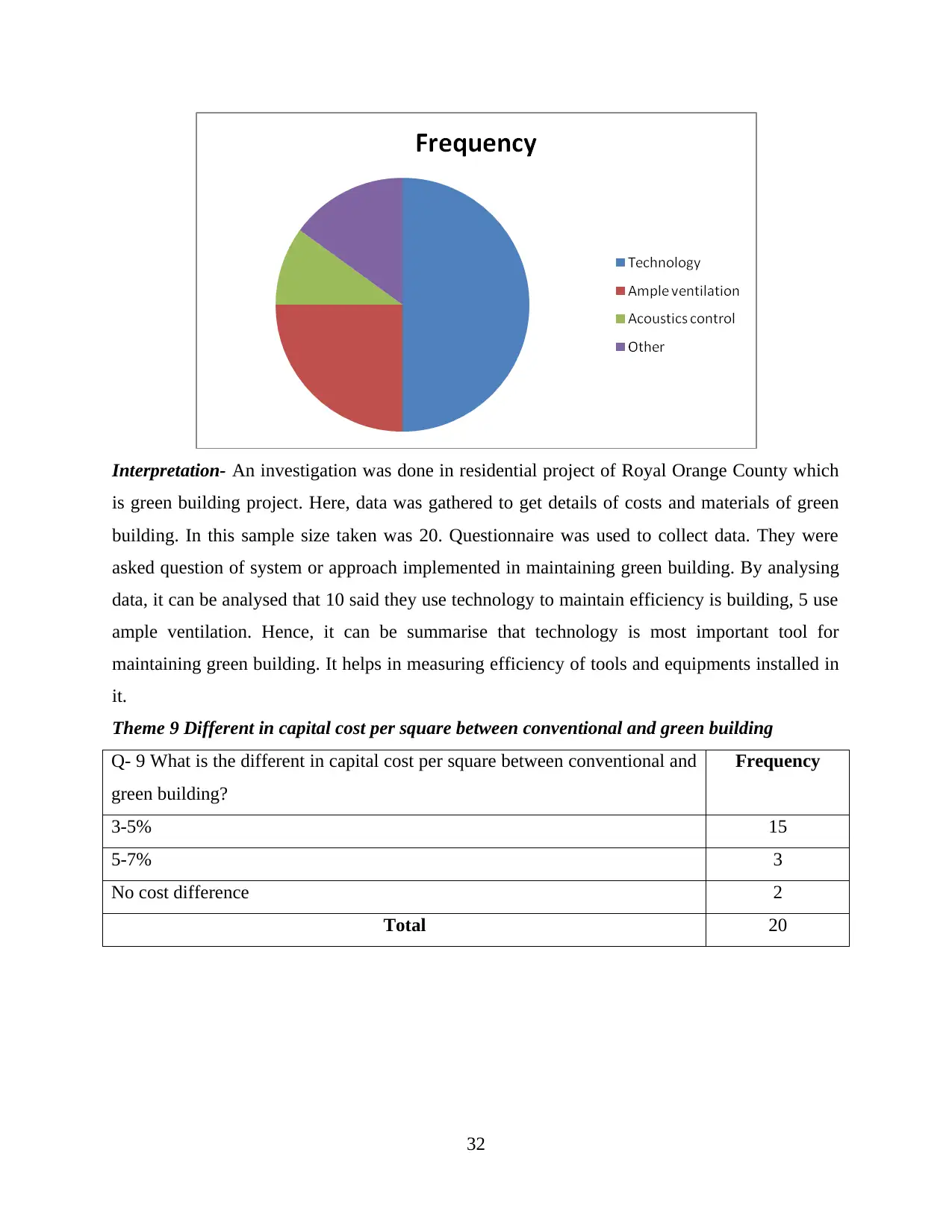
Interpretation- An investigation was done in residential project of Royal Orange County which
is green building project. Here, data was gathered to get details of costs and materials of green
building. In this sample size taken was 20. Questionnaire was used to collect data. They were
asked question of system or approach implemented in maintaining green building. By analysing
data, it can be analysed that 10 said they use technology to maintain efficiency is building, 5 use
ample ventilation. Hence, it can be summarise that technology is most important tool for
maintaining green building. It helps in measuring efficiency of tools and equipments installed in
it.
Theme 9 Different in capital cost per square between conventional and green building
Q- 9 What is the different in capital cost per square between conventional and
green building?
Frequency
3-5% 15
5-7% 3
No cost difference 2
Total 20
32
is green building project. Here, data was gathered to get details of costs and materials of green
building. In this sample size taken was 20. Questionnaire was used to collect data. They were
asked question of system or approach implemented in maintaining green building. By analysing
data, it can be analysed that 10 said they use technology to maintain efficiency is building, 5 use
ample ventilation. Hence, it can be summarise that technology is most important tool for
maintaining green building. It helps in measuring efficiency of tools and equipments installed in
it.
Theme 9 Different in capital cost per square between conventional and green building
Q- 9 What is the different in capital cost per square between conventional and
green building?
Frequency
3-5% 15
5-7% 3
No cost difference 2
Total 20
32
Paraphrase This Document
Need a fresh take? Get an instant paraphrase of this document with our AI Paraphraser
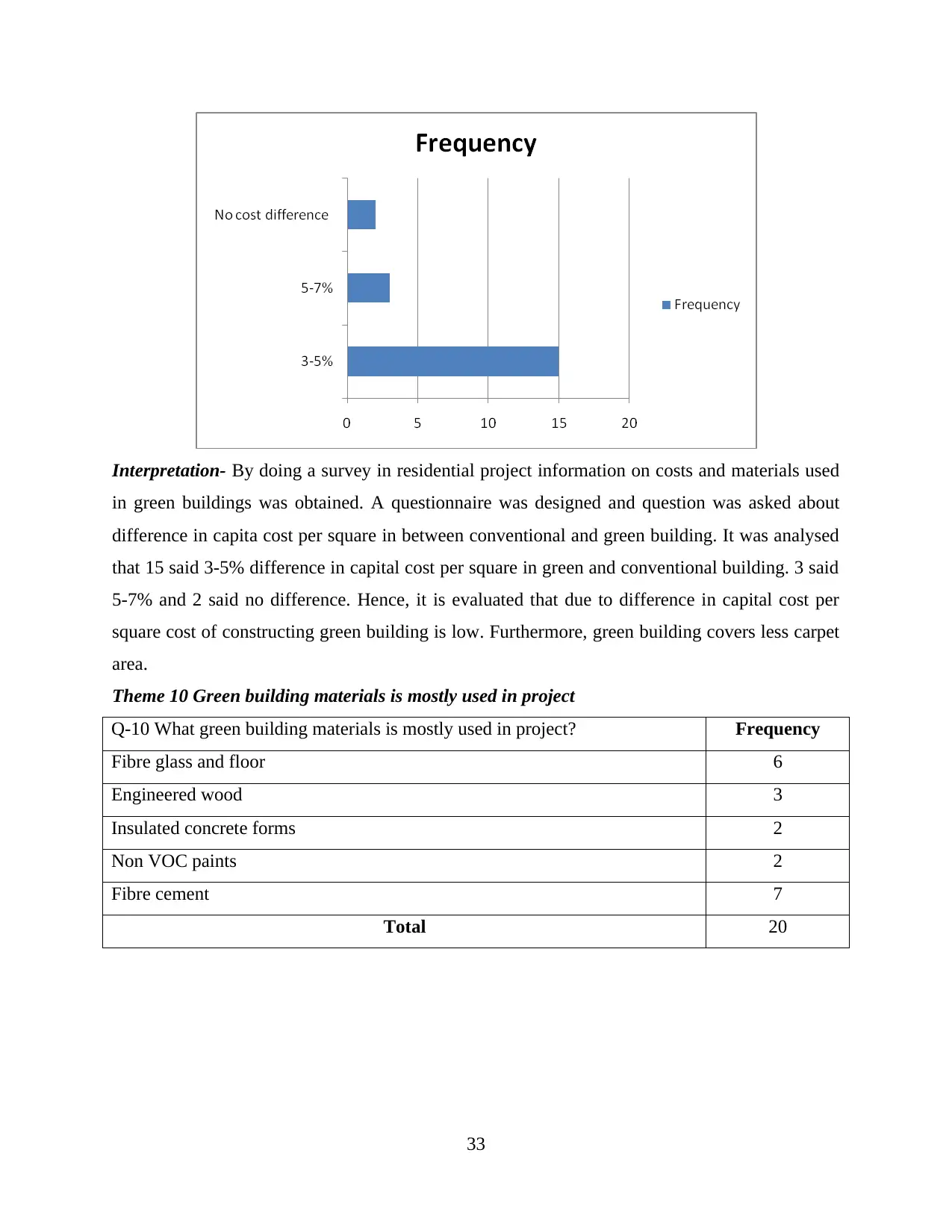
Interpretation- By doing a survey in residential project information on costs and materials used
in green buildings was obtained. A questionnaire was designed and question was asked about
difference in capita cost per square in between conventional and green building. It was analysed
that 15 said 3-5% difference in capital cost per square in green and conventional building. 3 said
5-7% and 2 said no difference. Hence, it is evaluated that due to difference in capital cost per
square cost of constructing green building is low. Furthermore, green building covers less carpet
area.
Theme 10 Green building materials is mostly used in project
Q-10 What green building materials is mostly used in project? Frequency
Fibre glass and floor 6
Engineered wood 3
Insulated concrete forms 2
Non VOC paints 2
Fibre cement 7
Total 20
33
in green buildings was obtained. A questionnaire was designed and question was asked about
difference in capita cost per square in between conventional and green building. It was analysed
that 15 said 3-5% difference in capital cost per square in green and conventional building. 3 said
5-7% and 2 said no difference. Hence, it is evaluated that due to difference in capital cost per
square cost of constructing green building is low. Furthermore, green building covers less carpet
area.
Theme 10 Green building materials is mostly used in project
Q-10 What green building materials is mostly used in project? Frequency
Fibre glass and floor 6
Engineered wood 3
Insulated concrete forms 2
Non VOC paints 2
Fibre cement 7
Total 20
33
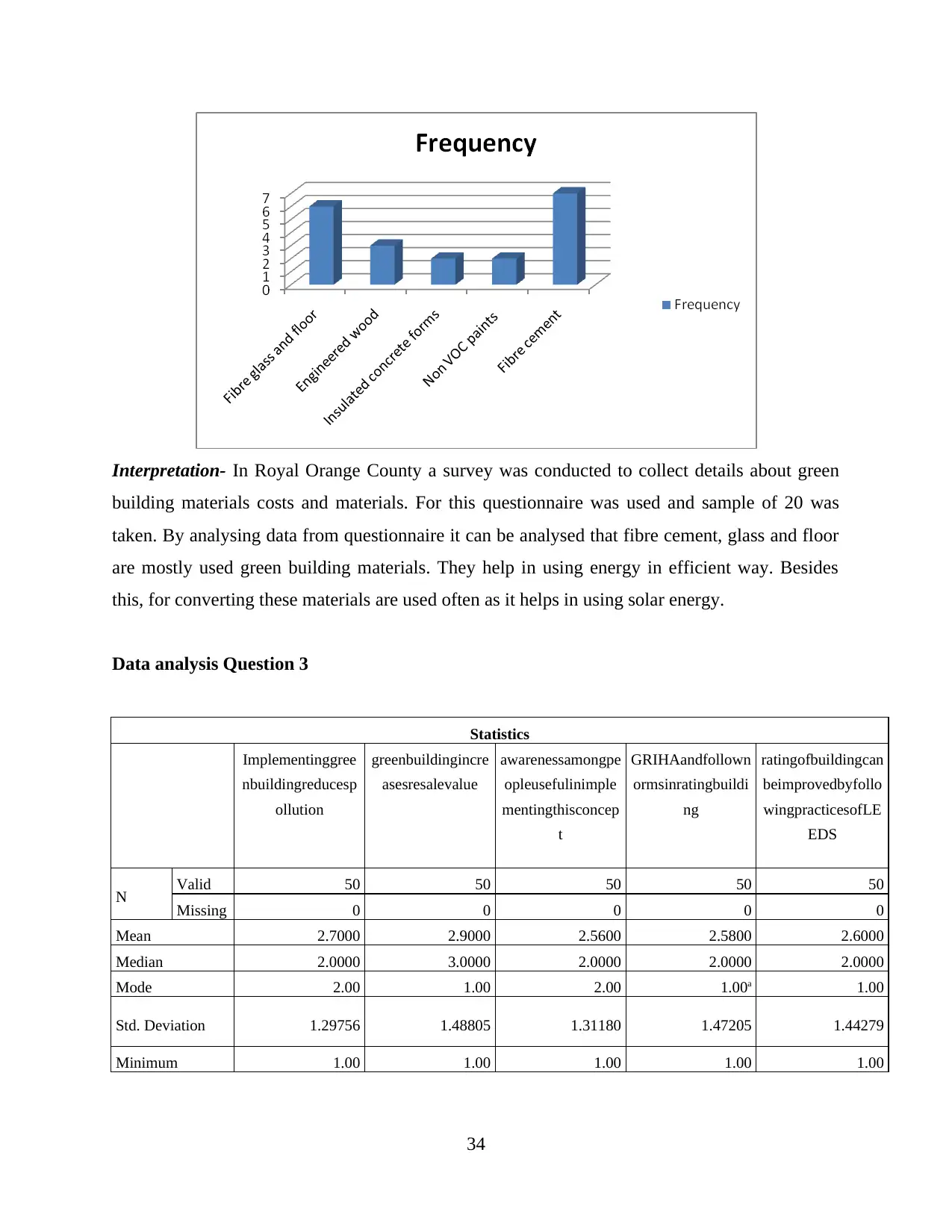
Interpretation- In Royal Orange County a survey was conducted to collect details about green
building materials costs and materials. For this questionnaire was used and sample of 20 was
taken. By analysing data from questionnaire it can be analysed that fibre cement, glass and floor
are mostly used green building materials. They help in using energy in efficient way. Besides
this, for converting these materials are used often as it helps in using solar energy.
Data analysis Question 3
Statistics
Implementinggree
nbuildingreducesp
ollution
greenbuildingincre
asesresalevalue
awarenessamongpe
opleusefulinimple
mentingthisconcep
t
GRIHAandfollown
ormsinratingbuildi
ng
ratingofbuildingcan
beimprovedbyfollo
wingpracticesofLE
EDS
N Valid 50 50 50 50 50
Missing 0 0 0 0 0
Mean 2.7000 2.9000 2.5600 2.5800 2.6000
Median 2.0000 3.0000 2.0000 2.0000 2.0000
Mode 2.00 1.00 2.00 1.00a 1.00
Std. Deviation 1.29756 1.48805 1.31180 1.47205 1.44279
Minimum 1.00 1.00 1.00 1.00 1.00
34
building materials costs and materials. For this questionnaire was used and sample of 20 was
taken. By analysing data from questionnaire it can be analysed that fibre cement, glass and floor
are mostly used green building materials. They help in using energy in efficient way. Besides
this, for converting these materials are used often as it helps in using solar energy.
Data analysis Question 3
Statistics
Implementinggree
nbuildingreducesp
ollution
greenbuildingincre
asesresalevalue
awarenessamongpe
opleusefulinimple
mentingthisconcep
t
GRIHAandfollown
ormsinratingbuildi
ng
ratingofbuildingcan
beimprovedbyfollo
wingpracticesofLE
EDS
N Valid 50 50 50 50 50
Missing 0 0 0 0 0
Mean 2.7000 2.9000 2.5600 2.5800 2.6000
Median 2.0000 3.0000 2.0000 2.0000 2.0000
Mode 2.00 1.00 2.00 1.00a 1.00
Std. Deviation 1.29756 1.48805 1.31180 1.47205 1.44279
Minimum 1.00 1.00 1.00 1.00 1.00
34
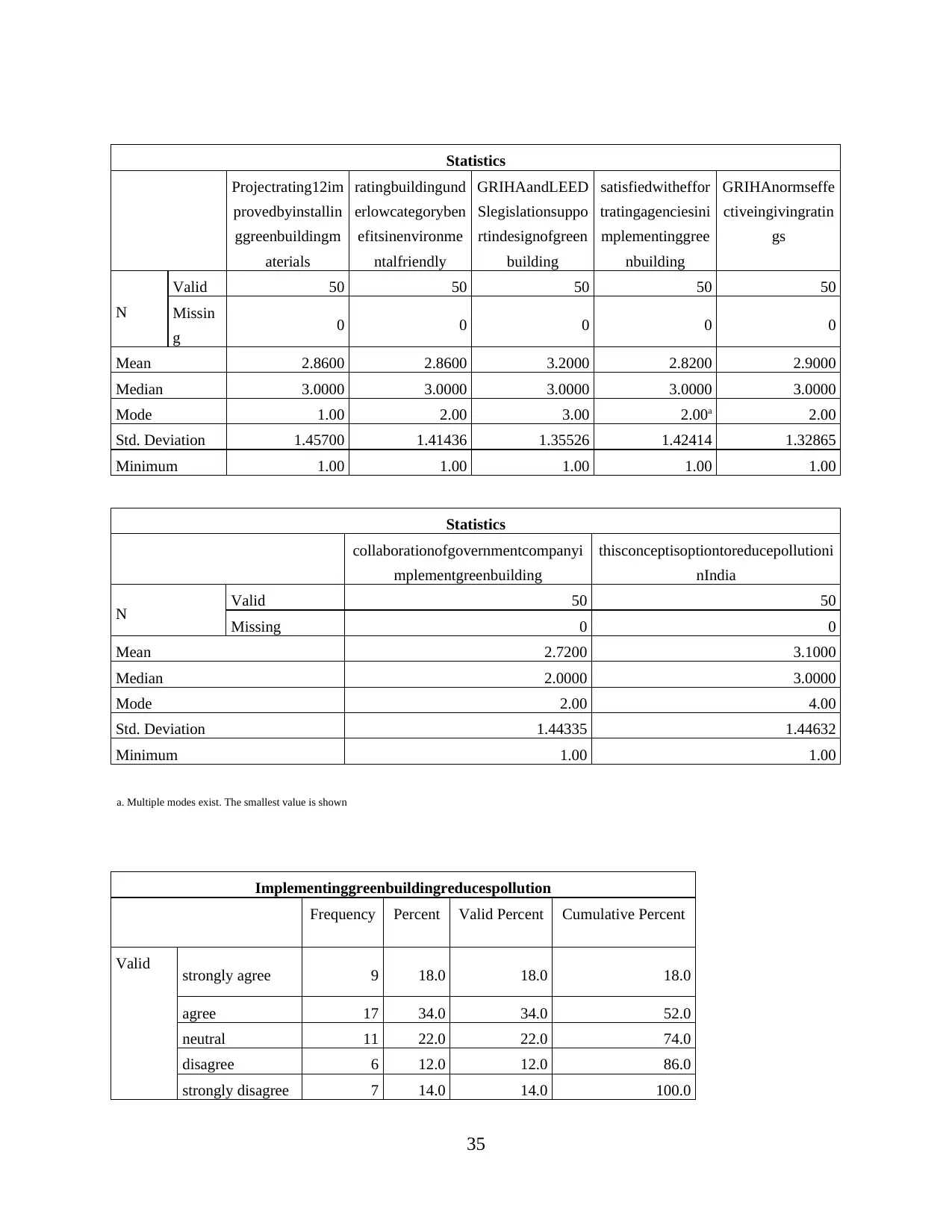
Statistics
Projectrating12im
provedbyinstallin
ggreenbuildingm
aterials
ratingbuildingund
erlowcategoryben
efitsinenvironme
ntalfriendly
GRIHAandLEED
Slegislationsuppo
rtindesignofgreen
building
satisfiedwitheffor
tratingagenciesini
mplementinggree
nbuilding
GRIHAnormseffe
ctiveingivingratin
gs
N
Valid 50 50 50 50 50
Missin
g 0 0 0 0 0
Mean 2.8600 2.8600 3.2000 2.8200 2.9000
Median 3.0000 3.0000 3.0000 3.0000 3.0000
Mode 1.00 2.00 3.00 2.00a 2.00
Std. Deviation 1.45700 1.41436 1.35526 1.42414 1.32865
Minimum 1.00 1.00 1.00 1.00 1.00
Statistics
collaborationofgovernmentcompanyi
mplementgreenbuilding
thisconceptisoptiontoreducepollutioni
nIndia
N Valid 50 50
Missing 0 0
Mean 2.7200 3.1000
Median 2.0000 3.0000
Mode 2.00 4.00
Std. Deviation 1.44335 1.44632
Minimum 1.00 1.00
a. Multiple modes exist. The smallest value is shown
Implementinggreenbuildingreducespollution
Frequency Percent Valid Percent Cumulative Percent
Valid strongly agree 9 18.0 18.0 18.0
agree 17 34.0 34.0 52.0
neutral 11 22.0 22.0 74.0
disagree 6 12.0 12.0 86.0
strongly disagree 7 14.0 14.0 100.0
35
Projectrating12im
provedbyinstallin
ggreenbuildingm
aterials
ratingbuildingund
erlowcategoryben
efitsinenvironme
ntalfriendly
GRIHAandLEED
Slegislationsuppo
rtindesignofgreen
building
satisfiedwitheffor
tratingagenciesini
mplementinggree
nbuilding
GRIHAnormseffe
ctiveingivingratin
gs
N
Valid 50 50 50 50 50
Missin
g 0 0 0 0 0
Mean 2.8600 2.8600 3.2000 2.8200 2.9000
Median 3.0000 3.0000 3.0000 3.0000 3.0000
Mode 1.00 2.00 3.00 2.00a 2.00
Std. Deviation 1.45700 1.41436 1.35526 1.42414 1.32865
Minimum 1.00 1.00 1.00 1.00 1.00
Statistics
collaborationofgovernmentcompanyi
mplementgreenbuilding
thisconceptisoptiontoreducepollutioni
nIndia
N Valid 50 50
Missing 0 0
Mean 2.7200 3.1000
Median 2.0000 3.0000
Mode 2.00 4.00
Std. Deviation 1.44335 1.44632
Minimum 1.00 1.00
a. Multiple modes exist. The smallest value is shown
Implementinggreenbuildingreducespollution
Frequency Percent Valid Percent Cumulative Percent
Valid strongly agree 9 18.0 18.0 18.0
agree 17 34.0 34.0 52.0
neutral 11 22.0 22.0 74.0
disagree 6 12.0 12.0 86.0
strongly disagree 7 14.0 14.0 100.0
35
Secure Best Marks with AI Grader
Need help grading? Try our AI Grader for instant feedback on your assignments.
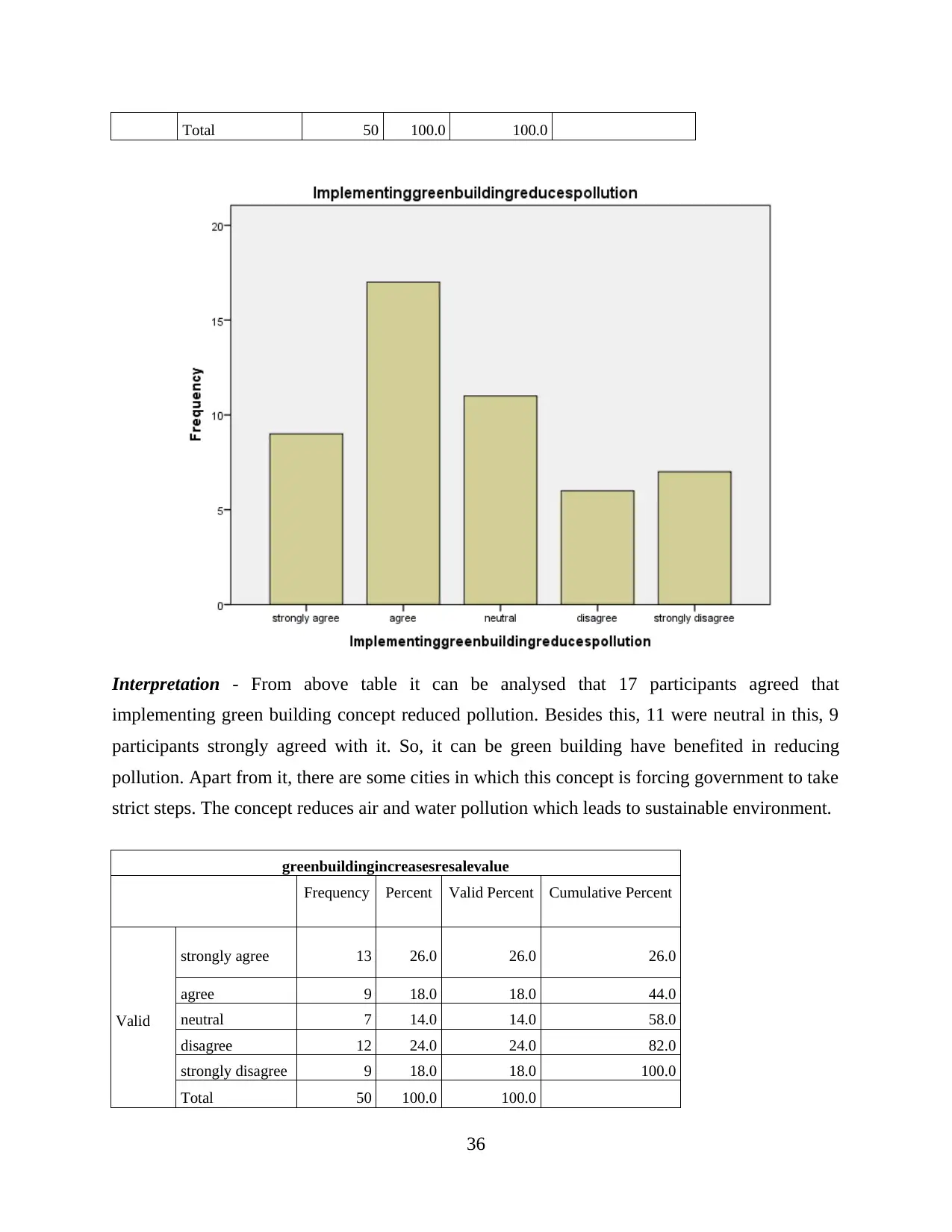
Total 50 100.0 100.0
Interpretation - From above table it can be analysed that 17 participants agreed that
implementing green building concept reduced pollution. Besides this, 11 were neutral in this, 9
participants strongly agreed with it. So, it can be green building have benefited in reducing
pollution. Apart from it, there are some cities in which this concept is forcing government to take
strict steps. The concept reduces air and water pollution which leads to sustainable environment.
greenbuildingincreasesresalevalue
Frequency Percent Valid Percent Cumulative Percent
Valid
strongly agree 13 26.0 26.0 26.0
agree 9 18.0 18.0 44.0
neutral 7 14.0 14.0 58.0
disagree 12 24.0 24.0 82.0
strongly disagree 9 18.0 18.0 100.0
Total 50 100.0 100.0
36
Interpretation - From above table it can be analysed that 17 participants agreed that
implementing green building concept reduced pollution. Besides this, 11 were neutral in this, 9
participants strongly agreed with it. So, it can be green building have benefited in reducing
pollution. Apart from it, there are some cities in which this concept is forcing government to take
strict steps. The concept reduces air and water pollution which leads to sustainable environment.
greenbuildingincreasesresalevalue
Frequency Percent Valid Percent Cumulative Percent
Valid
strongly agree 13 26.0 26.0 26.0
agree 9 18.0 18.0 44.0
neutral 7 14.0 14.0 58.0
disagree 12 24.0 24.0 82.0
strongly disagree 9 18.0 18.0 100.0
Total 50 100.0 100.0
36
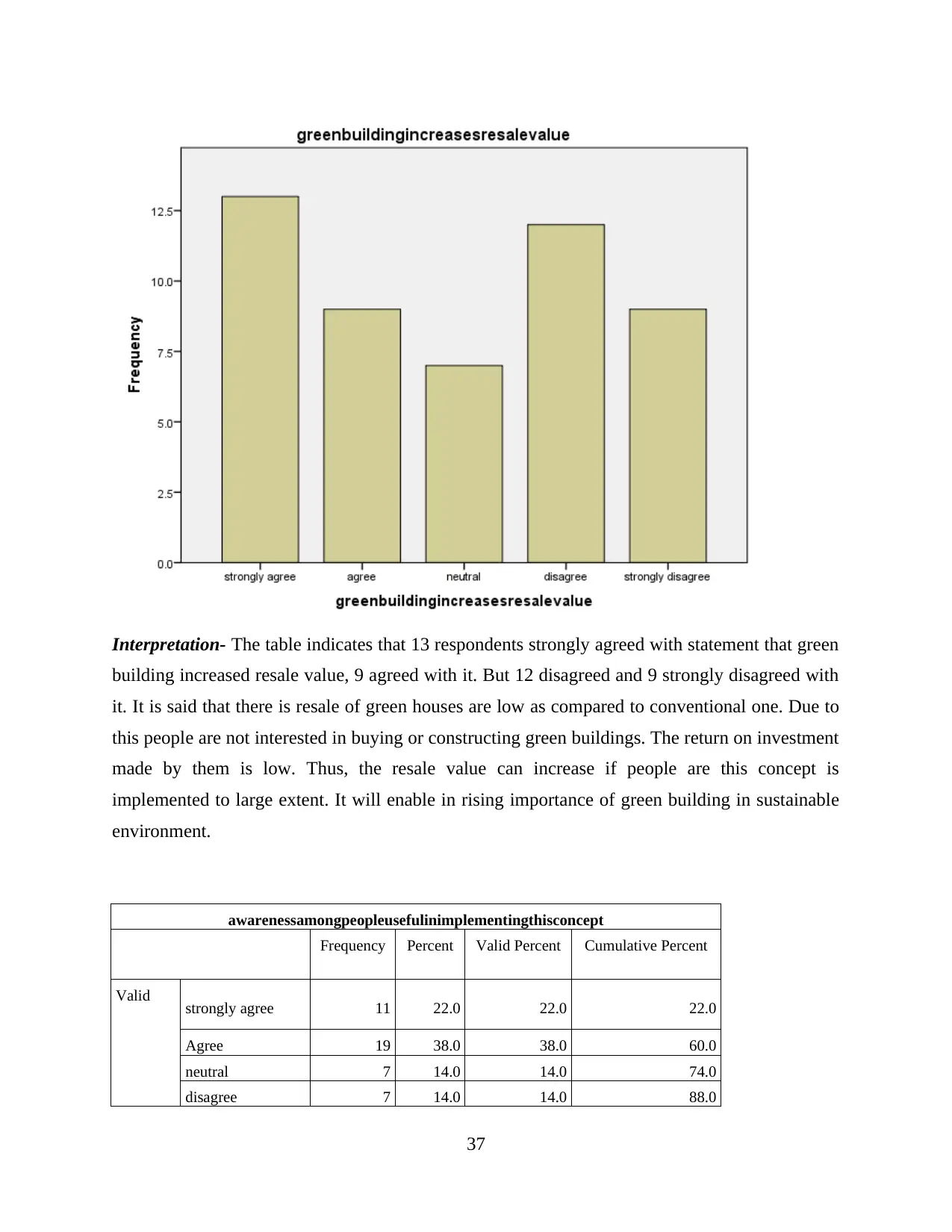
Interpretation- The table indicates that 13 respondents strongly agreed with statement that green
building increased resale value, 9 agreed with it. But 12 disagreed and 9 strongly disagreed with
it. It is said that there is resale of green houses are low as compared to conventional one. Due to
this people are not interested in buying or constructing green buildings. The return on investment
made by them is low. Thus, the resale value can increase if people are this concept is
implemented to large extent. It will enable in rising importance of green building in sustainable
environment.
awarenessamongpeopleusefulinimplementingthisconcept
Frequency Percent Valid Percent Cumulative Percent
Valid strongly agree 11 22.0 22.0 22.0
Agree 19 38.0 38.0 60.0
neutral 7 14.0 14.0 74.0
disagree 7 14.0 14.0 88.0
37
building increased resale value, 9 agreed with it. But 12 disagreed and 9 strongly disagreed with
it. It is said that there is resale of green houses are low as compared to conventional one. Due to
this people are not interested in buying or constructing green buildings. The return on investment
made by them is low. Thus, the resale value can increase if people are this concept is
implemented to large extent. It will enable in rising importance of green building in sustainable
environment.
awarenessamongpeopleusefulinimplementingthisconcept
Frequency Percent Valid Percent Cumulative Percent
Valid strongly agree 11 22.0 22.0 22.0
Agree 19 38.0 38.0 60.0
neutral 7 14.0 14.0 74.0
disagree 7 14.0 14.0 88.0
37
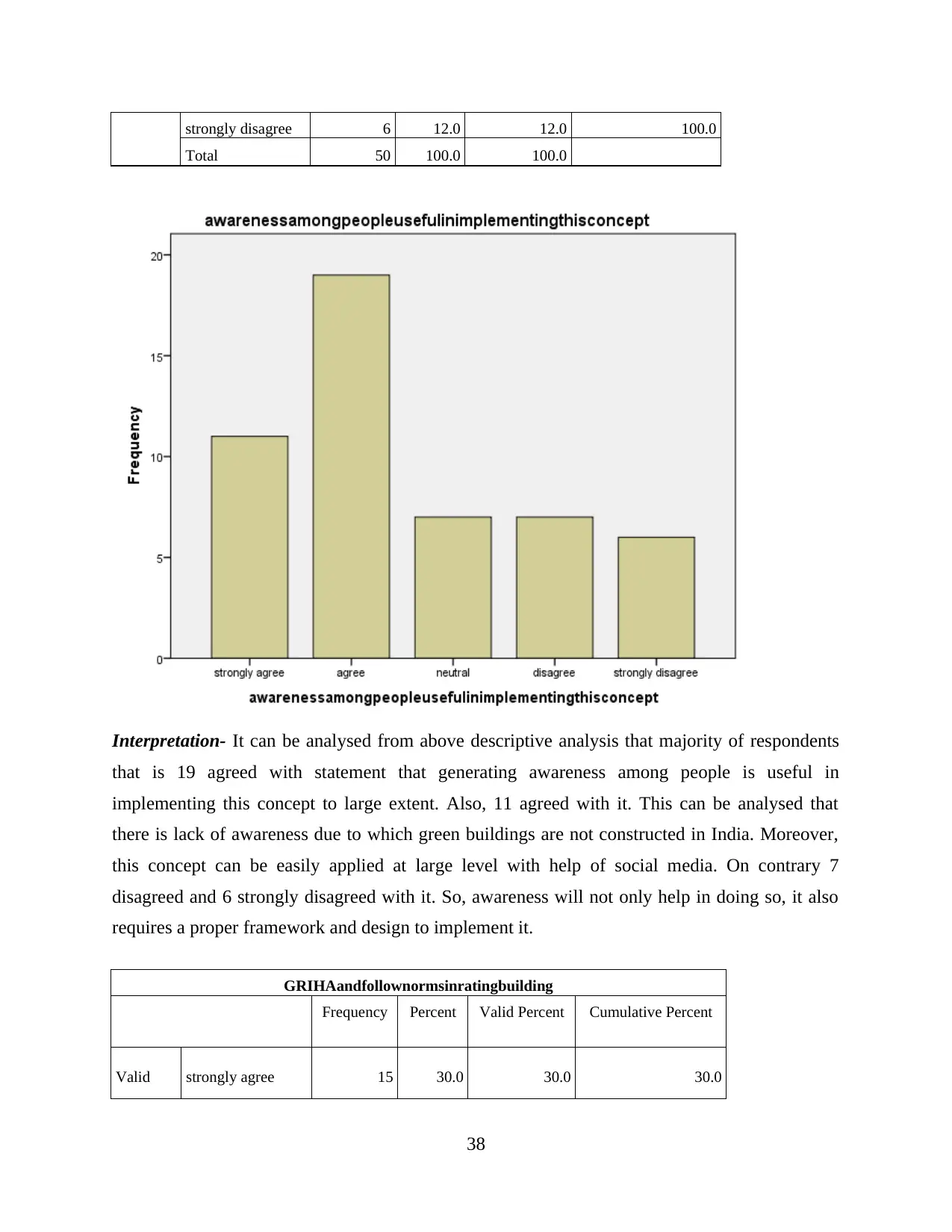
strongly disagree 6 12.0 12.0 100.0
Total 50 100.0 100.0
Interpretation- It can be analysed from above descriptive analysis that majority of respondents
that is 19 agreed with statement that generating awareness among people is useful in
implementing this concept to large extent. Also, 11 agreed with it. This can be analysed that
there is lack of awareness due to which green buildings are not constructed in India. Moreover,
this concept can be easily applied at large level with help of social media. On contrary 7
disagreed and 6 strongly disagreed with it. So, awareness will not only help in doing so, it also
requires a proper framework and design to implement it.
GRIHAandfollownormsinratingbuilding
Frequency Percent Valid Percent Cumulative Percent
Valid strongly agree 15 30.0 30.0 30.0
38
Total 50 100.0 100.0
Interpretation- It can be analysed from above descriptive analysis that majority of respondents
that is 19 agreed with statement that generating awareness among people is useful in
implementing this concept to large extent. Also, 11 agreed with it. This can be analysed that
there is lack of awareness due to which green buildings are not constructed in India. Moreover,
this concept can be easily applied at large level with help of social media. On contrary 7
disagreed and 6 strongly disagreed with it. So, awareness will not only help in doing so, it also
requires a proper framework and design to implement it.
GRIHAandfollownormsinratingbuilding
Frequency Percent Valid Percent Cumulative Percent
Valid strongly agree 15 30.0 30.0 30.0
38
Paraphrase This Document
Need a fresh take? Get an instant paraphrase of this document with our AI Paraphraser
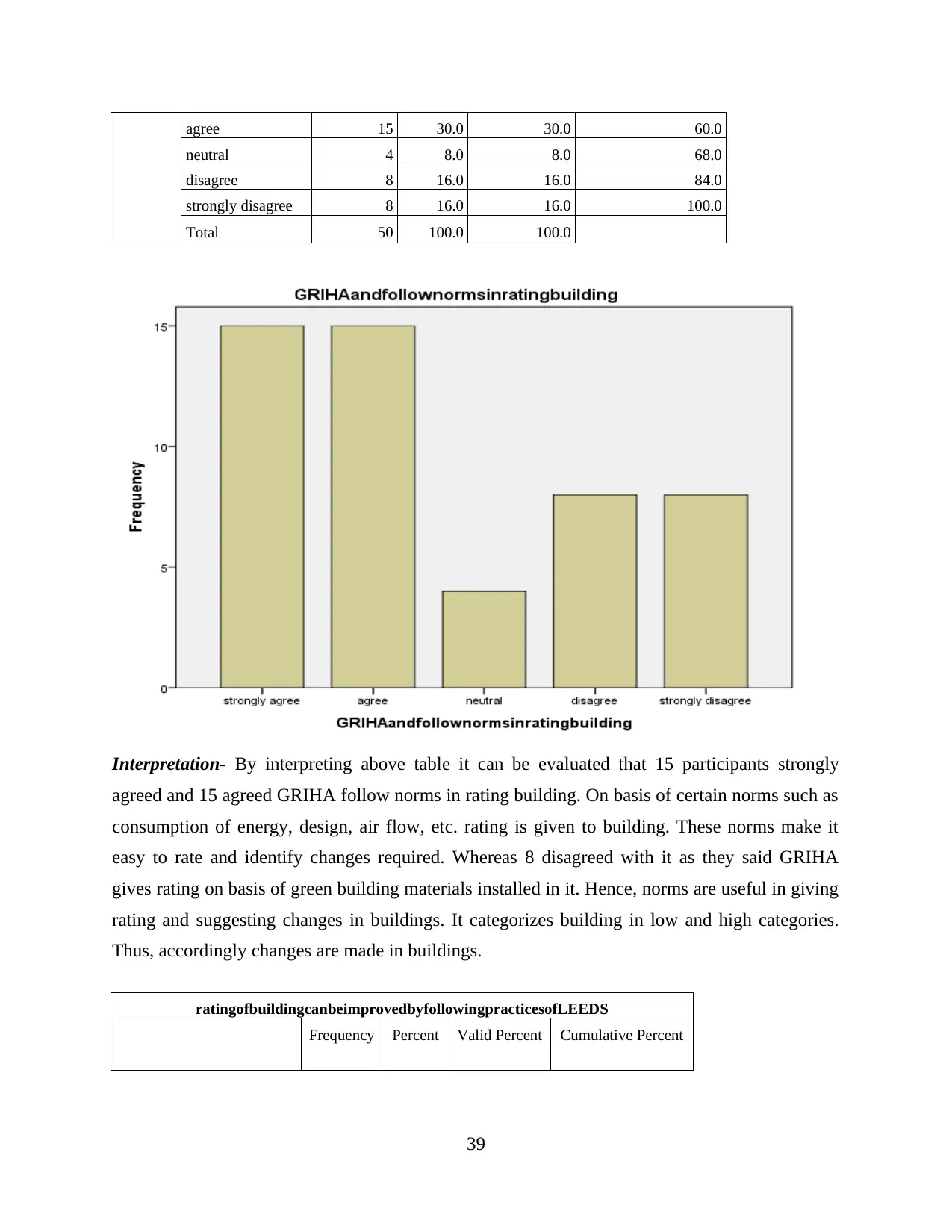
agree 15 30.0 30.0 60.0
neutral 4 8.0 8.0 68.0
disagree 8 16.0 16.0 84.0
strongly disagree 8 16.0 16.0 100.0
Total 50 100.0 100.0
Interpretation- By interpreting above table it can be evaluated that 15 participants strongly
agreed and 15 agreed GRIHA follow norms in rating building. On basis of certain norms such as
consumption of energy, design, air flow, etc. rating is given to building. These norms make it
easy to rate and identify changes required. Whereas 8 disagreed with it as they said GRIHA
gives rating on basis of green building materials installed in it. Hence, norms are useful in giving
rating and suggesting changes in buildings. It categorizes building in low and high categories.
Thus, accordingly changes are made in buildings.
ratingofbuildingcanbeimprovedbyfollowingpracticesofLEEDS
Frequency Percent Valid Percent Cumulative Percent
39
neutral 4 8.0 8.0 68.0
disagree 8 16.0 16.0 84.0
strongly disagree 8 16.0 16.0 100.0
Total 50 100.0 100.0
Interpretation- By interpreting above table it can be evaluated that 15 participants strongly
agreed and 15 agreed GRIHA follow norms in rating building. On basis of certain norms such as
consumption of energy, design, air flow, etc. rating is given to building. These norms make it
easy to rate and identify changes required. Whereas 8 disagreed with it as they said GRIHA
gives rating on basis of green building materials installed in it. Hence, norms are useful in giving
rating and suggesting changes in buildings. It categorizes building in low and high categories.
Thus, accordingly changes are made in buildings.
ratingofbuildingcanbeimprovedbyfollowingpracticesofLEEDS
Frequency Percent Valid Percent Cumulative Percent
39
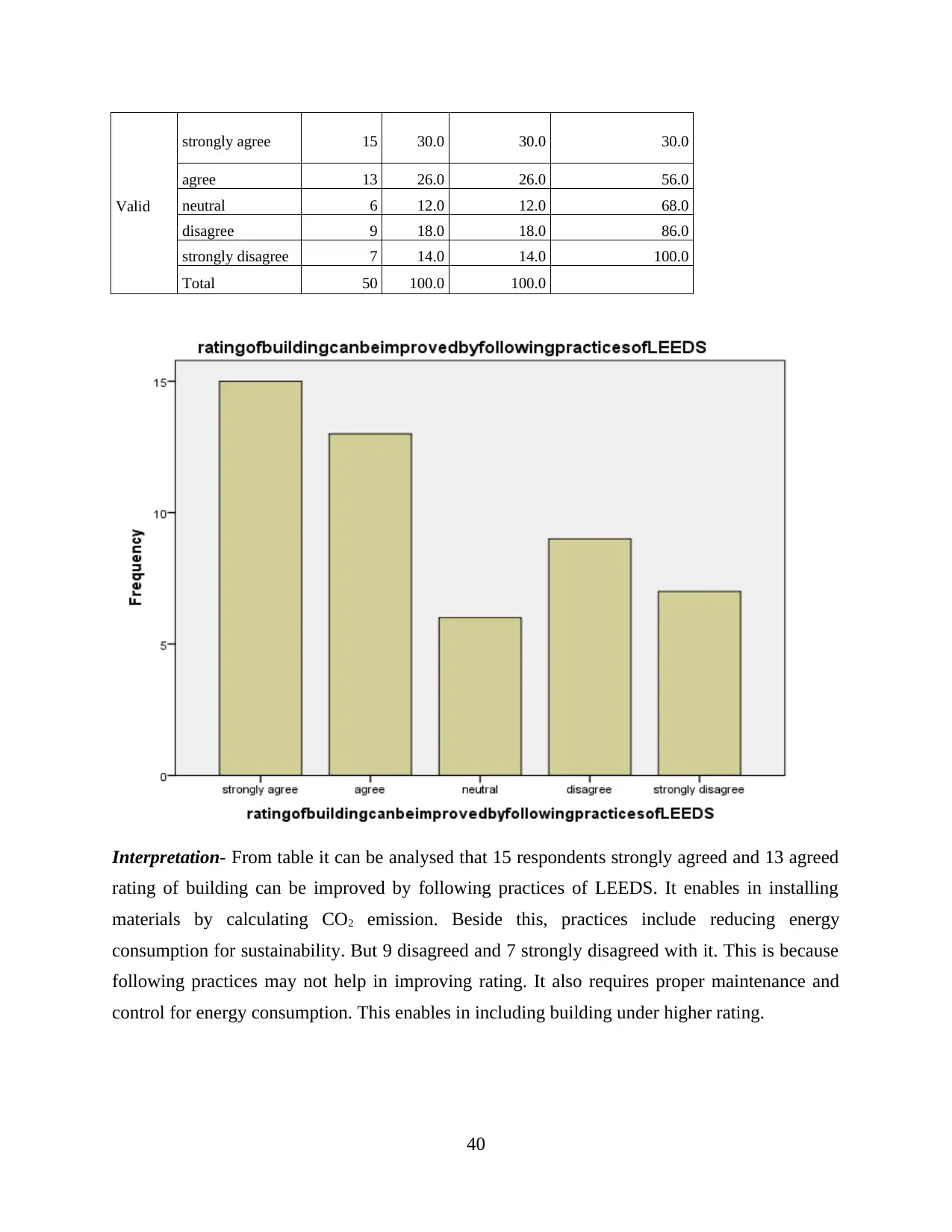
Valid
strongly agree 15 30.0 30.0 30.0
agree 13 26.0 26.0 56.0
neutral 6 12.0 12.0 68.0
disagree 9 18.0 18.0 86.0
strongly disagree 7 14.0 14.0 100.0
Total 50 100.0 100.0
Interpretation- From table it can be analysed that 15 respondents strongly agreed and 13 agreed
rating of building can be improved by following practices of LEEDS. It enables in installing
materials by calculating CO2 emission. Beside this, practices include reducing energy
consumption for sustainability. But 9 disagreed and 7 strongly disagreed with it. This is because
following practices may not help in improving rating. It also requires proper maintenance and
control for energy consumption. This enables in including building under higher rating.
40
strongly agree 15 30.0 30.0 30.0
agree 13 26.0 26.0 56.0
neutral 6 12.0 12.0 68.0
disagree 9 18.0 18.0 86.0
strongly disagree 7 14.0 14.0 100.0
Total 50 100.0 100.0
Interpretation- From table it can be analysed that 15 respondents strongly agreed and 13 agreed
rating of building can be improved by following practices of LEEDS. It enables in installing
materials by calculating CO2 emission. Beside this, practices include reducing energy
consumption for sustainability. But 9 disagreed and 7 strongly disagreed with it. This is because
following practices may not help in improving rating. It also requires proper maintenance and
control for energy consumption. This enables in including building under higher rating.
40
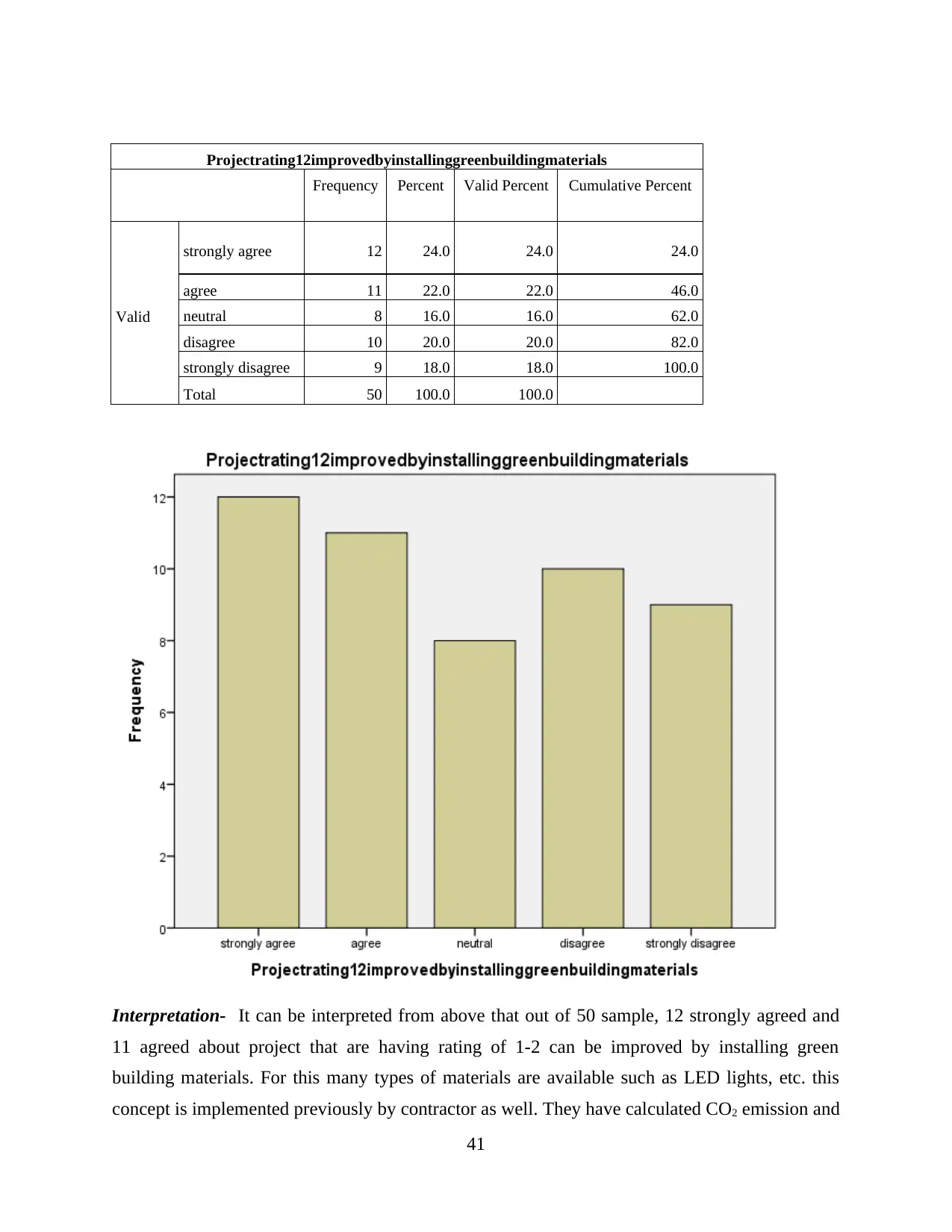
Projectrating12improvedbyinstallinggreenbuildingmaterials
Frequency Percent Valid Percent Cumulative Percent
Valid
strongly agree 12 24.0 24.0 24.0
agree 11 22.0 22.0 46.0
neutral 8 16.0 16.0 62.0
disagree 10 20.0 20.0 82.0
strongly disagree 9 18.0 18.0 100.0
Total 50 100.0 100.0
Interpretation- It can be interpreted from above that out of 50 sample, 12 strongly agreed and
11 agreed about project that are having rating of 1-2 can be improved by installing green
building materials. For this many types of materials are available such as LED lights, etc. this
concept is implemented previously by contractor as well. They have calculated CO2 emission and
41
Frequency Percent Valid Percent Cumulative Percent
Valid
strongly agree 12 24.0 24.0 24.0
agree 11 22.0 22.0 46.0
neutral 8 16.0 16.0 62.0
disagree 10 20.0 20.0 82.0
strongly disagree 9 18.0 18.0 100.0
Total 50 100.0 100.0
Interpretation- It can be interpreted from above that out of 50 sample, 12 strongly agreed and
11 agreed about project that are having rating of 1-2 can be improved by installing green
building materials. For this many types of materials are available such as LED lights, etc. this
concept is implemented previously by contractor as well. They have calculated CO2 emission and
41
Secure Best Marks with AI Grader
Need help grading? Try our AI Grader for instant feedback on your assignments.
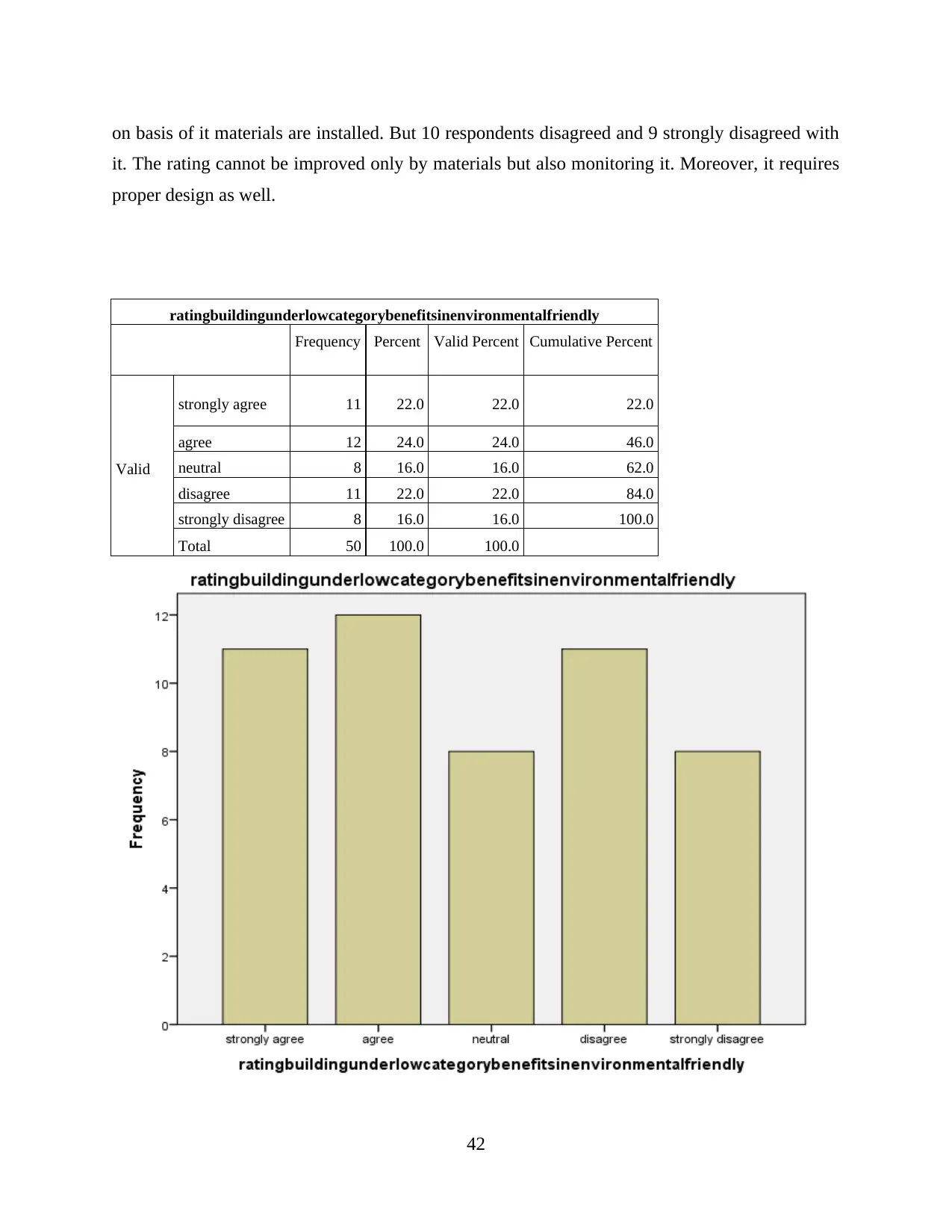
on basis of it materials are installed. But 10 respondents disagreed and 9 strongly disagreed with
it. The rating cannot be improved only by materials but also monitoring it. Moreover, it requires
proper design as well.
ratingbuildingunderlowcategorybenefitsinenvironmentalfriendly
Frequency Percent Valid Percent Cumulative Percent
Valid
strongly agree 11 22.0 22.0 22.0
agree 12 24.0 24.0 46.0
neutral 8 16.0 16.0 62.0
disagree 11 22.0 22.0 84.0
strongly disagree 8 16.0 16.0 100.0
Total 50 100.0 100.0
42
it. The rating cannot be improved only by materials but also monitoring it. Moreover, it requires
proper design as well.
ratingbuildingunderlowcategorybenefitsinenvironmentalfriendly
Frequency Percent Valid Percent Cumulative Percent
Valid
strongly agree 11 22.0 22.0 22.0
agree 12 24.0 24.0 46.0
neutral 8 16.0 16.0 62.0
disagree 11 22.0 22.0 84.0
strongly disagree 8 16.0 16.0 100.0
Total 50 100.0 100.0
42
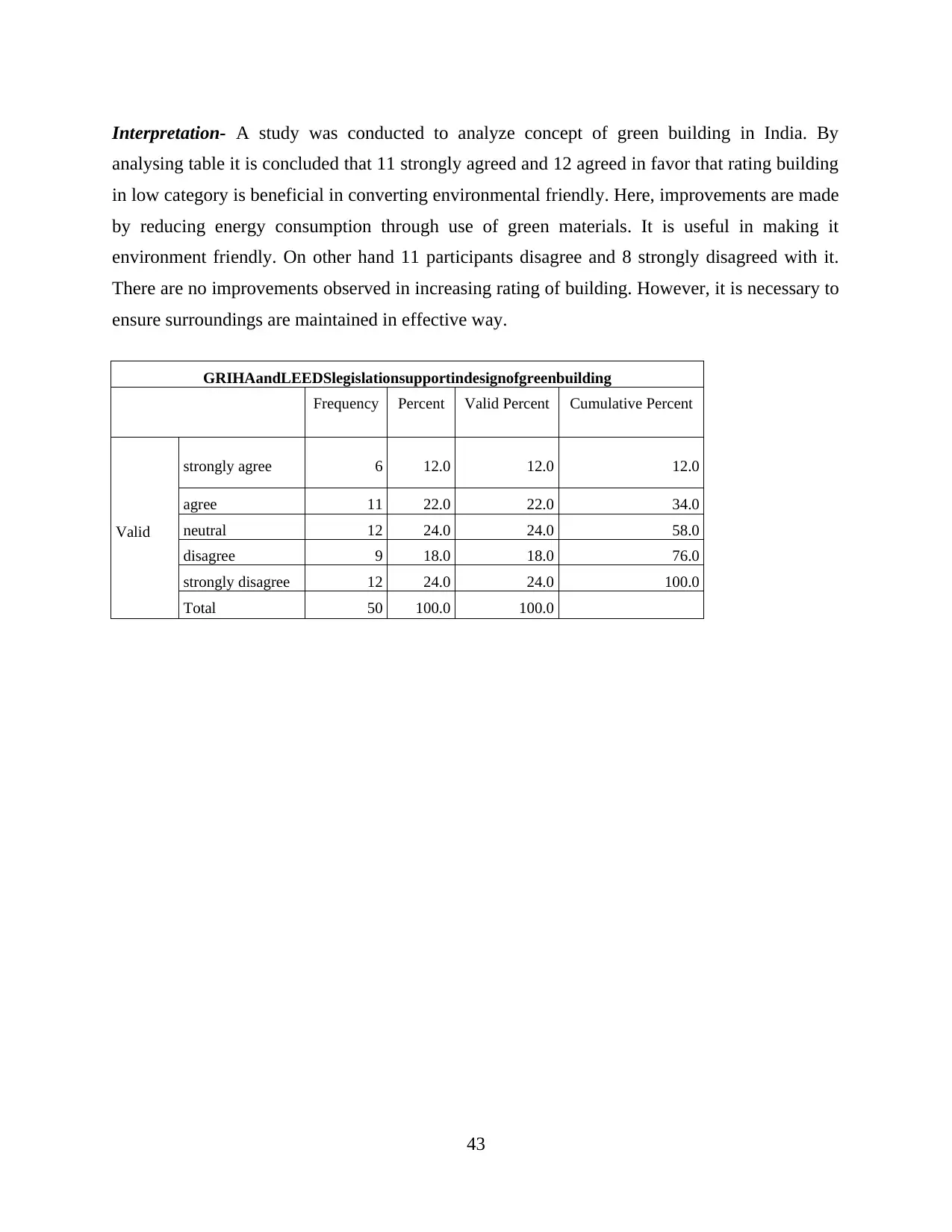
Interpretation- A study was conducted to analyze concept of green building in India. By
analysing table it is concluded that 11 strongly agreed and 12 agreed in favor that rating building
in low category is beneficial in converting environmental friendly. Here, improvements are made
by reducing energy consumption through use of green materials. It is useful in making it
environment friendly. On other hand 11 participants disagree and 8 strongly disagreed with it.
There are no improvements observed in increasing rating of building. However, it is necessary to
ensure surroundings are maintained in effective way.
GRIHAandLEEDSlegislationsupportindesignofgreenbuilding
Frequency Percent Valid Percent Cumulative Percent
Valid
strongly agree 6 12.0 12.0 12.0
agree 11 22.0 22.0 34.0
neutral 12 24.0 24.0 58.0
disagree 9 18.0 18.0 76.0
strongly disagree 12 24.0 24.0 100.0
Total 50 100.0 100.0
43
analysing table it is concluded that 11 strongly agreed and 12 agreed in favor that rating building
in low category is beneficial in converting environmental friendly. Here, improvements are made
by reducing energy consumption through use of green materials. It is useful in making it
environment friendly. On other hand 11 participants disagree and 8 strongly disagreed with it.
There are no improvements observed in increasing rating of building. However, it is necessary to
ensure surroundings are maintained in effective way.
GRIHAandLEEDSlegislationsupportindesignofgreenbuilding
Frequency Percent Valid Percent Cumulative Percent
Valid
strongly agree 6 12.0 12.0 12.0
agree 11 22.0 22.0 34.0
neutral 12 24.0 24.0 58.0
disagree 9 18.0 18.0 76.0
strongly disagree 12 24.0 24.0 100.0
Total 50 100.0 100.0
43
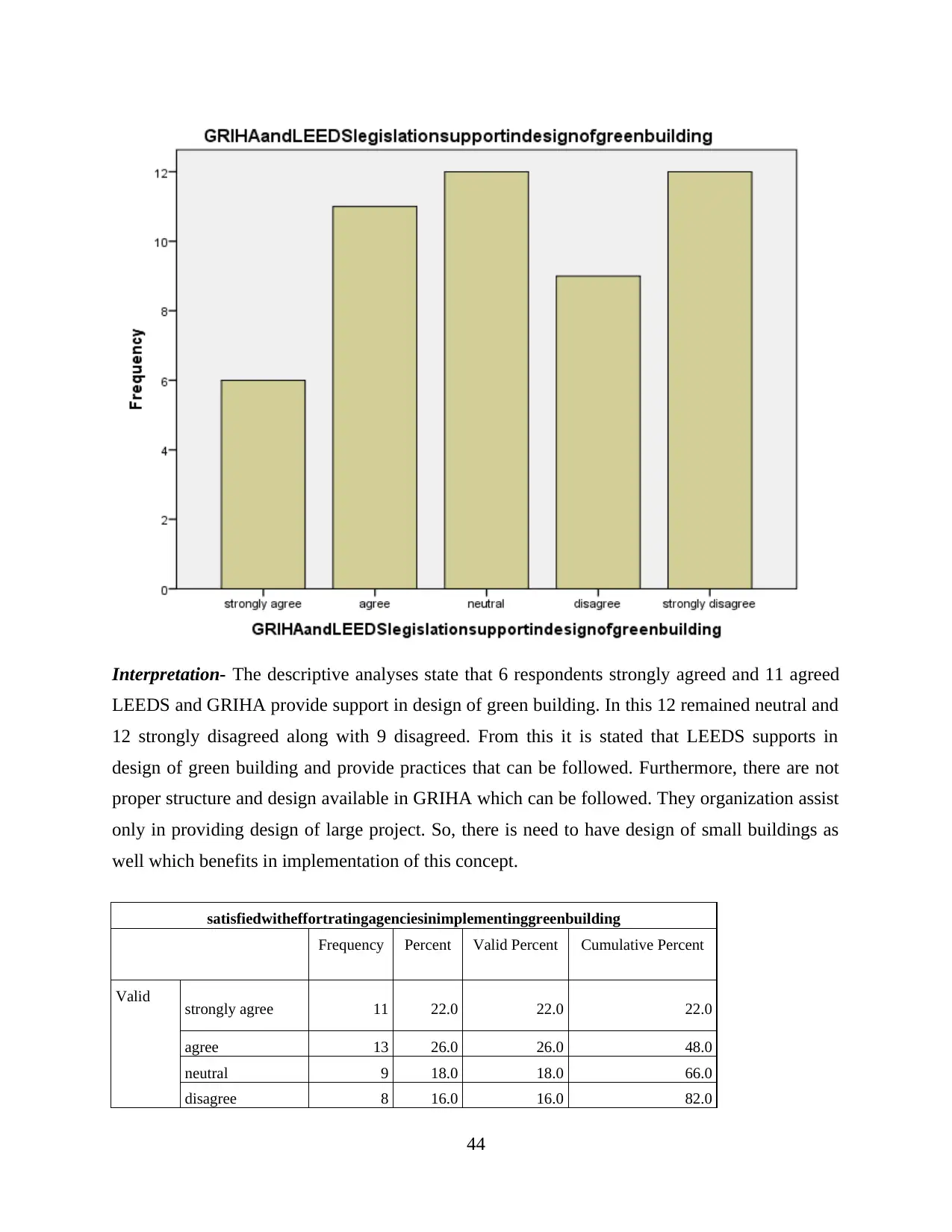
Interpretation- The descriptive analyses state that 6 respondents strongly agreed and 11 agreed
LEEDS and GRIHA provide support in design of green building. In this 12 remained neutral and
12 strongly disagreed along with 9 disagreed. From this it is stated that LEEDS supports in
design of green building and provide practices that can be followed. Furthermore, there are not
proper structure and design available in GRIHA which can be followed. They organization assist
only in providing design of large project. So, there is need to have design of small buildings as
well which benefits in implementation of this concept.
satisfiedwitheffortratingagenciesinimplementinggreenbuilding
Frequency Percent Valid Percent Cumulative Percent
Valid strongly agree 11 22.0 22.0 22.0
agree 13 26.0 26.0 48.0
neutral 9 18.0 18.0 66.0
disagree 8 16.0 16.0 82.0
44
LEEDS and GRIHA provide support in design of green building. In this 12 remained neutral and
12 strongly disagreed along with 9 disagreed. From this it is stated that LEEDS supports in
design of green building and provide practices that can be followed. Furthermore, there are not
proper structure and design available in GRIHA which can be followed. They organization assist
only in providing design of large project. So, there is need to have design of small buildings as
well which benefits in implementation of this concept.
satisfiedwitheffortratingagenciesinimplementinggreenbuilding
Frequency Percent Valid Percent Cumulative Percent
Valid strongly agree 11 22.0 22.0 22.0
agree 13 26.0 26.0 48.0
neutral 9 18.0 18.0 66.0
disagree 8 16.0 16.0 82.0
44
Paraphrase This Document
Need a fresh take? Get an instant paraphrase of this document with our AI Paraphraser
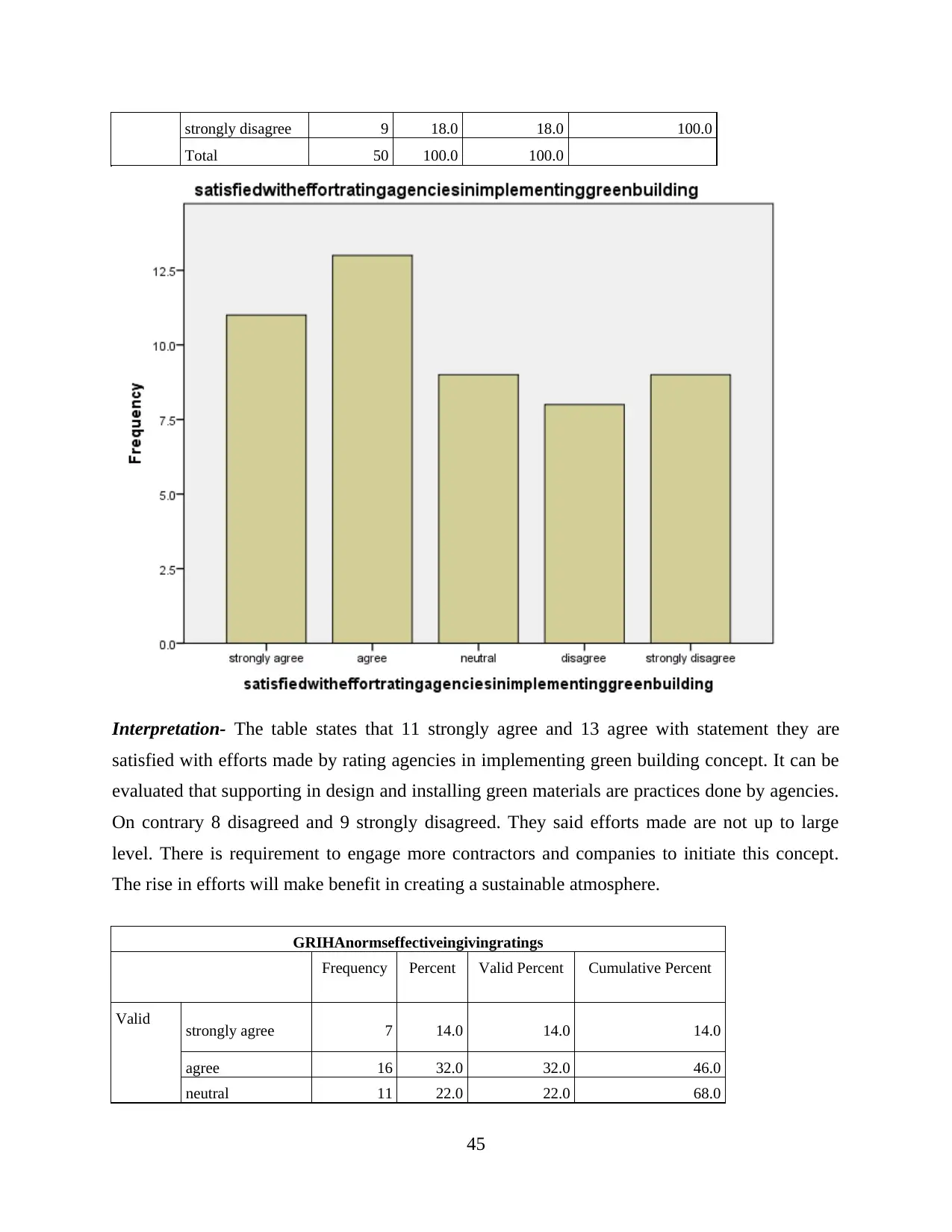
strongly disagree 9 18.0 18.0 100.0
Total 50 100.0 100.0
Interpretation- The table states that 11 strongly agree and 13 agree with statement they are
satisfied with efforts made by rating agencies in implementing green building concept. It can be
evaluated that supporting in design and installing green materials are practices done by agencies.
On contrary 8 disagreed and 9 strongly disagreed. They said efforts made are not up to large
level. There is requirement to engage more contractors and companies to initiate this concept.
The rise in efforts will make benefit in creating a sustainable atmosphere.
GRIHAnormseffectiveingivingratings
Frequency Percent Valid Percent Cumulative Percent
Valid strongly agree 7 14.0 14.0 14.0
agree 16 32.0 32.0 46.0
neutral 11 22.0 22.0 68.0
45
Total 50 100.0 100.0
Interpretation- The table states that 11 strongly agree and 13 agree with statement they are
satisfied with efforts made by rating agencies in implementing green building concept. It can be
evaluated that supporting in design and installing green materials are practices done by agencies.
On contrary 8 disagreed and 9 strongly disagreed. They said efforts made are not up to large
level. There is requirement to engage more contractors and companies to initiate this concept.
The rise in efforts will make benefit in creating a sustainable atmosphere.
GRIHAnormseffectiveingivingratings
Frequency Percent Valid Percent Cumulative Percent
Valid strongly agree 7 14.0 14.0 14.0
agree 16 32.0 32.0 46.0
neutral 11 22.0 22.0 68.0
45
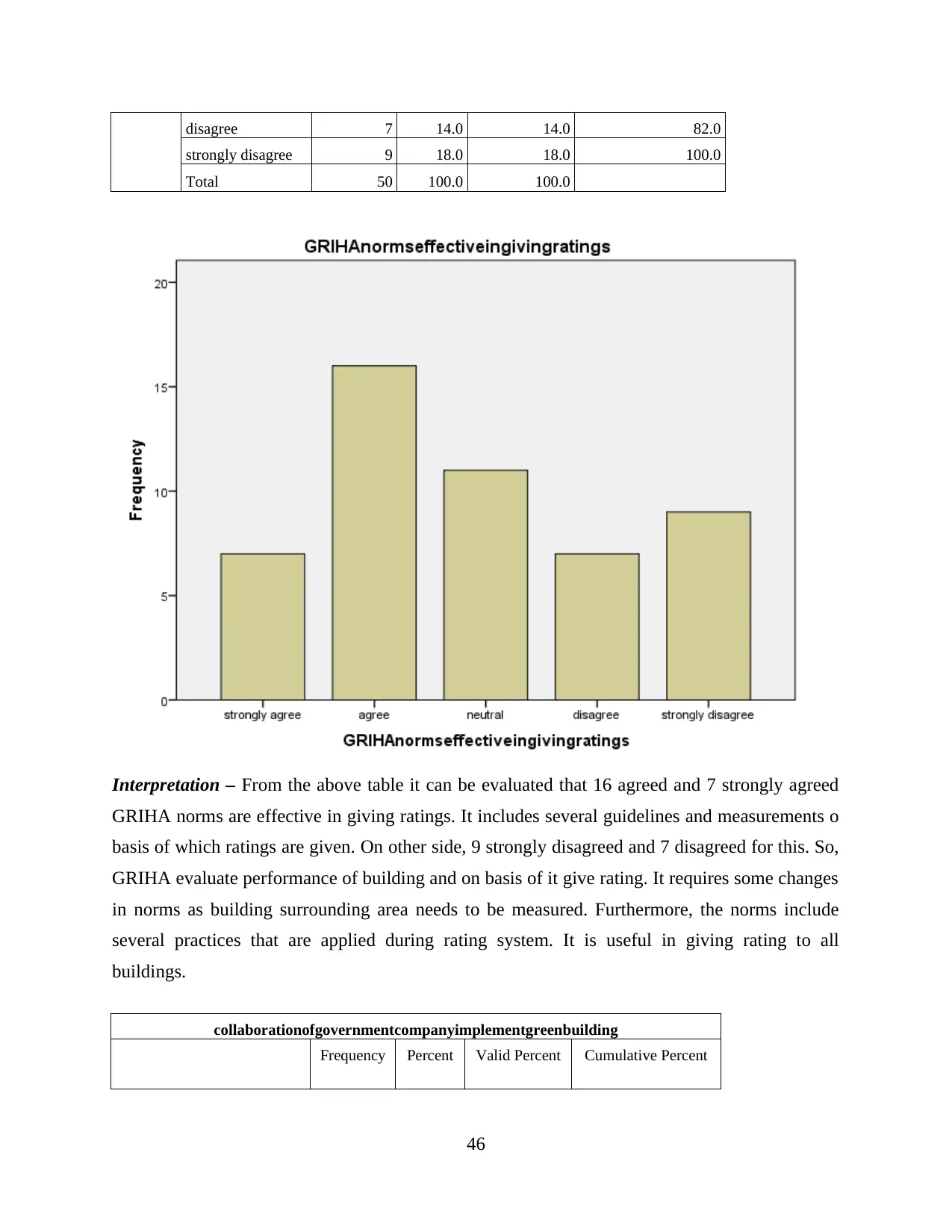
disagree 7 14.0 14.0 82.0
strongly disagree 9 18.0 18.0 100.0
Total 50 100.0 100.0
Interpretation – From the above table it can be evaluated that 16 agreed and 7 strongly agreed
GRIHA norms are effective in giving ratings. It includes several guidelines and measurements o
basis of which ratings are given. On other side, 9 strongly disagreed and 7 disagreed for this. So,
GRIHA evaluate performance of building and on basis of it give rating. It requires some changes
in norms as building surrounding area needs to be measured. Furthermore, the norms include
several practices that are applied during rating system. It is useful in giving rating to all
buildings.
collaborationofgovernmentcompanyimplementgreenbuilding
Frequency Percent Valid Percent Cumulative Percent
46
strongly disagree 9 18.0 18.0 100.0
Total 50 100.0 100.0
Interpretation – From the above table it can be evaluated that 16 agreed and 7 strongly agreed
GRIHA norms are effective in giving ratings. It includes several guidelines and measurements o
basis of which ratings are given. On other side, 9 strongly disagreed and 7 disagreed for this. So,
GRIHA evaluate performance of building and on basis of it give rating. It requires some changes
in norms as building surrounding area needs to be measured. Furthermore, the norms include
several practices that are applied during rating system. It is useful in giving rating to all
buildings.
collaborationofgovernmentcompanyimplementgreenbuilding
Frequency Percent Valid Percent Cumulative Percent
46
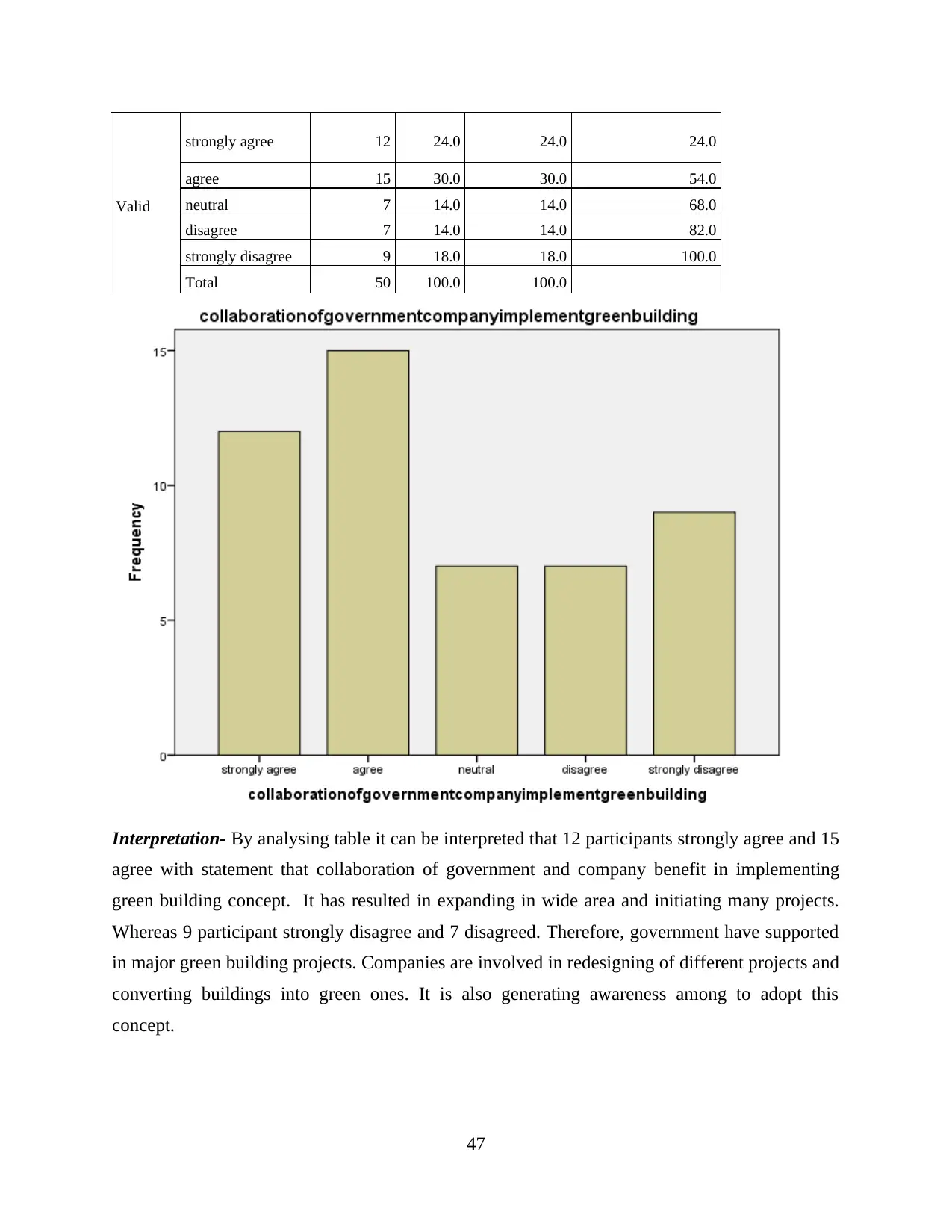
Valid
strongly agree 12 24.0 24.0 24.0
agree 15 30.0 30.0 54.0
neutral 7 14.0 14.0 68.0
disagree 7 14.0 14.0 82.0
strongly disagree 9 18.0 18.0 100.0
Total 50 100.0 100.0
Interpretation- By analysing table it can be interpreted that 12 participants strongly agree and 15
agree with statement that collaboration of government and company benefit in implementing
green building concept. It has resulted in expanding in wide area and initiating many projects.
Whereas 9 participant strongly disagree and 7 disagreed. Therefore, government have supported
in major green building projects. Companies are involved in redesigning of different projects and
converting buildings into green ones. It is also generating awareness among to adopt this
concept.
47
strongly agree 12 24.0 24.0 24.0
agree 15 30.0 30.0 54.0
neutral 7 14.0 14.0 68.0
disagree 7 14.0 14.0 82.0
strongly disagree 9 18.0 18.0 100.0
Total 50 100.0 100.0
Interpretation- By analysing table it can be interpreted that 12 participants strongly agree and 15
agree with statement that collaboration of government and company benefit in implementing
green building concept. It has resulted in expanding in wide area and initiating many projects.
Whereas 9 participant strongly disagree and 7 disagreed. Therefore, government have supported
in major green building projects. Companies are involved in redesigning of different projects and
converting buildings into green ones. It is also generating awareness among to adopt this
concept.
47
Secure Best Marks with AI Grader
Need help grading? Try our AI Grader for instant feedback on your assignments.
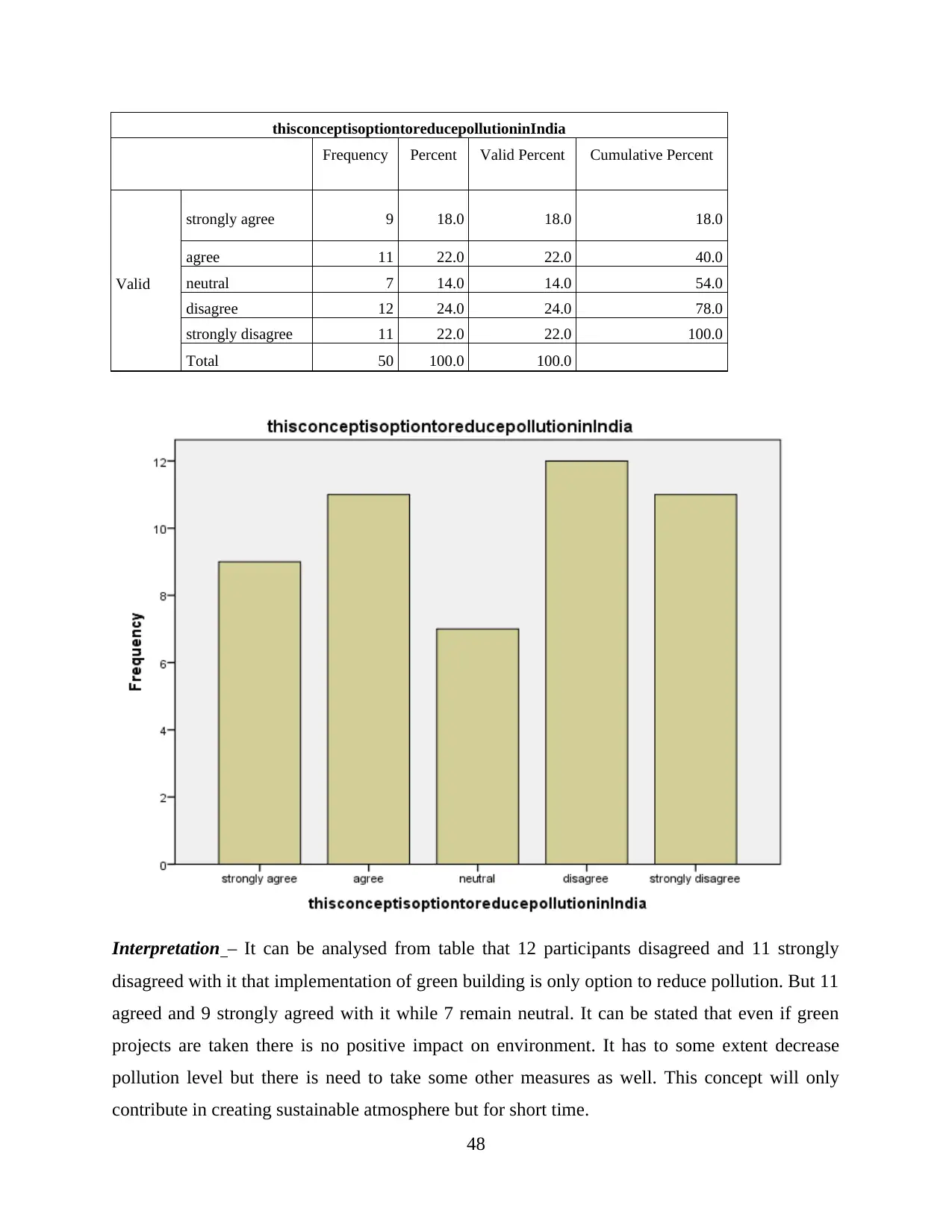
thisconceptisoptiontoreducepollutioninIndia
Frequency Percent Valid Percent Cumulative Percent
Valid
strongly agree 9 18.0 18.0 18.0
agree 11 22.0 22.0 40.0
neutral 7 14.0 14.0 54.0
disagree 12 24.0 24.0 78.0
strongly disagree 11 22.0 22.0 100.0
Total 50 100.0 100.0
Interpretation – It can be analysed from table that 12 participants disagreed and 11 strongly
disagreed with it that implementation of green building is only option to reduce pollution. But 11
agreed and 9 strongly agreed with it while 7 remain neutral. It can be stated that even if green
projects are taken there is no positive impact on environment. It has to some extent decrease
pollution level but there is need to take some other measures as well. This concept will only
contribute in creating sustainable atmosphere but for short time.
48
Frequency Percent Valid Percent Cumulative Percent
Valid
strongly agree 9 18.0 18.0 18.0
agree 11 22.0 22.0 40.0
neutral 7 14.0 14.0 54.0
disagree 12 24.0 24.0 78.0
strongly disagree 11 22.0 22.0 100.0
Total 50 100.0 100.0
Interpretation – It can be analysed from table that 12 participants disagreed and 11 strongly
disagreed with it that implementation of green building is only option to reduce pollution. But 11
agreed and 9 strongly agreed with it while 7 remain neutral. It can be stated that even if green
projects are taken there is no positive impact on environment. It has to some extent decrease
pollution level but there is need to take some other measures as well. This concept will only
contribute in creating sustainable atmosphere but for short time.
48
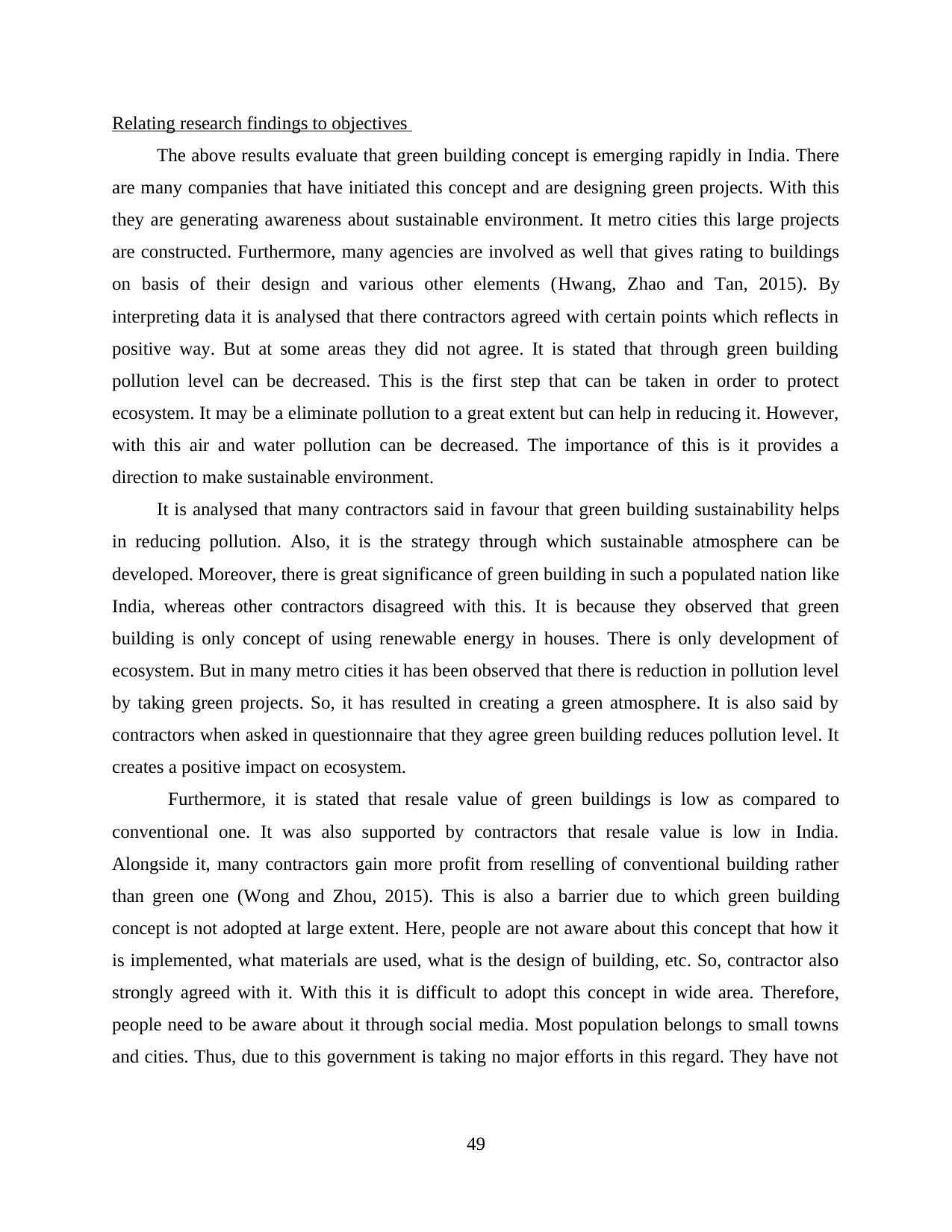
Relating research findings to objectives
The above results evaluate that green building concept is emerging rapidly in India. There
are many companies that have initiated this concept and are designing green projects. With this
they are generating awareness about sustainable environment. It metro cities this large projects
are constructed. Furthermore, many agencies are involved as well that gives rating to buildings
on basis of their design and various other elements (Hwang, Zhao and Tan, 2015). By
interpreting data it is analysed that there contractors agreed with certain points which reflects in
positive way. But at some areas they did not agree. It is stated that through green building
pollution level can be decreased. This is the first step that can be taken in order to protect
ecosystem. It may be a eliminate pollution to a great extent but can help in reducing it. However,
with this air and water pollution can be decreased. The importance of this is it provides a
direction to make sustainable environment.
It is analysed that many contractors said in favour that green building sustainability helps
in reducing pollution. Also, it is the strategy through which sustainable atmosphere can be
developed. Moreover, there is great significance of green building in such a populated nation like
India, whereas other contractors disagreed with this. It is because they observed that green
building is only concept of using renewable energy in houses. There is only development of
ecosystem. But in many metro cities it has been observed that there is reduction in pollution level
by taking green projects. So, it has resulted in creating a green atmosphere. It is also said by
contractors when asked in questionnaire that they agree green building reduces pollution level. It
creates a positive impact on ecosystem.
Furthermore, it is stated that resale value of green buildings is low as compared to
conventional one. It was also supported by contractors that resale value is low in India.
Alongside it, many contractors gain more profit from reselling of conventional building rather
than green one (Wong and Zhou, 2015). This is also a barrier due to which green building
concept is not adopted at large extent. Here, people are not aware about this concept that how it
is implemented, what materials are used, what is the design of building, etc. So, contractor also
strongly agreed with it. With this it is difficult to adopt this concept in wide area. Therefore,
people need to be aware about it through social media. Most population belongs to small towns
and cities. Thus, due to this government is taking no major efforts in this regard. They have not
49
The above results evaluate that green building concept is emerging rapidly in India. There
are many companies that have initiated this concept and are designing green projects. With this
they are generating awareness about sustainable environment. It metro cities this large projects
are constructed. Furthermore, many agencies are involved as well that gives rating to buildings
on basis of their design and various other elements (Hwang, Zhao and Tan, 2015). By
interpreting data it is analysed that there contractors agreed with certain points which reflects in
positive way. But at some areas they did not agree. It is stated that through green building
pollution level can be decreased. This is the first step that can be taken in order to protect
ecosystem. It may be a eliminate pollution to a great extent but can help in reducing it. However,
with this air and water pollution can be decreased. The importance of this is it provides a
direction to make sustainable environment.
It is analysed that many contractors said in favour that green building sustainability helps
in reducing pollution. Also, it is the strategy through which sustainable atmosphere can be
developed. Moreover, there is great significance of green building in such a populated nation like
India, whereas other contractors disagreed with this. It is because they observed that green
building is only concept of using renewable energy in houses. There is only development of
ecosystem. But in many metro cities it has been observed that there is reduction in pollution level
by taking green projects. So, it has resulted in creating a green atmosphere. It is also said by
contractors when asked in questionnaire that they agree green building reduces pollution level. It
creates a positive impact on ecosystem.
Furthermore, it is stated that resale value of green buildings is low as compared to
conventional one. It was also supported by contractors that resale value is low in India.
Alongside it, many contractors gain more profit from reselling of conventional building rather
than green one (Wong and Zhou, 2015). This is also a barrier due to which green building
concept is not adopted at large extent. Here, people are not aware about this concept that how it
is implemented, what materials are used, what is the design of building, etc. So, contractor also
strongly agreed with it. With this it is difficult to adopt this concept in wide area. Therefore,
people need to be aware about it through social media. Most population belongs to small towns
and cities. Thus, due to this government is taking no major efforts in this regard. They have not
49
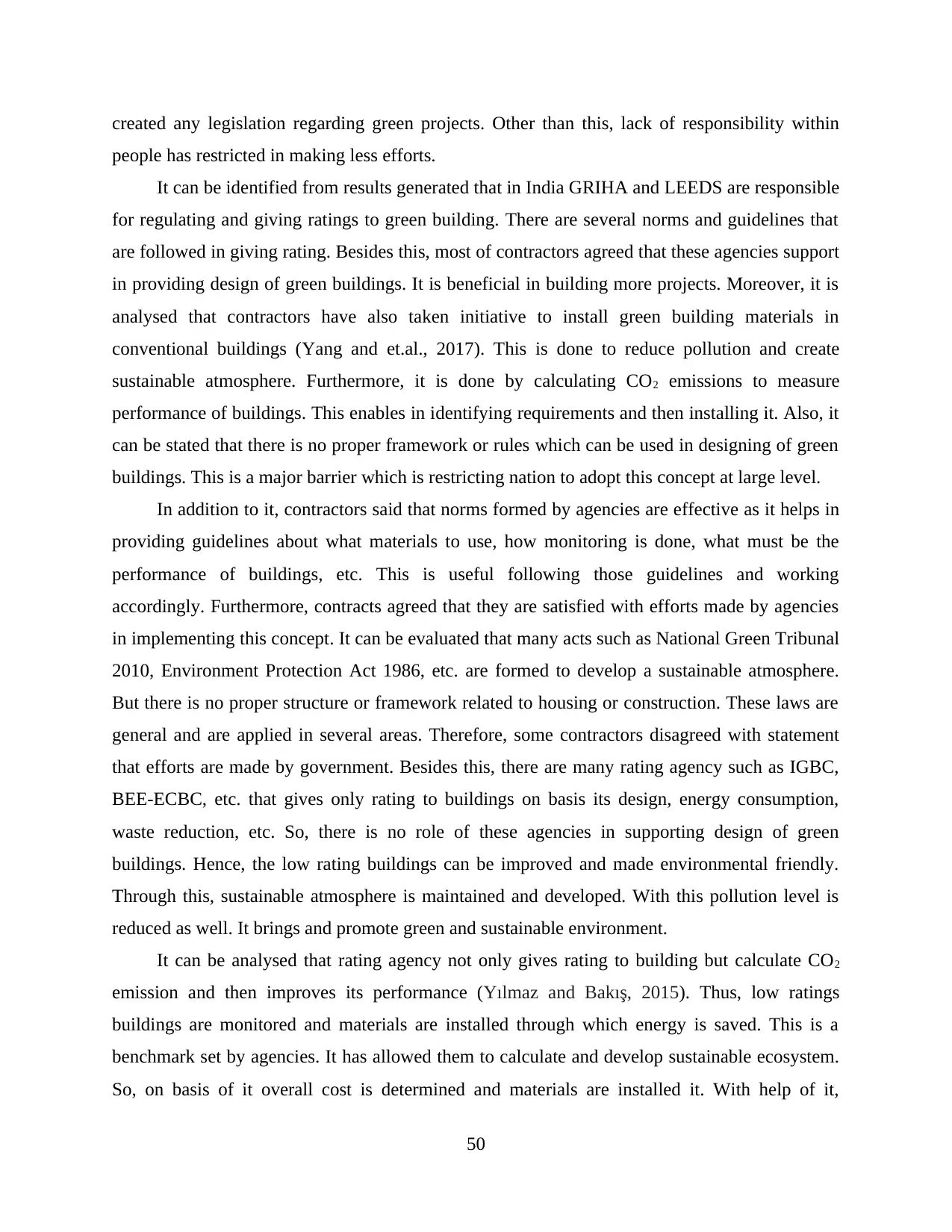
created any legislation regarding green projects. Other than this, lack of responsibility within
people has restricted in making less efforts.
It can be identified from results generated that in India GRIHA and LEEDS are responsible
for regulating and giving ratings to green building. There are several norms and guidelines that
are followed in giving rating. Besides this, most of contractors agreed that these agencies support
in providing design of green buildings. It is beneficial in building more projects. Moreover, it is
analysed that contractors have also taken initiative to install green building materials in
conventional buildings (Yang and et.al., 2017). This is done to reduce pollution and create
sustainable atmosphere. Furthermore, it is done by calculating CO2 emissions to measure
performance of buildings. This enables in identifying requirements and then installing it. Also, it
can be stated that there is no proper framework or rules which can be used in designing of green
buildings. This is a major barrier which is restricting nation to adopt this concept at large level.
In addition to it, contractors said that norms formed by agencies are effective as it helps in
providing guidelines about what materials to use, how monitoring is done, what must be the
performance of buildings, etc. This is useful following those guidelines and working
accordingly. Furthermore, contracts agreed that they are satisfied with efforts made by agencies
in implementing this concept. It can be evaluated that many acts such as National Green Tribunal
2010, Environment Protection Act 1986, etc. are formed to develop a sustainable atmosphere.
But there is no proper structure or framework related to housing or construction. These laws are
general and are applied in several areas. Therefore, some contractors disagreed with statement
that efforts are made by government. Besides this, there are many rating agency such as IGBC,
BEE-ECBC, etc. that gives only rating to buildings on basis its design, energy consumption,
waste reduction, etc. So, there is no role of these agencies in supporting design of green
buildings. Hence, the low rating buildings can be improved and made environmental friendly.
Through this, sustainable atmosphere is maintained and developed. With this pollution level is
reduced as well. It brings and promote green and sustainable environment.
It can be analysed that rating agency not only gives rating to building but calculate CO2
emission and then improves its performance (Yılmaz and Bakış, 2015). Thus, low ratings
buildings are monitored and materials are installed through which energy is saved. This is a
benchmark set by agencies. It has allowed them to calculate and develop sustainable ecosystem.
So, on basis of it overall cost is determined and materials are installed it. With help of it,
50
people has restricted in making less efforts.
It can be identified from results generated that in India GRIHA and LEEDS are responsible
for regulating and giving ratings to green building. There are several norms and guidelines that
are followed in giving rating. Besides this, most of contractors agreed that these agencies support
in providing design of green buildings. It is beneficial in building more projects. Moreover, it is
analysed that contractors have also taken initiative to install green building materials in
conventional buildings (Yang and et.al., 2017). This is done to reduce pollution and create
sustainable atmosphere. Furthermore, it is done by calculating CO2 emissions to measure
performance of buildings. This enables in identifying requirements and then installing it. Also, it
can be stated that there is no proper framework or rules which can be used in designing of green
buildings. This is a major barrier which is restricting nation to adopt this concept at large level.
In addition to it, contractors said that norms formed by agencies are effective as it helps in
providing guidelines about what materials to use, how monitoring is done, what must be the
performance of buildings, etc. This is useful following those guidelines and working
accordingly. Furthermore, contracts agreed that they are satisfied with efforts made by agencies
in implementing this concept. It can be evaluated that many acts such as National Green Tribunal
2010, Environment Protection Act 1986, etc. are formed to develop a sustainable atmosphere.
But there is no proper structure or framework related to housing or construction. These laws are
general and are applied in several areas. Therefore, some contractors disagreed with statement
that efforts are made by government. Besides this, there are many rating agency such as IGBC,
BEE-ECBC, etc. that gives only rating to buildings on basis its design, energy consumption,
waste reduction, etc. So, there is no role of these agencies in supporting design of green
buildings. Hence, the low rating buildings can be improved and made environmental friendly.
Through this, sustainable atmosphere is maintained and developed. With this pollution level is
reduced as well. It brings and promote green and sustainable environment.
It can be analysed that rating agency not only gives rating to building but calculate CO2
emission and then improves its performance (Yılmaz and Bakış, 2015). Thus, low ratings
buildings are monitored and materials are installed through which energy is saved. This is a
benchmark set by agencies. It has allowed them to calculate and develop sustainable ecosystem.
So, on basis of it overall cost is determined and materials are installed it. With help of it,
50
Paraphrase This Document
Need a fresh take? Get an instant paraphrase of this document with our AI Paraphraser
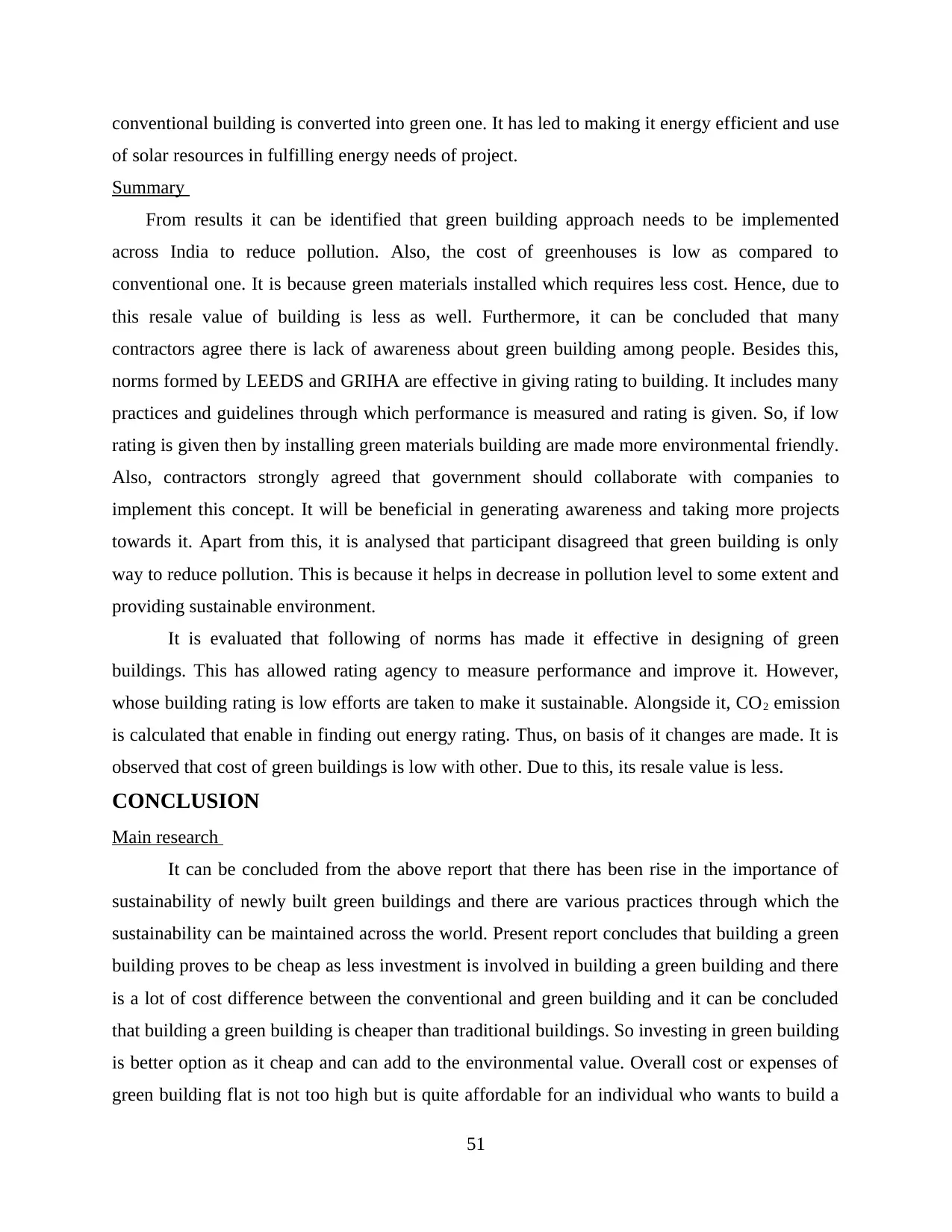
conventional building is converted into green one. It has led to making it energy efficient and use
of solar resources in fulfilling energy needs of project.
Summary
From results it can be identified that green building approach needs to be implemented
across India to reduce pollution. Also, the cost of greenhouses is low as compared to
conventional one. It is because green materials installed which requires less cost. Hence, due to
this resale value of building is less as well. Furthermore, it can be concluded that many
contractors agree there is lack of awareness about green building among people. Besides this,
norms formed by LEEDS and GRIHA are effective in giving rating to building. It includes many
practices and guidelines through which performance is measured and rating is given. So, if low
rating is given then by installing green materials building are made more environmental friendly.
Also, contractors strongly agreed that government should collaborate with companies to
implement this concept. It will be beneficial in generating awareness and taking more projects
towards it. Apart from this, it is analysed that participant disagreed that green building is only
way to reduce pollution. This is because it helps in decrease in pollution level to some extent and
providing sustainable environment.
It is evaluated that following of norms has made it effective in designing of green
buildings. This has allowed rating agency to measure performance and improve it. However,
whose building rating is low efforts are taken to make it sustainable. Alongside it, CO2 emission
is calculated that enable in finding out energy rating. Thus, on basis of it changes are made. It is
observed that cost of green buildings is low with other. Due to this, its resale value is less.
CONCLUSION
Main research
It can be concluded from the above report that there has been rise in the importance of
sustainability of newly built green buildings and there are various practices through which the
sustainability can be maintained across the world. Present report concludes that building a green
building proves to be cheap as less investment is involved in building a green building and there
is a lot of cost difference between the conventional and green building and it can be concluded
that building a green building is cheaper than traditional buildings. So investing in green building
is better option as it cheap and can add to the environmental value. Overall cost or expenses of
green building flat is not too high but is quite affordable for an individual who wants to build a
51
of solar resources in fulfilling energy needs of project.
Summary
From results it can be identified that green building approach needs to be implemented
across India to reduce pollution. Also, the cost of greenhouses is low as compared to
conventional one. It is because green materials installed which requires less cost. Hence, due to
this resale value of building is less as well. Furthermore, it can be concluded that many
contractors agree there is lack of awareness about green building among people. Besides this,
norms formed by LEEDS and GRIHA are effective in giving rating to building. It includes many
practices and guidelines through which performance is measured and rating is given. So, if low
rating is given then by installing green materials building are made more environmental friendly.
Also, contractors strongly agreed that government should collaborate with companies to
implement this concept. It will be beneficial in generating awareness and taking more projects
towards it. Apart from this, it is analysed that participant disagreed that green building is only
way to reduce pollution. This is because it helps in decrease in pollution level to some extent and
providing sustainable environment.
It is evaluated that following of norms has made it effective in designing of green
buildings. This has allowed rating agency to measure performance and improve it. However,
whose building rating is low efforts are taken to make it sustainable. Alongside it, CO2 emission
is calculated that enable in finding out energy rating. Thus, on basis of it changes are made. It is
observed that cost of green buildings is low with other. Due to this, its resale value is less.
CONCLUSION
Main research
It can be concluded from the above report that there has been rise in the importance of
sustainability of newly built green buildings and there are various practices through which the
sustainability can be maintained across the world. Present report concludes that building a green
building proves to be cheap as less investment is involved in building a green building and there
is a lot of cost difference between the conventional and green building and it can be concluded
that building a green building is cheaper than traditional buildings. So investing in green building
is better option as it cheap and can add to the environmental value. Overall cost or expenses of
green building flat is not too high but is quite affordable for an individual who wants to build a
51
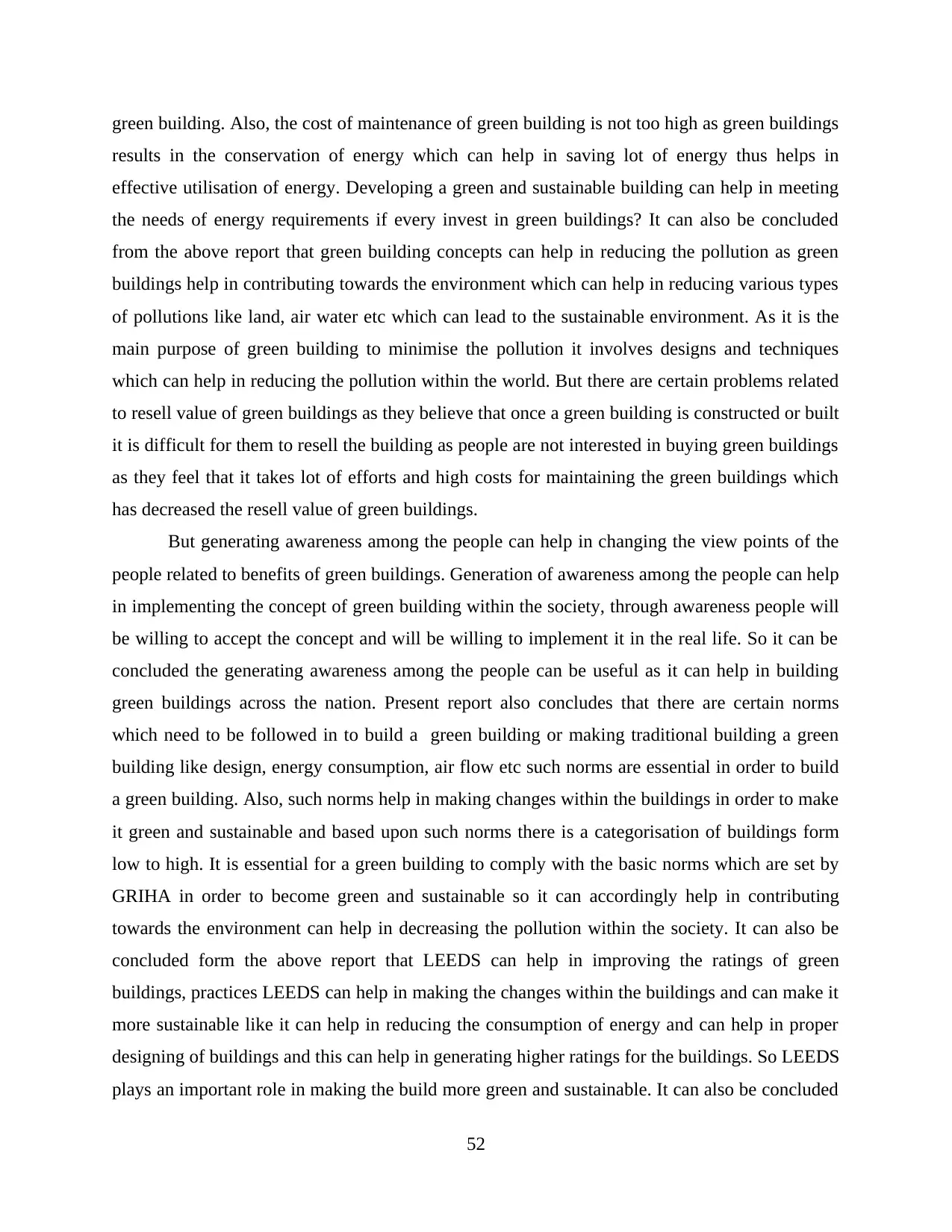
green building. Also, the cost of maintenance of green building is not too high as green buildings
results in the conservation of energy which can help in saving lot of energy thus helps in
effective utilisation of energy. Developing a green and sustainable building can help in meeting
the needs of energy requirements if every invest in green buildings? It can also be concluded
from the above report that green building concepts can help in reducing the pollution as green
buildings help in contributing towards the environment which can help in reducing various types
of pollutions like land, air water etc which can lead to the sustainable environment. As it is the
main purpose of green building to minimise the pollution it involves designs and techniques
which can help in reducing the pollution within the world. But there are certain problems related
to resell value of green buildings as they believe that once a green building is constructed or built
it is difficult for them to resell the building as people are not interested in buying green buildings
as they feel that it takes lot of efforts and high costs for maintaining the green buildings which
has decreased the resell value of green buildings.
But generating awareness among the people can help in changing the view points of the
people related to benefits of green buildings. Generation of awareness among the people can help
in implementing the concept of green building within the society, through awareness people will
be willing to accept the concept and will be willing to implement it in the real life. So it can be
concluded the generating awareness among the people can be useful as it can help in building
green buildings across the nation. Present report also concludes that there are certain norms
which need to be followed in to build a green building or making traditional building a green
building like design, energy consumption, air flow etc such norms are essential in order to build
a green building. Also, such norms help in making changes within the buildings in order to make
it green and sustainable and based upon such norms there is a categorisation of buildings form
low to high. It is essential for a green building to comply with the basic norms which are set by
GRIHA in order to become green and sustainable so it can accordingly help in contributing
towards the environment can help in decreasing the pollution within the society. It can also be
concluded form the above report that LEEDS can help in improving the ratings of green
buildings, practices LEEDS can help in making the changes within the buildings and can make it
more sustainable like it can help in reducing the consumption of energy and can help in proper
designing of buildings and this can help in generating higher ratings for the buildings. So LEEDS
plays an important role in making the build more green and sustainable. It can also be concluded
52
results in the conservation of energy which can help in saving lot of energy thus helps in
effective utilisation of energy. Developing a green and sustainable building can help in meeting
the needs of energy requirements if every invest in green buildings? It can also be concluded
from the above report that green building concepts can help in reducing the pollution as green
buildings help in contributing towards the environment which can help in reducing various types
of pollutions like land, air water etc which can lead to the sustainable environment. As it is the
main purpose of green building to minimise the pollution it involves designs and techniques
which can help in reducing the pollution within the world. But there are certain problems related
to resell value of green buildings as they believe that once a green building is constructed or built
it is difficult for them to resell the building as people are not interested in buying green buildings
as they feel that it takes lot of efforts and high costs for maintaining the green buildings which
has decreased the resell value of green buildings.
But generating awareness among the people can help in changing the view points of the
people related to benefits of green buildings. Generation of awareness among the people can help
in implementing the concept of green building within the society, through awareness people will
be willing to accept the concept and will be willing to implement it in the real life. So it can be
concluded the generating awareness among the people can be useful as it can help in building
green buildings across the nation. Present report also concludes that there are certain norms
which need to be followed in to build a green building or making traditional building a green
building like design, energy consumption, air flow etc such norms are essential in order to build
a green building. Also, such norms help in making changes within the buildings in order to make
it green and sustainable and based upon such norms there is a categorisation of buildings form
low to high. It is essential for a green building to comply with the basic norms which are set by
GRIHA in order to become green and sustainable so it can accordingly help in contributing
towards the environment can help in decreasing the pollution within the society. It can also be
concluded form the above report that LEEDS can help in improving the ratings of green
buildings, practices LEEDS can help in making the changes within the buildings and can make it
more sustainable like it can help in reducing the consumption of energy and can help in proper
designing of buildings and this can help in generating higher ratings for the buildings. So LEEDS
plays an important role in making the build more green and sustainable. It can also be concluded
52
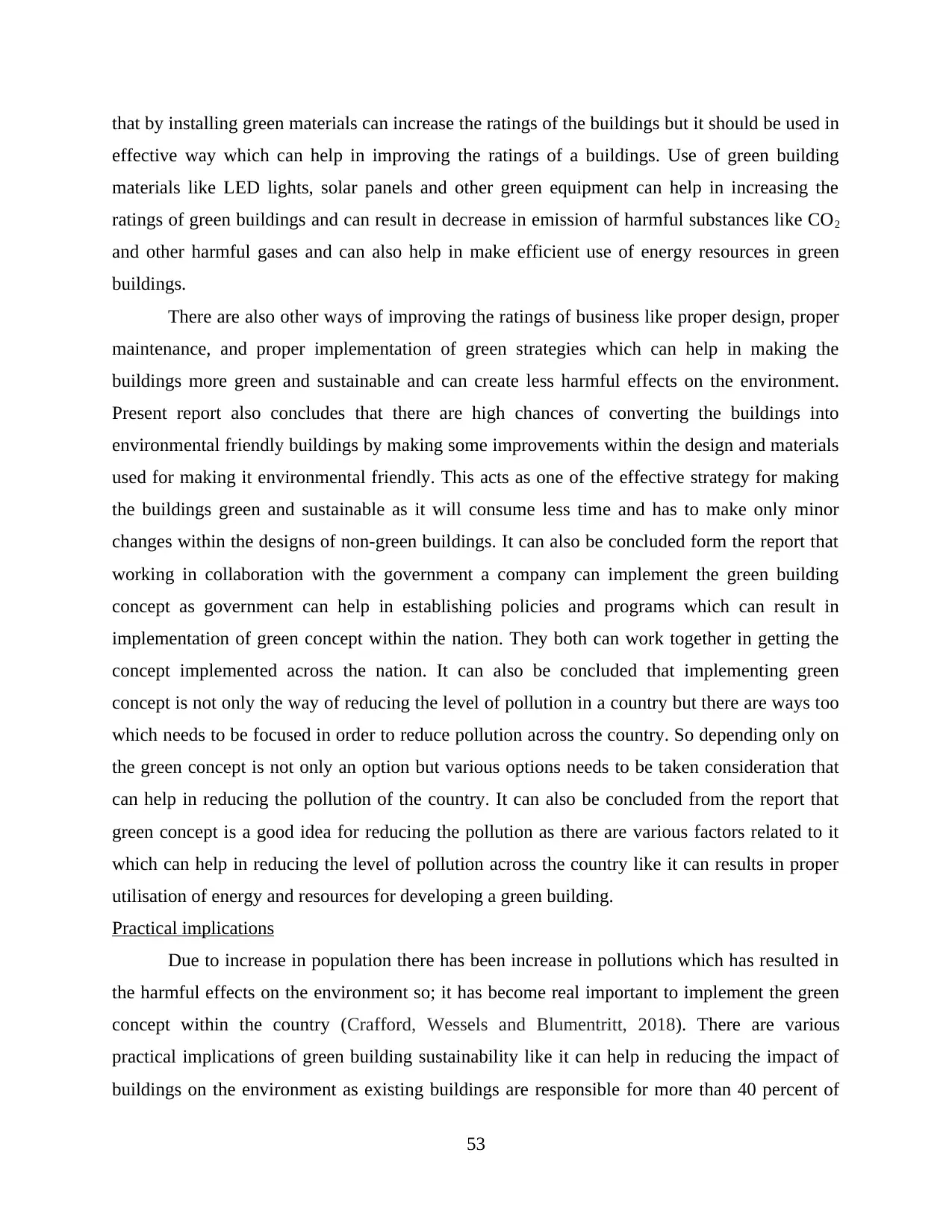
that by installing green materials can increase the ratings of the buildings but it should be used in
effective way which can help in improving the ratings of a buildings. Use of green building
materials like LED lights, solar panels and other green equipment can help in increasing the
ratings of green buildings and can result in decrease in emission of harmful substances like CO2
and other harmful gases and can also help in make efficient use of energy resources in green
buildings.
There are also other ways of improving the ratings of business like proper design, proper
maintenance, and proper implementation of green strategies which can help in making the
buildings more green and sustainable and can create less harmful effects on the environment.
Present report also concludes that there are high chances of converting the buildings into
environmental friendly buildings by making some improvements within the design and materials
used for making it environmental friendly. This acts as one of the effective strategy for making
the buildings green and sustainable as it will consume less time and has to make only minor
changes within the designs of non-green buildings. It can also be concluded form the report that
working in collaboration with the government a company can implement the green building
concept as government can help in establishing policies and programs which can result in
implementation of green concept within the nation. They both can work together in getting the
concept implemented across the nation. It can also be concluded that implementing green
concept is not only the way of reducing the level of pollution in a country but there are ways too
which needs to be focused in order to reduce pollution across the country. So depending only on
the green concept is not only an option but various options needs to be taken consideration that
can help in reducing the pollution of the country. It can also be concluded from the report that
green concept is a good idea for reducing the pollution as there are various factors related to it
which can help in reducing the level of pollution across the country like it can results in proper
utilisation of energy and resources for developing a green building.
Practical implications
Due to increase in population there has been increase in pollutions which has resulted in
the harmful effects on the environment so; it has become real important to implement the green
concept within the country (Crafford, Wessels and Blumentritt, 2018). There are various
practical implications of green building sustainability like it can help in reducing the impact of
buildings on the environment as existing buildings are responsible for more than 40 percent of
53
effective way which can help in improving the ratings of a buildings. Use of green building
materials like LED lights, solar panels and other green equipment can help in increasing the
ratings of green buildings and can result in decrease in emission of harmful substances like CO2
and other harmful gases and can also help in make efficient use of energy resources in green
buildings.
There are also other ways of improving the ratings of business like proper design, proper
maintenance, and proper implementation of green strategies which can help in making the
buildings more green and sustainable and can create less harmful effects on the environment.
Present report also concludes that there are high chances of converting the buildings into
environmental friendly buildings by making some improvements within the design and materials
used for making it environmental friendly. This acts as one of the effective strategy for making
the buildings green and sustainable as it will consume less time and has to make only minor
changes within the designs of non-green buildings. It can also be concluded form the report that
working in collaboration with the government a company can implement the green building
concept as government can help in establishing policies and programs which can result in
implementation of green concept within the nation. They both can work together in getting the
concept implemented across the nation. It can also be concluded that implementing green
concept is not only the way of reducing the level of pollution in a country but there are ways too
which needs to be focused in order to reduce pollution across the country. So depending only on
the green concept is not only an option but various options needs to be taken consideration that
can help in reducing the pollution of the country. It can also be concluded from the report that
green concept is a good idea for reducing the pollution as there are various factors related to it
which can help in reducing the level of pollution across the country like it can results in proper
utilisation of energy and resources for developing a green building.
Practical implications
Due to increase in population there has been increase in pollutions which has resulted in
the harmful effects on the environment so; it has become real important to implement the green
concept within the country (Crafford, Wessels and Blumentritt, 2018). There are various
practical implications of green building sustainability like it can help in reducing the impact of
buildings on the environment as existing buildings are responsible for more than 40 percent of
53
Secure Best Marks with AI Grader
Need help grading? Try our AI Grader for instant feedback on your assignments.
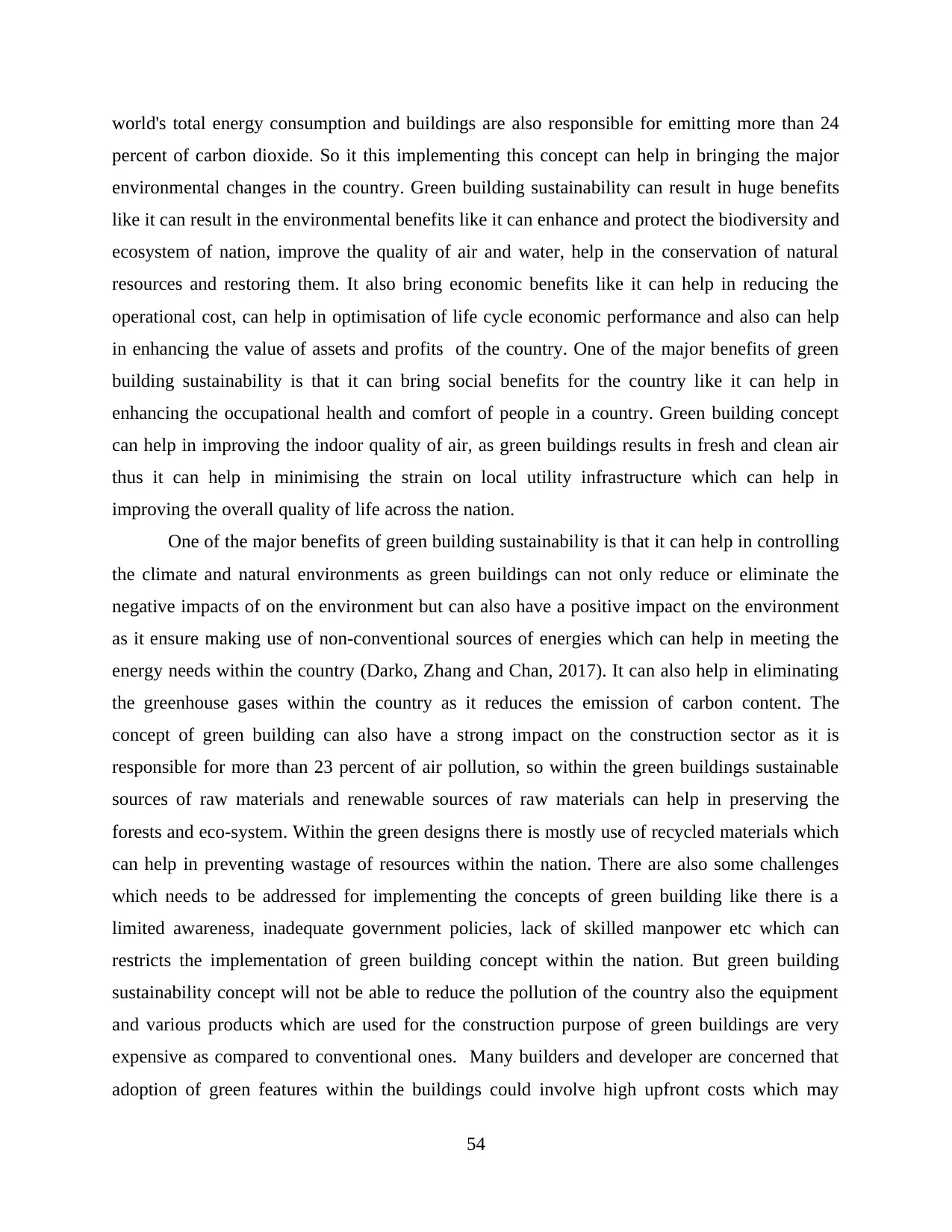
world's total energy consumption and buildings are also responsible for emitting more than 24
percent of carbon dioxide. So it this implementing this concept can help in bringing the major
environmental changes in the country. Green building sustainability can result in huge benefits
like it can result in the environmental benefits like it can enhance and protect the biodiversity and
ecosystem of nation, improve the quality of air and water, help in the conservation of natural
resources and restoring them. It also bring economic benefits like it can help in reducing the
operational cost, can help in optimisation of life cycle economic performance and also can help
in enhancing the value of assets and profits of the country. One of the major benefits of green
building sustainability is that it can bring social benefits for the country like it can help in
enhancing the occupational health and comfort of people in a country. Green building concept
can help in improving the indoor quality of air, as green buildings results in fresh and clean air
thus it can help in minimising the strain on local utility infrastructure which can help in
improving the overall quality of life across the nation.
One of the major benefits of green building sustainability is that it can help in controlling
the climate and natural environments as green buildings can not only reduce or eliminate the
negative impacts of on the environment but can also have a positive impact on the environment
as it ensure making use of non-conventional sources of energies which can help in meeting the
energy needs within the country (Darko, Zhang and Chan, 2017). It can also help in eliminating
the greenhouse gases within the country as it reduces the emission of carbon content. The
concept of green building can also have a strong impact on the construction sector as it is
responsible for more than 23 percent of air pollution, so within the green buildings sustainable
sources of raw materials and renewable sources of raw materials can help in preserving the
forests and eco-system. Within the green designs there is mostly use of recycled materials which
can help in preventing wastage of resources within the nation. There are also some challenges
which needs to be addressed for implementing the concepts of green building like there is a
limited awareness, inadequate government policies, lack of skilled manpower etc which can
restricts the implementation of green building concept within the nation. But green building
sustainability concept will not be able to reduce the pollution of the country also the equipment
and various products which are used for the construction purpose of green buildings are very
expensive as compared to conventional ones. Many builders and developer are concerned that
adoption of green features within the buildings could involve high upfront costs which may
54
percent of carbon dioxide. So it this implementing this concept can help in bringing the major
environmental changes in the country. Green building sustainability can result in huge benefits
like it can result in the environmental benefits like it can enhance and protect the biodiversity and
ecosystem of nation, improve the quality of air and water, help in the conservation of natural
resources and restoring them. It also bring economic benefits like it can help in reducing the
operational cost, can help in optimisation of life cycle economic performance and also can help
in enhancing the value of assets and profits of the country. One of the major benefits of green
building sustainability is that it can bring social benefits for the country like it can help in
enhancing the occupational health and comfort of people in a country. Green building concept
can help in improving the indoor quality of air, as green buildings results in fresh and clean air
thus it can help in minimising the strain on local utility infrastructure which can help in
improving the overall quality of life across the nation.
One of the major benefits of green building sustainability is that it can help in controlling
the climate and natural environments as green buildings can not only reduce or eliminate the
negative impacts of on the environment but can also have a positive impact on the environment
as it ensure making use of non-conventional sources of energies which can help in meeting the
energy needs within the country (Darko, Zhang and Chan, 2017). It can also help in eliminating
the greenhouse gases within the country as it reduces the emission of carbon content. The
concept of green building can also have a strong impact on the construction sector as it is
responsible for more than 23 percent of air pollution, so within the green buildings sustainable
sources of raw materials and renewable sources of raw materials can help in preserving the
forests and eco-system. Within the green designs there is mostly use of recycled materials which
can help in preventing wastage of resources within the nation. There are also some challenges
which needs to be addressed for implementing the concepts of green building like there is a
limited awareness, inadequate government policies, lack of skilled manpower etc which can
restricts the implementation of green building concept within the nation. But green building
sustainability concept will not be able to reduce the pollution of the country also the equipment
and various products which are used for the construction purpose of green buildings are very
expensive as compared to conventional ones. Many builders and developer are concerned that
adoption of green features within the buildings could involve high upfront costs which may
54
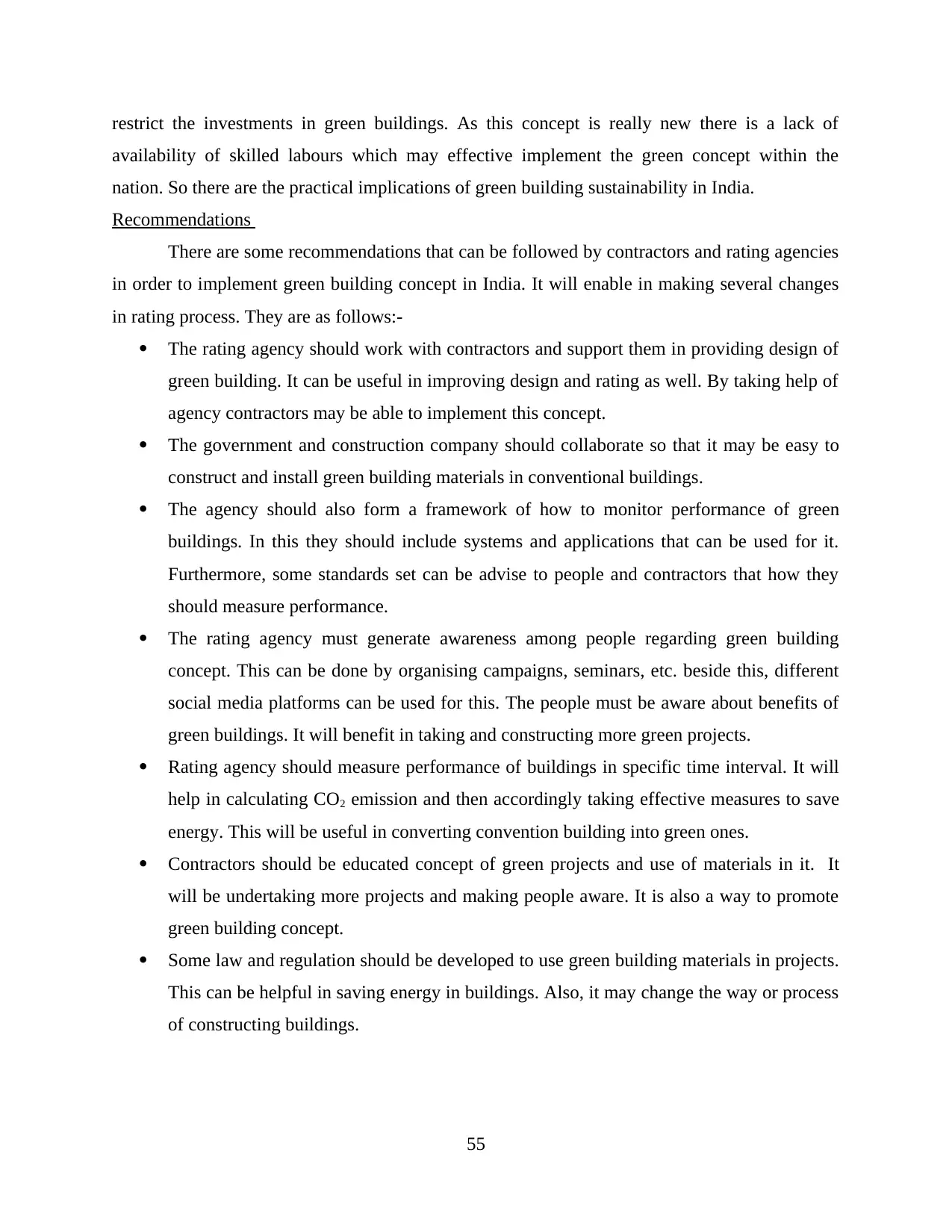
restrict the investments in green buildings. As this concept is really new there is a lack of
availability of skilled labours which may effective implement the green concept within the
nation. So there are the practical implications of green building sustainability in India.
Recommendations
There are some recommendations that can be followed by contractors and rating agencies
in order to implement green building concept in India. It will enable in making several changes
in rating process. They are as follows:-
The rating agency should work with contractors and support them in providing design of
green building. It can be useful in improving design and rating as well. By taking help of
agency contractors may be able to implement this concept.
The government and construction company should collaborate so that it may be easy to
construct and install green building materials in conventional buildings.
The agency should also form a framework of how to monitor performance of green
buildings. In this they should include systems and applications that can be used for it.
Furthermore, some standards set can be advise to people and contractors that how they
should measure performance.
The rating agency must generate awareness among people regarding green building
concept. This can be done by organising campaigns, seminars, etc. beside this, different
social media platforms can be used for this. The people must be aware about benefits of
green buildings. It will benefit in taking and constructing more green projects.
Rating agency should measure performance of buildings in specific time interval. It will
help in calculating CO2 emission and then accordingly taking effective measures to save
energy. This will be useful in converting convention building into green ones.
Contractors should be educated concept of green projects and use of materials in it. It
will be undertaking more projects and making people aware. It is also a way to promote
green building concept.
Some law and regulation should be developed to use green building materials in projects.
This can be helpful in saving energy in buildings. Also, it may change the way or process
of constructing buildings.
55
availability of skilled labours which may effective implement the green concept within the
nation. So there are the practical implications of green building sustainability in India.
Recommendations
There are some recommendations that can be followed by contractors and rating agencies
in order to implement green building concept in India. It will enable in making several changes
in rating process. They are as follows:-
The rating agency should work with contractors and support them in providing design of
green building. It can be useful in improving design and rating as well. By taking help of
agency contractors may be able to implement this concept.
The government and construction company should collaborate so that it may be easy to
construct and install green building materials in conventional buildings.
The agency should also form a framework of how to monitor performance of green
buildings. In this they should include systems and applications that can be used for it.
Furthermore, some standards set can be advise to people and contractors that how they
should measure performance.
The rating agency must generate awareness among people regarding green building
concept. This can be done by organising campaigns, seminars, etc. beside this, different
social media platforms can be used for this. The people must be aware about benefits of
green buildings. It will benefit in taking and constructing more green projects.
Rating agency should measure performance of buildings in specific time interval. It will
help in calculating CO2 emission and then accordingly taking effective measures to save
energy. This will be useful in converting convention building into green ones.
Contractors should be educated concept of green projects and use of materials in it. It
will be undertaking more projects and making people aware. It is also a way to promote
green building concept.
Some law and regulation should be developed to use green building materials in projects.
This can be helpful in saving energy in buildings. Also, it may change the way or process
of constructing buildings.
55
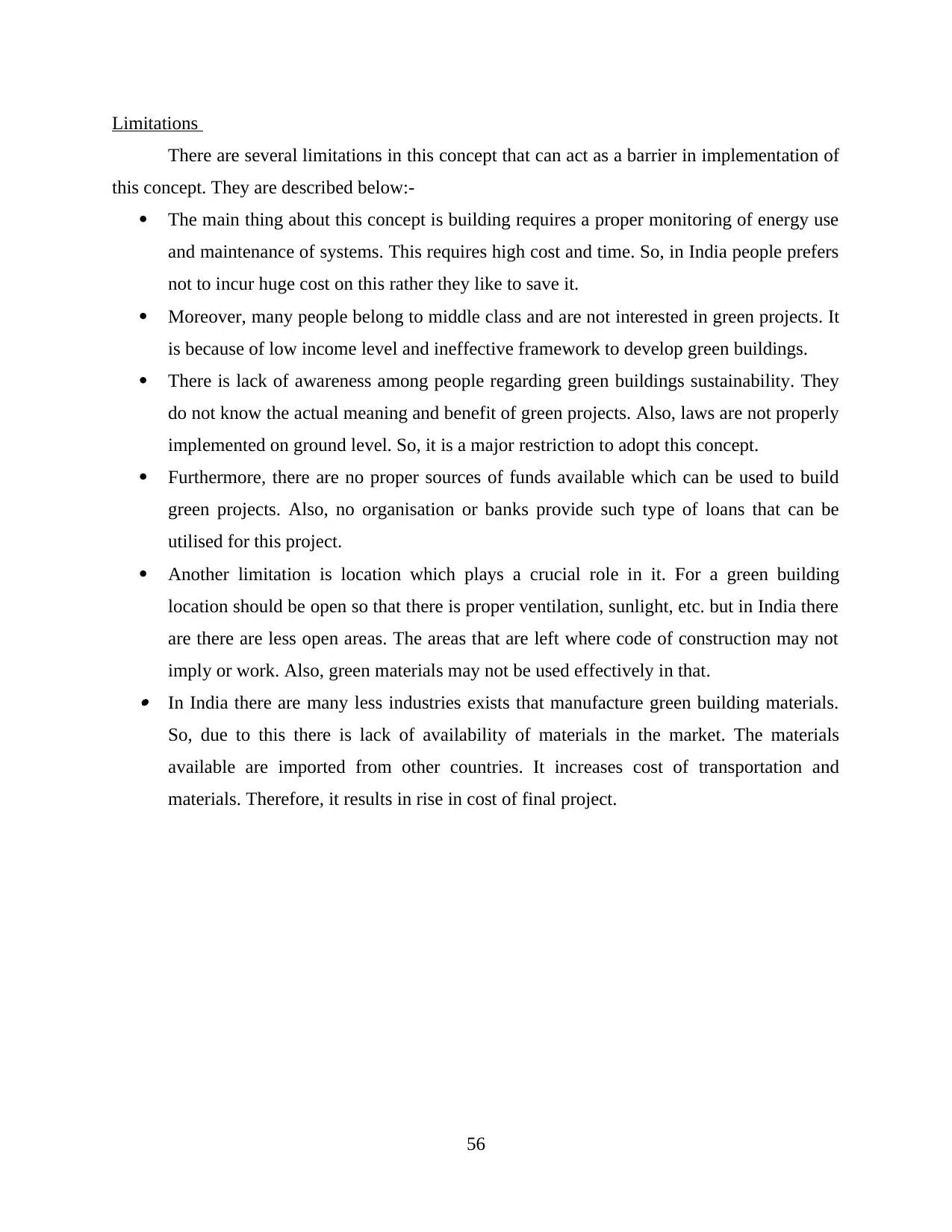
Limitations
There are several limitations in this concept that can act as a barrier in implementation of
this concept. They are described below:-
The main thing about this concept is building requires a proper monitoring of energy use
and maintenance of systems. This requires high cost and time. So, in India people prefers
not to incur huge cost on this rather they like to save it.
Moreover, many people belong to middle class and are not interested in green projects. It
is because of low income level and ineffective framework to develop green buildings.
There is lack of awareness among people regarding green buildings sustainability. They
do not know the actual meaning and benefit of green projects. Also, laws are not properly
implemented on ground level. So, it is a major restriction to adopt this concept.
Furthermore, there are no proper sources of funds available which can be used to build
green projects. Also, no organisation or banks provide such type of loans that can be
utilised for this project.
Another limitation is location which plays a crucial role in it. For a green building
location should be open so that there is proper ventilation, sunlight, etc. but in India there
are there are less open areas. The areas that are left where code of construction may not
imply or work. Also, green materials may not be used effectively in that. In India there are many less industries exists that manufacture green building materials.
So, due to this there is lack of availability of materials in the market. The materials
available are imported from other countries. It increases cost of transportation and
materials. Therefore, it results in rise in cost of final project.
56
There are several limitations in this concept that can act as a barrier in implementation of
this concept. They are described below:-
The main thing about this concept is building requires a proper monitoring of energy use
and maintenance of systems. This requires high cost and time. So, in India people prefers
not to incur huge cost on this rather they like to save it.
Moreover, many people belong to middle class and are not interested in green projects. It
is because of low income level and ineffective framework to develop green buildings.
There is lack of awareness among people regarding green buildings sustainability. They
do not know the actual meaning and benefit of green projects. Also, laws are not properly
implemented on ground level. So, it is a major restriction to adopt this concept.
Furthermore, there are no proper sources of funds available which can be used to build
green projects. Also, no organisation or banks provide such type of loans that can be
utilised for this project.
Another limitation is location which plays a crucial role in it. For a green building
location should be open so that there is proper ventilation, sunlight, etc. but in India there
are there are less open areas. The areas that are left where code of construction may not
imply or work. Also, green materials may not be used effectively in that. In India there are many less industries exists that manufacture green building materials.
So, due to this there is lack of availability of materials in the market. The materials
available are imported from other countries. It increases cost of transportation and
materials. Therefore, it results in rise in cost of final project.
56
Paraphrase This Document
Need a fresh take? Get an instant paraphrase of this document with our AI Paraphraser
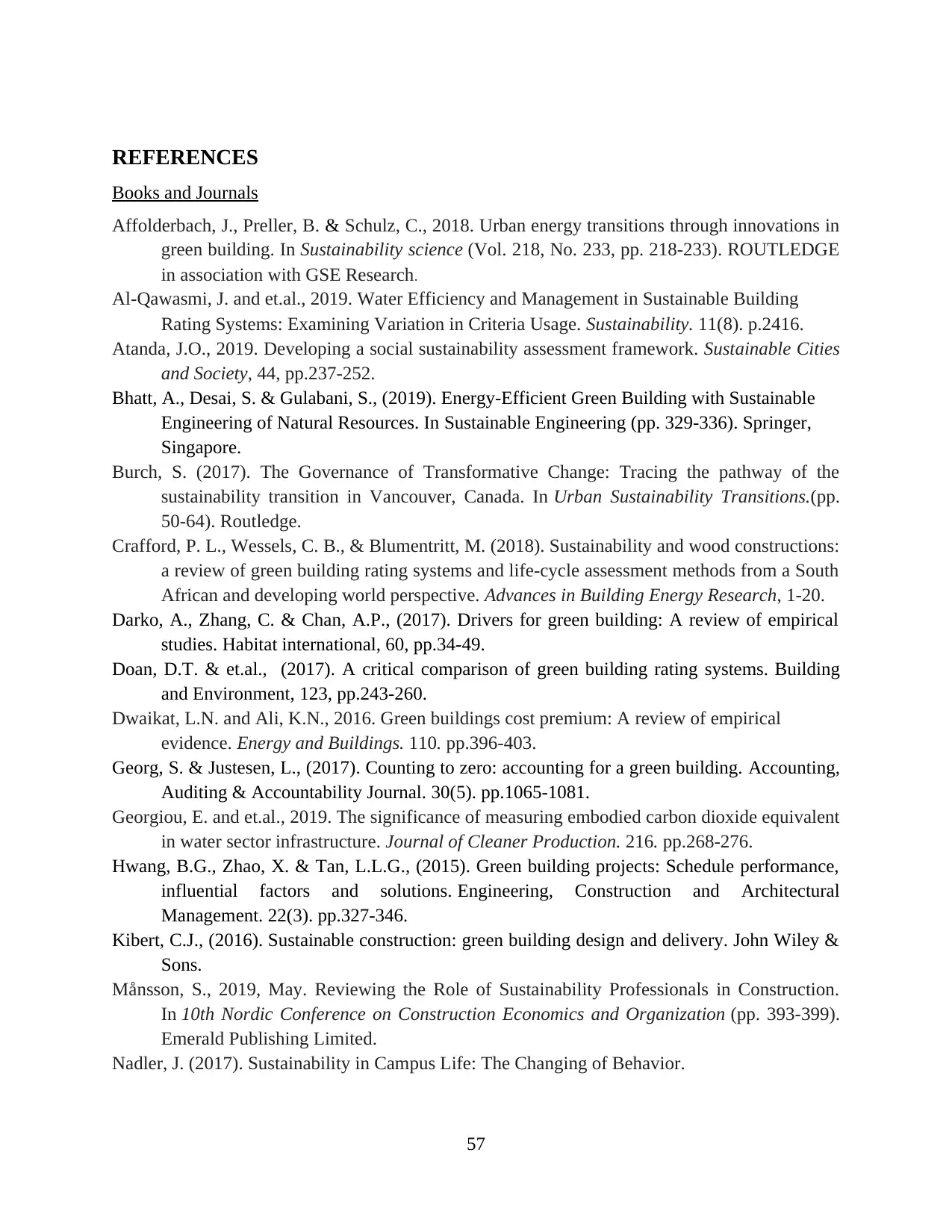
REFERENCES
Books and Journals
Affolderbach, J., Preller, B. & Schulz, C., 2018. Urban energy transitions through innovations in
green building. In Sustainability science (Vol. 218, No. 233, pp. 218-233). ROUTLEDGE
in association with GSE Research.
Al-Qawasmi, J. and et.al., 2019. Water Efficiency and Management in Sustainable Building
Rating Systems: Examining Variation in Criteria Usage. Sustainability. 11(8). p.2416.
Atanda, J.O., 2019. Developing a social sustainability assessment framework. Sustainable Cities
and Society, 44, pp.237-252.
Bhatt, A., Desai, S. & Gulabani, S., (2019). Energy-Efficient Green Building with Sustainable
Engineering of Natural Resources. In Sustainable Engineering (pp. 329-336). Springer,
Singapore.
Burch, S. (2017). The Governance of Transformative Change: Tracing the pathway of the
sustainability transition in Vancouver, Canada. In Urban Sustainability Transitions.(pp.
50-64). Routledge.
Crafford, P. L., Wessels, C. B., & Blumentritt, M. (2018). Sustainability and wood constructions:
a review of green building rating systems and life-cycle assessment methods from a South
African and developing world perspective. Advances in Building Energy Research, 1-20.
Darko, A., Zhang, C. & Chan, A.P., (2017). Drivers for green building: A review of empirical
studies. Habitat international, 60, pp.34-49.
Doan, D.T. & et.al., (2017). A critical comparison of green building rating systems. Building
and Environment, 123, pp.243-260.
Dwaikat, L.N. and Ali, K.N., 2016. Green buildings cost premium: A review of empirical
evidence. Energy and Buildings. 110. pp.396-403.
Georg, S. & Justesen, L., (2017). Counting to zero: accounting for a green building. Accounting,
Auditing & Accountability Journal. 30(5). pp.1065-1081.
Georgiou, E. and et.al., 2019. The significance of measuring embodied carbon dioxide equivalent
in water sector infrastructure. Journal of Cleaner Production. 216. pp.268-276.
Hwang, B.G., Zhao, X. & Tan, L.L.G., (2015). Green building projects: Schedule performance,
influential factors and solutions. Engineering, Construction and Architectural
Management. 22(3). pp.327-346.
Kibert, C.J., (2016). Sustainable construction: green building design and delivery. John Wiley &
Sons.
Månsson, S., 2019, May. Reviewing the Role of Sustainability Professionals in Construction.
In 10th Nordic Conference on Construction Economics and Organization (pp. 393-399).
Emerald Publishing Limited.
Nadler, J. (2017). Sustainability in Campus Life: The Changing of Behavior.
57
Books and Journals
Affolderbach, J., Preller, B. & Schulz, C., 2018. Urban energy transitions through innovations in
green building. In Sustainability science (Vol. 218, No. 233, pp. 218-233). ROUTLEDGE
in association with GSE Research.
Al-Qawasmi, J. and et.al., 2019. Water Efficiency and Management in Sustainable Building
Rating Systems: Examining Variation in Criteria Usage. Sustainability. 11(8). p.2416.
Atanda, J.O., 2019. Developing a social sustainability assessment framework. Sustainable Cities
and Society, 44, pp.237-252.
Bhatt, A., Desai, S. & Gulabani, S., (2019). Energy-Efficient Green Building with Sustainable
Engineering of Natural Resources. In Sustainable Engineering (pp. 329-336). Springer,
Singapore.
Burch, S. (2017). The Governance of Transformative Change: Tracing the pathway of the
sustainability transition in Vancouver, Canada. In Urban Sustainability Transitions.(pp.
50-64). Routledge.
Crafford, P. L., Wessels, C. B., & Blumentritt, M. (2018). Sustainability and wood constructions:
a review of green building rating systems and life-cycle assessment methods from a South
African and developing world perspective. Advances in Building Energy Research, 1-20.
Darko, A., Zhang, C. & Chan, A.P., (2017). Drivers for green building: A review of empirical
studies. Habitat international, 60, pp.34-49.
Doan, D.T. & et.al., (2017). A critical comparison of green building rating systems. Building
and Environment, 123, pp.243-260.
Dwaikat, L.N. and Ali, K.N., 2016. Green buildings cost premium: A review of empirical
evidence. Energy and Buildings. 110. pp.396-403.
Georg, S. & Justesen, L., (2017). Counting to zero: accounting for a green building. Accounting,
Auditing & Accountability Journal. 30(5). pp.1065-1081.
Georgiou, E. and et.al., 2019. The significance of measuring embodied carbon dioxide equivalent
in water sector infrastructure. Journal of Cleaner Production. 216. pp.268-276.
Hwang, B.G., Zhao, X. & Tan, L.L.G., (2015). Green building projects: Schedule performance,
influential factors and solutions. Engineering, Construction and Architectural
Management. 22(3). pp.327-346.
Kibert, C.J., (2016). Sustainable construction: green building design and delivery. John Wiley &
Sons.
Månsson, S., 2019, May. Reviewing the Role of Sustainability Professionals in Construction.
In 10th Nordic Conference on Construction Economics and Organization (pp. 393-399).
Emerald Publishing Limited.
Nadler, J. (2017). Sustainability in Campus Life: The Changing of Behavior.
57
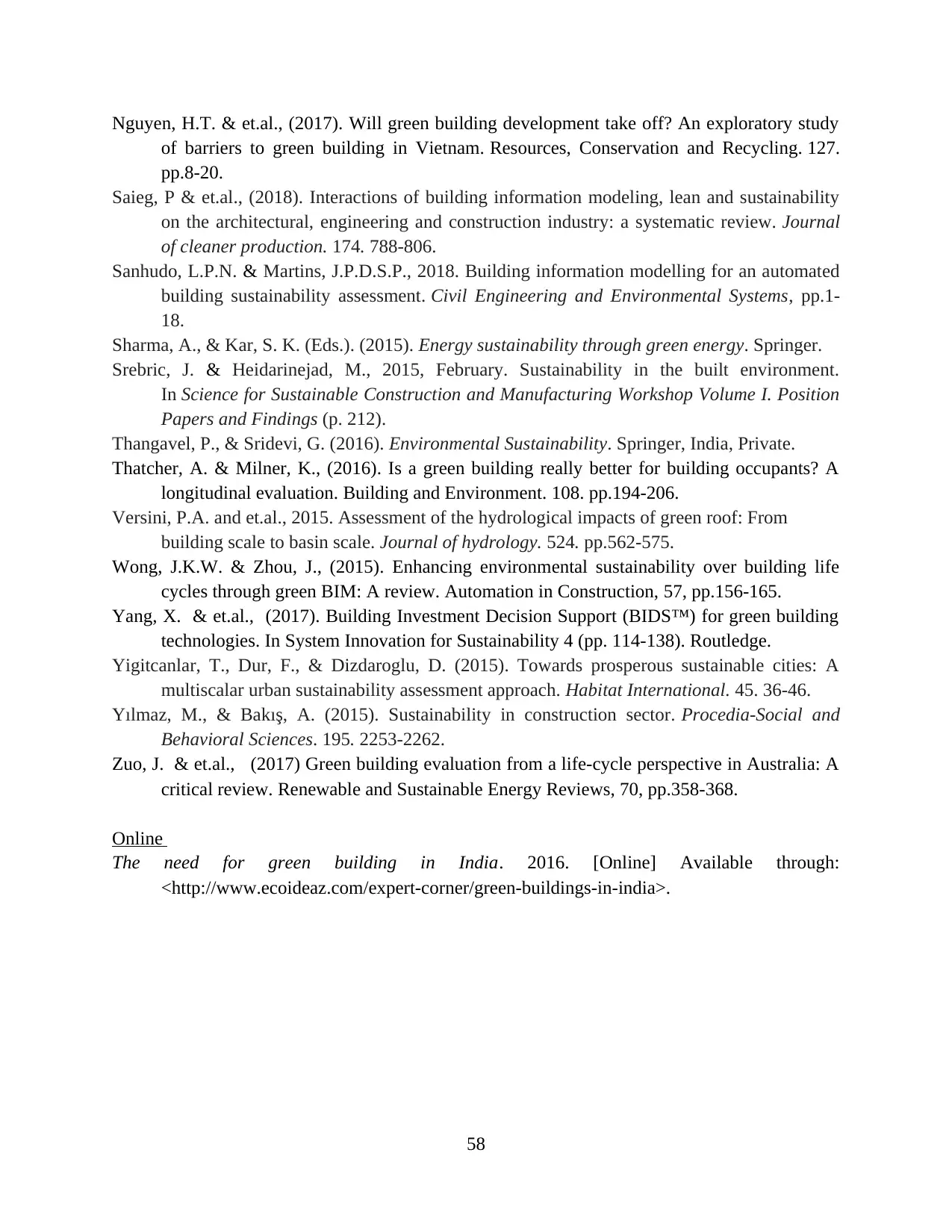
Nguyen, H.T. & et.al., (2017). Will green building development take off? An exploratory study
of barriers to green building in Vietnam. Resources, Conservation and Recycling. 127.
pp.8-20.
Saieg, P & et.al., (2018). Interactions of building information modeling, lean and sustainability
on the architectural, engineering and construction industry: a systematic review. Journal
of cleaner production. 174. 788-806.
Sanhudo, L.P.N. & Martins, J.P.D.S.P., 2018. Building information modelling for an automated
building sustainability assessment. Civil Engineering and Environmental Systems, pp.1-
18.
Sharma, A., & Kar, S. K. (Eds.). (2015). Energy sustainability through green energy. Springer.
Srebric, J. & Heidarinejad, M., 2015, February. Sustainability in the built environment.
In Science for Sustainable Construction and Manufacturing Workshop Volume I. Position
Papers and Findings (p. 212).
Thangavel, P., & Sridevi, G. (2016). Environmental Sustainability. Springer, India, Private.
Thatcher, A. & Milner, K., (2016). Is a green building really better for building occupants? A
longitudinal evaluation. Building and Environment. 108. pp.194-206.
Versini, P.A. and et.al., 2015. Assessment of the hydrological impacts of green roof: From
building scale to basin scale. Journal of hydrology. 524. pp.562-575.
Wong, J.K.W. & Zhou, J., (2015). Enhancing environmental sustainability over building life
cycles through green BIM: A review. Automation in Construction, 57, pp.156-165.
Yang, X. & et.al., (2017). Building Investment Decision Support (BIDS™) for green building
technologies. In System Innovation for Sustainability 4 (pp. 114-138). Routledge.
Yigitcanlar, T., Dur, F., & Dizdaroglu, D. (2015). Towards prosperous sustainable cities: A
multiscalar urban sustainability assessment approach. Habitat International. 45. 36-46.
Yılmaz, M., & Bakış, A. (2015). Sustainability in construction sector. Procedia-Social and
Behavioral Sciences. 195. 2253-2262.
Zuo, J. & et.al., (2017) Green building evaluation from a life-cycle perspective in Australia: A
critical review. Renewable and Sustainable Energy Reviews, 70, pp.358-368.
Online
The need for green building in India. 2016. [Online] Available through:
<http://www.ecoideaz.com/expert-corner/green-buildings-in-india>.
58
of barriers to green building in Vietnam. Resources, Conservation and Recycling. 127.
pp.8-20.
Saieg, P & et.al., (2018). Interactions of building information modeling, lean and sustainability
on the architectural, engineering and construction industry: a systematic review. Journal
of cleaner production. 174. 788-806.
Sanhudo, L.P.N. & Martins, J.P.D.S.P., 2018. Building information modelling for an automated
building sustainability assessment. Civil Engineering and Environmental Systems, pp.1-
18.
Sharma, A., & Kar, S. K. (Eds.). (2015). Energy sustainability through green energy. Springer.
Srebric, J. & Heidarinejad, M., 2015, February. Sustainability in the built environment.
In Science for Sustainable Construction and Manufacturing Workshop Volume I. Position
Papers and Findings (p. 212).
Thangavel, P., & Sridevi, G. (2016). Environmental Sustainability. Springer, India, Private.
Thatcher, A. & Milner, K., (2016). Is a green building really better for building occupants? A
longitudinal evaluation. Building and Environment. 108. pp.194-206.
Versini, P.A. and et.al., 2015. Assessment of the hydrological impacts of green roof: From
building scale to basin scale. Journal of hydrology. 524. pp.562-575.
Wong, J.K.W. & Zhou, J., (2015). Enhancing environmental sustainability over building life
cycles through green BIM: A review. Automation in Construction, 57, pp.156-165.
Yang, X. & et.al., (2017). Building Investment Decision Support (BIDS™) for green building
technologies. In System Innovation for Sustainability 4 (pp. 114-138). Routledge.
Yigitcanlar, T., Dur, F., & Dizdaroglu, D. (2015). Towards prosperous sustainable cities: A
multiscalar urban sustainability assessment approach. Habitat International. 45. 36-46.
Yılmaz, M., & Bakış, A. (2015). Sustainability in construction sector. Procedia-Social and
Behavioral Sciences. 195. 2253-2262.
Zuo, J. & et.al., (2017) Green building evaluation from a life-cycle perspective in Australia: A
critical review. Renewable and Sustainable Energy Reviews, 70, pp.358-368.
Online
The need for green building in India. 2016. [Online] Available through:
<http://www.ecoideaz.com/expert-corner/green-buildings-in-india>.
58

Appendix
Questionnaire 1
Questionnaire
Name
Age
Q-1 What do you consider initial cost difference between conventional and green building?
Up to 3%
5-7%
No cost difference
Q-2 How much is the overall cost of one flat?
8-12 lakhs
12-16 lakhs
16-20 lakhs
Q-2 Do you think materials installed in green building are cheaper than in traditional one?
Yes
No
Not sure
Q-3 How many LED lights are installed in one flat?
5-10
10-15
More than 15
Q-4 What barriers were faced at initial stage in constructing green building?
Costs
Risk
Lack of knowledge about green concepts
Q-5 What % of energy needs is met by solar, geothermal, etc.?
0-20%
20-40%
40-60%
Q-6 What % of current waste is recycled or reused?
59
Questionnaire 1
Questionnaire
Name
Age
Q-1 What do you consider initial cost difference between conventional and green building?
Up to 3%
5-7%
No cost difference
Q-2 How much is the overall cost of one flat?
8-12 lakhs
12-16 lakhs
16-20 lakhs
Q-2 Do you think materials installed in green building are cheaper than in traditional one?
Yes
No
Not sure
Q-3 How many LED lights are installed in one flat?
5-10
10-15
More than 15
Q-4 What barriers were faced at initial stage in constructing green building?
Costs
Risk
Lack of knowledge about green concepts
Q-5 What % of energy needs is met by solar, geothermal, etc.?
0-20%
20-40%
40-60%
Q-6 What % of current waste is recycled or reused?
59
Secure Best Marks with AI Grader
Need help grading? Try our AI Grader for instant feedback on your assignments.
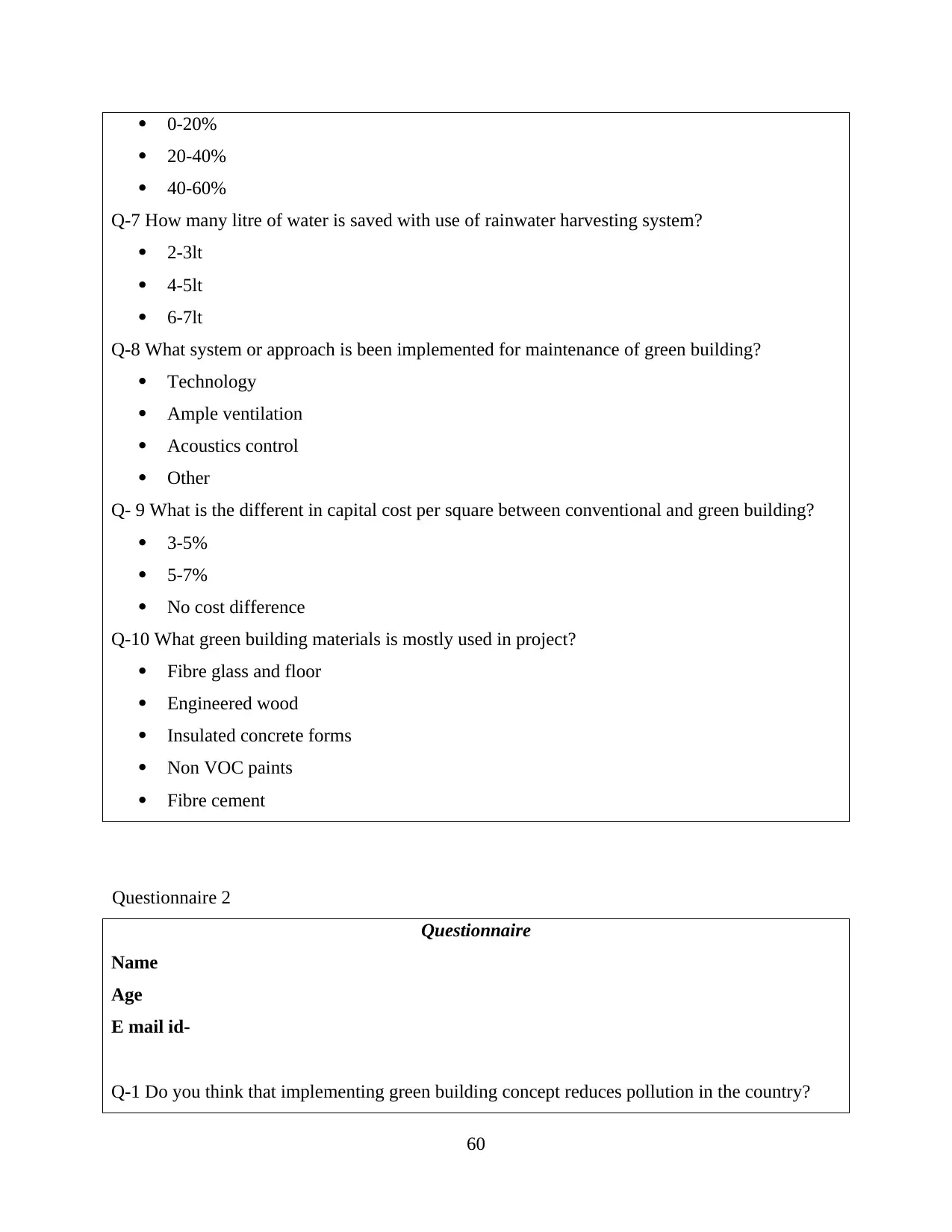
0-20%
20-40%
40-60%
Q-7 How many litre of water is saved with use of rainwater harvesting system?
2-3lt
4-5lt
6-7lt
Q-8 What system or approach is been implemented for maintenance of green building?
Technology
Ample ventilation
Acoustics control
Other
Q- 9 What is the different in capital cost per square between conventional and green building?
3-5%
5-7%
No cost difference
Q-10 What green building materials is mostly used in project?
Fibre glass and floor
Engineered wood
Insulated concrete forms
Non VOC paints
Fibre cement
Questionnaire 2
Questionnaire
Name
Age
E mail id-
Q-1 Do you think that implementing green building concept reduces pollution in the country?
60
20-40%
40-60%
Q-7 How many litre of water is saved with use of rainwater harvesting system?
2-3lt
4-5lt
6-7lt
Q-8 What system or approach is been implemented for maintenance of green building?
Technology
Ample ventilation
Acoustics control
Other
Q- 9 What is the different in capital cost per square between conventional and green building?
3-5%
5-7%
No cost difference
Q-10 What green building materials is mostly used in project?
Fibre glass and floor
Engineered wood
Insulated concrete forms
Non VOC paints
Fibre cement
Questionnaire 2
Questionnaire
Name
Age
E mail id-
Q-1 Do you think that implementing green building concept reduces pollution in the country?
60

Strongly agree
Agree
Neutral
Disagree
Strongly disagree
Q-2 Do you think that green building increases resale value ?
Strongly agree
Agree
Neutral
Disagree
Strongly disagree
Q- 3 Do you think that generating awareness among people is useful in implementing this
concept?
Strongly agree
Agree
Neutral
Disagree
Strongly disagree
Q- 4 Do you know about GRIHA and follow norms in rating building?
Strongly agree
Agree
Neutral
Disagree
Strongly disagree
Q-5 The rating of building can be improved by following practices of LEEDS?
Strongly agree
Agree
Neutral
Disagree
Strongly disagree
Q-6 Projects having rating of 1-2 can be improved by installing green building materials?
61
Agree
Neutral
Disagree
Strongly disagree
Q-2 Do you think that green building increases resale value ?
Strongly agree
Agree
Neutral
Disagree
Strongly disagree
Q- 3 Do you think that generating awareness among people is useful in implementing this
concept?
Strongly agree
Agree
Neutral
Disagree
Strongly disagree
Q- 4 Do you know about GRIHA and follow norms in rating building?
Strongly agree
Agree
Neutral
Disagree
Strongly disagree
Q-5 The rating of building can be improved by following practices of LEEDS?
Strongly agree
Agree
Neutral
Disagree
Strongly disagree
Q-6 Projects having rating of 1-2 can be improved by installing green building materials?
61

Strongly agree
Agree
Neutral
Disagree
Strongly disagree
Q-7 Does rating building under low category benefits in making is more environmental friendly?
Strongly agree
Agree
Neutral
Disagree
Strongly disagree
Q-8 Do you think that GRIHA and LEEDS legislation to support you in design of green
building?
Strongly agree
Agree
Neutral
Disagree
Strongly disagree
Q- 9 Are you satisfied with efforts made by rating agencies in implementing green building
concept?
Strongly agree
Agree
Neutral
Disagree
Strongly disagree
Q-10 Do you consider GRIHA norms to be effective in giving ratings?
Strongly agree
Agree
Neutral
Disagree
Strongly disagree
62
Agree
Neutral
Disagree
Strongly disagree
Q-7 Does rating building under low category benefits in making is more environmental friendly?
Strongly agree
Agree
Neutral
Disagree
Strongly disagree
Q-8 Do you think that GRIHA and LEEDS legislation to support you in design of green
building?
Strongly agree
Agree
Neutral
Disagree
Strongly disagree
Q- 9 Are you satisfied with efforts made by rating agencies in implementing green building
concept?
Strongly agree
Agree
Neutral
Disagree
Strongly disagree
Q-10 Do you consider GRIHA norms to be effective in giving ratings?
Strongly agree
Agree
Neutral
Disagree
Strongly disagree
62
Paraphrase This Document
Need a fresh take? Get an instant paraphrase of this document with our AI Paraphraser
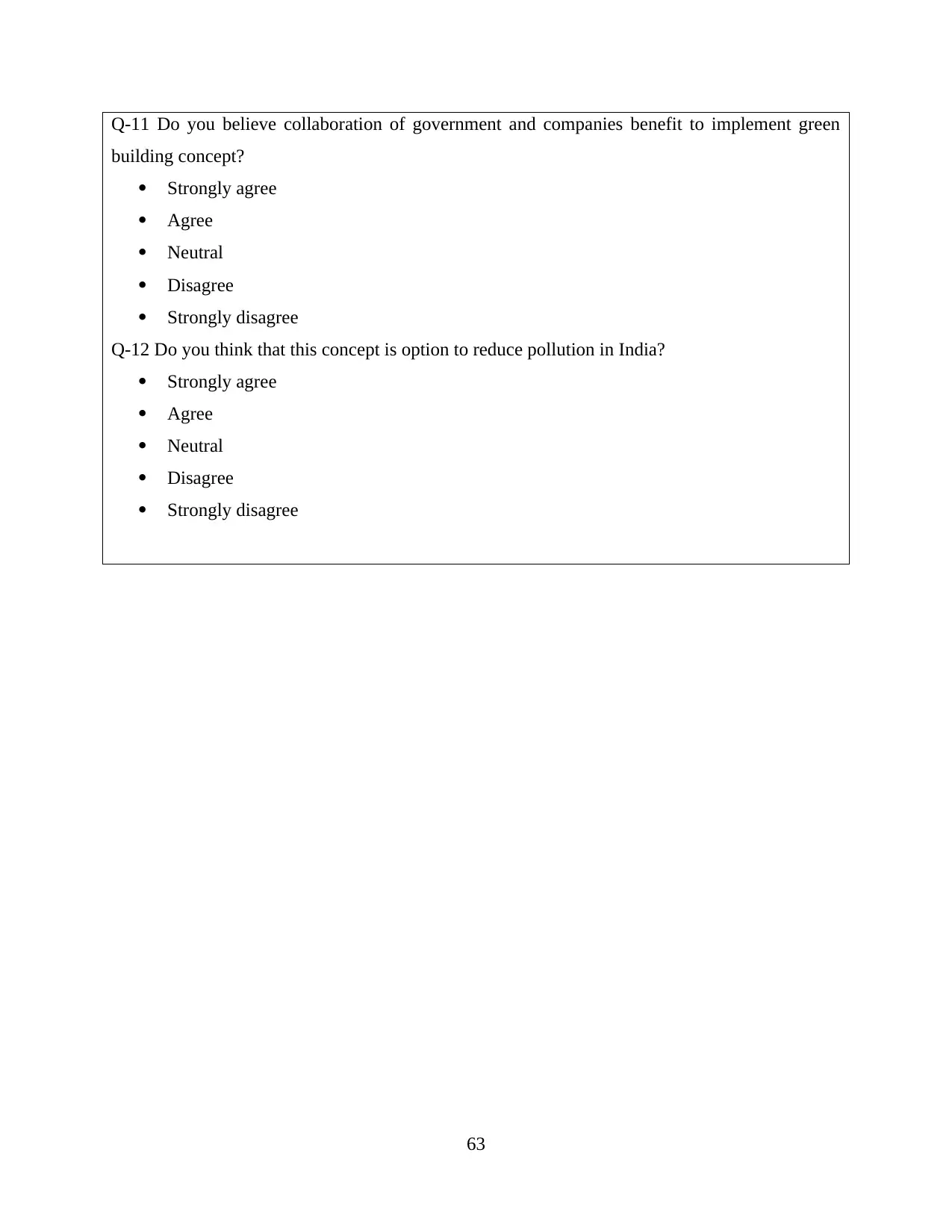
Q-11 Do you believe collaboration of government and companies benefit to implement green
building concept?
Strongly agree
Agree
Neutral
Disagree
Strongly disagree
Q-12 Do you think that this concept is option to reduce pollution in India?
Strongly agree
Agree
Neutral
Disagree
Strongly disagree
63
building concept?
Strongly agree
Agree
Neutral
Disagree
Strongly disagree
Q-12 Do you think that this concept is option to reduce pollution in India?
Strongly agree
Agree
Neutral
Disagree
Strongly disagree
63
1 out of 68
Related Documents
Your All-in-One AI-Powered Toolkit for Academic Success.
+13062052269
info@desklib.com
Available 24*7 on WhatsApp / Email
![[object Object]](/_next/static/media/star-bottom.7253800d.svg)
Unlock your academic potential
© 2024 | Zucol Services PVT LTD | All rights reserved.





